
ZAKOUMA NATIONAL PARK, CHAD, 6 JANUARY 2015: A view of the largest herd of elephants in Zakouma National Park, around 400 elephants all moving towards drinking water close to the headquarters of the park. These herds used to be as large as 1000 animals all moving together, severe poaching over the last decade saw that number decimated and now only around 20% of the number remains. Figures of 4300 elephants in 2002 were reduced to 450 in a 2011 survey. Since 2011 however there has been control over poaching and there has not been a single elephant poached in the last 2 years. The president of Chad, Idris Deby, is a strong supporter of the park and Zakouma is on the upsurge in terms of its elephant population once again. (Photo by Brent Stirton/Reportage for National Geographic Magazine.)

NZARA, SOUTH SUDAN, 17 NOVEMBER 2014: Michael Oryem, 29, is a former Lord's Resistance Army fighter who was involved in the poaching of Ivory in Garamba National Park in the Democratic Republic of Congo, a former base of operations for the LRA and a major source of financing for the notorious group. Oryem was abducted by the group when he was 9 and lived with them for over 17 years in the wild. He was made a commander in the group at the age of 12. The LRA is infamous for the killing and abduction of thousands of civilians across multiple countries. He defected and is now a member of the Ugandan Army, UPDF, African Union force hunting the LRA. he is seen with 2 of six pieces of ivory which he hid and then led the Ugandan forces to inside the border region of the Central African Republic. He claims that the LRA killed many elephants in Garamba and he was ordered by Joseph Kony, the groups notorious leader, to bring the ivory to him in Darfur, South Sudan. Ivory is now a real means of financing for the LRA, it is used for both food and weapons supplies and is traded to the Sudanese Army who transports it north to Khartoum. (Photo by Brent Stirton/Reportage by Getty Images for National Geographic Magazine.)

GARAMBA NATIONAL PARK, DEMOCRACTIC REPUBLIC OF CONGO, 12 NOVEMBER 2014: ICCN Ranger officer Mambo inside the ivory storage locker at Garamba National Park in the DR Congo. This ivory is the prize that notorious rebel group the Lord's Resistance Army, LRA, comes looking for in Garamba. Killing elephants for their ivory is an order direct from the LRA's sociopathic leader Joseph Kony, a man wanted by the International Criminal Court for crimes against Humanity. Rangers in Garamba find themselves up against a heavily armed LRA in their battle to save Garamba's elephant. As pressure has increased on Kony, the LRA has turned to Ivory as one means of sustaining themselves in their decades long bush war against the civilians of Uganda, Congo and the South Sudan/CAR region. (Photo by Brent Stirton/Reportage by Getty Images for National Geographic magazine.)

OBO, CENTRAL AFRICAN REPUBLIC, 23 NOVEMBER 2014: A UPDF Ugandan Army African Union soldier holds a digital copy of a dairy from former Lord's Resistance Army Brigadier General Vincent Binany Okumu. Okumu was in charge of the LRA's ivory hunting campaign and this diary page, written in the Acholi language, details an order from Joseph Kony, the leader of the LRA, for Okumu to bring him 100 tusks. The Lord's Resistance Army has increasingly looked to ivory as a means of trade for weapons and resupply. The ivory is poached in Garamba National Park in the Democratic Republic of Congo and taken by various LRA groups to Kony's location in the border area of Darfur in Sudan. In 2012 Vincent Okumu transported a documented 42 tusks to Darfur from Garamba and recent LRA defectors have repeatedly confirmed that another 52 are in transit to Darfur at this time. Vincent Okumu was killed in a Ugandan Army ambush in Central African Republic in 2013, this diary was recovered and translated, providing conclusive proof of the LRA's increasing reliance on Ivory as a means of financing their terror movement. (Photo by Brent Stirton/Reportage by Getty Images for National Geographic Magazine.)

Border Region Democratic Republic of Congo and Central African Republic, 20 March 2015: Ugandan forensics experts exhume the body of Lt General Okot Odhiambo, number two in command of the Lord's Resistance Army. Odhiambo was long known as Jospeh Kony's enforcer, Kony appointed Odhiambo as the head of his Ivory campaign, a major source of funding for the LRA out of the DRC's Garamba National Park. He was shot and critically wounded by Ugandan forces while returning from an Ivory hunt in the Park. Defectors from his group say he died a few weeks later from his wounds. Odhiambo's death is seen as a significant weakening of the LRA.

OBO, CENTRAL AFRICAN REPUBLIC, 16 NOVEMBER 2014: Laren Poole, operations officer for the Bridgeway Foundation, a foundation dedicated to the end of the Lord's Resistance Army, LRA, the notorious terror organization led by Joseph Kony, airdrops thousands of postcards over the LRA area of C.A.R with a message to the fighters to come home and they will be treated well. Kony and his men have killed and abducted thousands of people over the last 4 decades. (Photo by Brent Stirton/Reportage by Getty Images for National Geographic Magazine.)

GARAMBA NATIONAL PARK, DEMOCRATIC REPUBLIC OF CONGO, 10 NOVEMBER 2014: Long time Africa Parks conservation Ranger Kumboyo Kobango Dieudo Onme, 62, is seen with his son Genekpio inside a damaged store room at the Park HQ for Garamba National Park. On 22 December 2008 Genekpio was abducted by notorious rebel group the Lord's Resistance Army, LRA, from his local village in Nagero, close to the Park. The LRA is notorious for these abductions, taking women and girls as cooks and sex slaves and young men and boys as porters and reinforcement fighters. The LRA took Genekpio and others and moved toward the Central African Republic, South Sudan border area. He saw the LRA attack another two villages in this time, killing multiple innocents and abducting 4 more children. He was also beaten on a daily basis and forced to watch the execution of other abductees as a lesson to the others not to try to escape. After 4 months, this LRA group was attacked by a force from the Ugandan Peoples Defence Force, UPDF. Genekpio was wounded 3 times in the leg in this attack but ultimately was rescued by the UPDF and returned to his family in Nagero. His Ranger father has had regular contacts with the LRA as they poach ivory in Garamba National Park and is still very angry about the abduction of his son. "It is better if they had taken me, I would have died to protect my son. Now I search for LRA on every patrol. If I see them they must die." This is an increasing issue for conservation's protectors as they find they are increasingly not only protecting wild areas and animal but also local populations for rebel groups acting with impunity in their areas. (Photo by Brent Stirton/Reportage by Getty Images for National Geographic Magazine.)

GARAMBA NATIONAL PARK, DEMOCRATIC REPUBLIC OF CONGO, 10 NOVEMBER 2014: Long time Africa Parks conservation Ranger Kumboyo Kobango Dieudo Onme, 62, is seen with his son Genekpio inside a damaged store room at the Park HQ for Garamba National Park. On 22 December 2008 Genekpio was abducted by notorious rebel group the Lord's Resistance Army, LRA, from his local village in Nagero, close to the Park. The LRA is notorious for these abductions, taking women and girls as cooks and sex slaves and young men and boys as porters and reinforcement fighters. The LRA took Genekpio and others and moved toward the Central African Republic, South Sudan border area. He saw the LRA attack another two villages in this time, killing multiple innocents and abducting 4 more children. He was also beaten on a daily basis and forced to watch the execution of other abductees as a lesson to the others not to try to escape. After 4 months, this LRA group was attacked by a force from the Ugandan Peoples Defence Force, UPDF. Genekpio was wounded 3 times in the leg in this attack but ultimately was rescued by the UPDF and returned to his family in Nagero. His Ranger father has had regular contacts with the LRA as they poach ivory in Garamba National Park and is still very angry about the abduction of his son. "It is better if they had taken me, I would have died to protect my son. Now I search for LRA on every patrol. If I see them they must die." This is an increasing issue for conservation's protectors as they find they are increasingly not only protecting wild areas and animal but also local populations for rebel groups acting with impunity in their areas. (Photo by Brent Stirton/Reportage by Getty Images for National Geographic Magazine.)

GARAMBA NATIONAL PARK, DEMOCRACTIC REPUBLIC OF CONGO, 12 NOVEMBER 2014: ICCN Ranger widow Lucienne Alebhako Lanziwa is photographed at her sparse home in Garamba National Park, DR Congo. Lucienne, 41, lost her husband, an officer in the ICCN conservation rangers of Garamba, to a brutal LRA attack on the Ranger HQ on January 2, 2009. The attack occured around 4pm, with the LRA arriving in force and indiscriminately gunning down park personel. Lucienne's husband, Atolobako Vukoyo, was arrested by the LRA while wounded and, along with other abductees, taken to one of their camps a short distance away. The LRA questioned the abductees, repeatedly asking who were the children of Rangers and who were Rangers. They complained bitterly that the Rangers made their poaching work difficult in the park. The LRA took Lucienne's husband to make an example of him. They beat him to death in front of the abductees but tortured him severely first. When the other rangers and UPDF troops were able to find the LRA camp, they found only enough pieces of Lucienne's husband to fit in a small child's coffin. Lucienne was left with five children, including a new born baby and no income. A one off compensation payment of $400 was taken entirely by her husband's family and nothing given to her as his wife and the mother of his 5 children. Only recently have the ICCN spoken to her about a compensation salary of $10 a month. Considering it takes over $100 a year to educate one child, Lucienne has no alternative but a pitiful subsistence existence for her and her children. Lucienne's husband was not the only Ranger killed in the attack. This is only one example of how dangerous it is for so many in the frontline of conservation, an area where more and more Rangers are finding themselves not only combatting subsistence poachers but also heavily armed paramilitary and rebel groups as well as the militaries of various surrounding countries. (Photo by Brent Stirton/Reportage by Getty Images for Nati

GARAMBA NATIONAL PARK, DEMOCRACTIC REPUBLIC OF CONGO, 12 NOVEMBER 2014: Scenes flying over Garamba National Park, DR Congo. The park is a vast area and is difficult terrain to police for a small force of ICCN rangers. The area to the West is the Azzande hunting concession and the preferred route of the LRA into Garamba. There are a number of river crossings and a high number of swamps, all contributing to the difficulty of policing Garamba against a seasoned forced like the LRA, who are used to the bush and toughened by years of living in these conditions. (Photo by Brent Stirton/Reportage by Getty Images for National Geographic magazine.)

GARAMBA NATIONAL PARK, DEMOCRACTIC REPUBLIC OF CONGO, 12 NOVEMBER 2014: ICCN Rangers combine with a Congolese Army platoon for a 21 day mission inside Garamba National Park in the DR Congo. they are on the lookout for poachers, in particular the notorious Lords Resistance Army, the LRA. These poachers are looking for Garamba's elephants. Their ivory is the prize that notorious rebel group the LRA, comes looking for in Garamba. Killing elephants for their ivory is an order direct from the LRA's sociopathic leader Joseph Kony, a man wanted by the International Criminal Court for crimes against Humanity. Rangers in Garamba find themselves up against a heavily armed LRA in their battle to save Garamba's elephant. As pressure has increased on Kony, the LRA has turned to Ivory as one means of sustaining themselves in their decades long bush war against the civilians of Uganda, Congo and the South Sudan/CAR region. (Photo by Brent Stirton/Reportage by Getty Images for National Geographic magazine.)

GARAMBA NATIONAL PARK, DEMOCRACTIC REPUBLIC OF CONGO, 12 NOVEMBER 2014: ICCN Rangers combine with a Congolese Army platoon for a 21 day mission inside Garamba National Park in the DR Congo. they are on the lookout for poachers, in particular the notorious Lords Resistance Army, the LRA. These poachers are looking for Garamba's elephants. Their ivory is the prize that notorious rebel group the LRA, comes looking for in Garamba. Killing elephants for their ivory is an order direct from the LRA's sociopathic leader Joseph Kony, a man wanted by the International Criminal Court for crimes against Humanity. Rangers in Garamba find themselves up against a heavily armed LRA in their battle to save Garamba's elephant. As pressure has increased on Kony, the LRA has turned to Ivory as one means of sustaining themselves in their decades long bush war against the civilians of Uganda, Congo and the South Sudan/CAR region. (Photo by Brent Stirton/Reportage by Getty Images for National Geographic magazine.)

GARAMBA NATIONAL PARK, DEMOCRACTIC REPUBLIC OF CONGO, 12 NOVEMBER 2014: ICCN Rangers combine with a Congolese Army platoon for a 21 day mission inside Garamba National Park in the DR Congo. they are on the lookout for poachers, in particular the notorious Lords Resistance Army, the LRA. These poachers are looking for Garamba's elephants. Their ivory is the prize that notorious rebel group the LRA, comes looking for in Garamba. Killing elephants for their ivory is an order direct from the LRA's sociopathic leader Joseph Kony, a man wanted by the International Criminal Court for crimes against Humanity. Rangers in Garamba find themselves up against a heavily armed LRA in their battle to save Garamba's elephant. As pressure has increased on Kony, the LRA has turned to Ivory as one means of sustaining themselves in their decades long bush war against the civilians of Uganda, Congo and the South Sudan/CAR region. (Photo by Brent Stirton/Reportage by Getty Images for National Geographic magazine.)

OBO, CENTRAL AFRICAN REPUBLIC, 18 NOVEMBER 2014: African Union Ugandan Armed forces, UPDF, train a new battalion at Obo, Central African Republic. The Ugandan contingent as well as the Africom American personel based here are focused on the aprehension of the Lord's Resistance Army, the LRA, the notorious rebel group led by Joseph Kony which has terrorized citizens of Uganda, C.A.R, South Sudan and the Democratic Republic of Congo for the last 4 decades. In recent time the LRA has turned its focus to Ivory as a means of income. This is having a devastating effect on elephant populations everywhere they operate. (Photo by Brent Stirton/Reportage by Getty Images for National Geographic Magazine.)

MBOKI, CENTRAL AFRICAN REPUBLIC, 25 NOVEMBER 2014: Soldiers on patrol from the African Union Ugandan Armed forces, UPDF, base at Mboki, Central African Republic. The Ugandan contingent based here are focused on the aprehension of the Lord's Resistance Army, LRA, the notorious rebel group led by Joseph Kony which has terrorized citizens of Uganda, C.A.R, South Sudan and the Democratic Republic of Congo for the last 4 decades. Soldiers are seen crossing a river, a technique they have perfected with ropes despite the fact that many of the men cannot swim. Captain (Photo by Brent Stirton/Reportage by Getty Images for National Geographic Magazine.)

OBO, CENTRAL AFRICAN REPUBLIC, 18 NOVEMBER 2014: Recent Lord's Resistance Army defector, Michael Onen, photographed at the African Union Ugandan Army base at Obo, Central African Republic. Onen defected after spending 16 years in the LRA after being abducted as a child and taken far from his home village in the DR Congo. The scars on his back are as a result of beatings he received from his LRA captors. He defected on 11 September 2014 as he feared for his life after Joseph Kony, the leader of the LRA, disaproved of a relationship he has with a woman in the LRA. The Ugandan contingent as well as the Africom American personel based here are focused on the apprehension of the Lord's Resistance Army, the notorious rebel group led by Joseph Kony which has terrorized citizens of Uganda, C.A.R, South Sudan and the Democratic Republic of Congo for the last 4 decades. In recent times the LRA has turned its focus to Ivory as a means of income. This is having a devastating effect on elephant populations everywhere they operate. Michael Onen was part of the poaching team operating in Garamba National Park in the Democratic Republic of Congo. In 2012 this team killed 21 elephants, in 2014 they killed 26 elephants in Garamba. These tusks are currently in transit to Darfur, where the notorious leader of the LRA, Joseph Kony has ordered them to be brought. They will be carried by 3 separate groups for security, all moving in different directions. Michael Onen says that once in Darfur, these tusks will be sold to the Sudanese Army and transported to Khartoum from where they will make their way to China. Profits from the ivory will be used by the LRA for arms and resupply. Michael Onen was abducted by the LRA in 1998 while still a child, he was pressed into service by the terror group. He says that Kony lives by instilling fear in his fighters, resocializing children into killers who do his bidding. That bidding now includes the killing of elephants as well as people. (Photo by Bren

OBO, CENTRAL AFRICAN REPUBLIC, 18 NOVEMBER 2014: Recent Lord's Resistance Army defector, Michael Onen, photographed at the African Union Ugandan Army base at Obo, Central African Republic. Onen defected after spending 16 years in the LRA after being abducted as a child and taken far from his home village in the DR Congo. The scars on his back are as a result of beatings he received from his LRA captors. He defected on 11 September 2014 as he feared for his life after Joseph Kony, the leader of the LRA, disaproved of a relationship he has with a woman in the LRA. The Ugandan contingent as well as the Africom American personel based here are focused on the apprehension of the Lord's Resistance Army, the notorious rebel group led by Joseph Kony which has terrorized citizens of Uganda, C.A.R, South Sudan and the Democratic Republic of Congo for the last 4 decades. In recent times the LRA has turned its focus to Ivory as a means of income. This is having a devastating effect on elephant populations everywhere they operate. Michael Onen was part of the poaching team operating in Garamba National Park in the Democratic Republic of Congo. In 2012 this team killed 21 elephants, in 2014 they killed 26 elephants in Garamba. These tusks are currently in transit to Darfur, where the notorious leader of the LRA, Joseph Kony has ordered them to be brought. They will be carried by 3 separate groups for security, all moving in different directions. Michael Onen says that once in Darfur, these tusks will be sold to the Sudanese Army and transported to Khartoum from where they will make their way to China. Profits from the ivory will be used by the LRA for arms and resupply. Michael Onen was abducted by the LRA in 1998 while still a child, he was pressed into service by the terror group. He says that Kony lives by instilling fear in his fighters, resocializing children into killers who do his bidding. That bidding now includes the killing of elephants as well as people. (Photo by Bren

GULU, UGANDA, 21 NOVEMBER 2014: Margret Acino, 32, was attacked by members of the Lord’s Resistance Army when she was 23 and 9 months pregnant. Her lips, ears and nose were cut off and her breasts were hacked by a group of LRA men. Margret and a small group of villagers had gone to the fields for crops when they found themselves surrounded by the infamous rebels. They were taken quickly to an area outside of Gulu where the men accused them of informing on the LRA to the Ugandan Army. Two men and a child were then immediately killed with the hoes they had been carrying for farming. The commander of the rebels accused them again, confronting Margaret and accusing her of being the wife of a soldier. Her husband was in fact a simple farmer. The LRA commander then killed another women in front of her. He said this must be the truth or how could she be so confident in talking with them. He then said he would teach her not to inform ever again. He ordered his men, mostly young teenagers, to produce a razor blade. They hesitated and the commander then threatened his own men, one of them produced a razor blade and they were ordered to cut off Margret’s lips, ears and nose, a practice that was becoming an LRA trademark at the time. When the men were finished, Margret was released and told to run. She passed out from loss of blood shortly thereafter and when she revived she found a man with a bicycle who took her to an IDP. She was in surgery for 2 days, her baby was born via an emergency caesarian and Margret then lapsed into a coma for 5 days. She has had 7 surgeries since to try to repair her ravaged face. The LRA commander who ordered this brutality subsequently defected and was given amnesty. Margaret saw him at a World Vision camp and became hysterical, telling people he was the one behind her tragedy. He was moved from the camp but not prosecuted. Margret has subsequently forgiven him, saying that it is easier to live with things this way. Her husband was less suppo

GULU, UGANDA, 20 NOVEMBER 2014: Caesar Ochelo, former Intelligence chief for the Lord's Resistance Army, LRA, the notorious terror group that has spread chaos amongst the populations of Uganda, DR Congo, Central African Republic and South Sudan since the eighties. Caesar claims he was abducted by the LRA and spent 25 years with them. Most experts agree that he joined voluntarily and he is credited with orchestrating many of the worst attrocities comitted by the LRA. Caesar was captured in 2012 but claims he was thinking of defecting. He now lives in Gulu, scene of many LRA attacks under an amnesty. (Photo by Brent Stirton/Reportage by Getty Images for National Geographic Magazine.)


OBO, CENTRAL AFRICAN REPUBLIC, 16 NOVEMBER 2014: Members of the dog tracking team of the Ugandan Army African Union force at their home made gym at the UPDF encampment in Obo, Central African Republic. The UPDF force is focused on ending the terror campaigns of the notorious Lord's Resistance Army, LRA, the terror organization led by Joseph Kony. Kony and his men have killed and abducted thousands of people across the region over the last 4 decades. (Photo by Brent Stirton/Reportage by Getty Images for National Geographic Magazine.)

OBO, CENTRAL AFRICAN REPUBLIC, 24 NOVEMBER 2014: Scenes from the African Union Ugandan Armed forces, UPDF, base at Obo, Central African Republic. These men pictured are all former LRA soldiers, abductees who were forced to fight for Joseph Kony's terror movement for many years. These men have all defected, from over 3 years ago to as recently as one week ago. Now they fight for the Ugandan Army African Union force alingned against Kony and his LRA movement. The Ugandan contingent as well as the Africom American personel based here are focused on the aprehension of the Lord's Resistance Army, LRA, the notorious rebel group led by Joseph Kony which has terrorized citizens of Uganda, C.A.R, South Sudan and the Democratic Republic of Congo for the last 4 decades. (Photo by Brent Stirton/Reportage by Getty Images for National Geographic Magazine.)

MBOKI, CENTRAL AFRICAN REPUBLIC, 25 NOVEMBER 2014: Soldiers on patrol from the African Union Ugandan Armed forces, UPDF, base at Mboki, Central African Republic. The Ugandan contingent based here are focused on the aprehension of the Lord's Resistance Army, LRA, the notorious rebel group led by Joseph Kony which has terrorized citizens of Uganda, C.A.R, South Sudan and the Democratic Republic of Congo for the last 4 decades. Soldiers are seen crossing a river, a technique they have perfected with ropes despite the fact that many of the men cannot swim. Captain (Photo by Brent Stirton/Reportage by Getty Images for National Geographic Magazine.)

MBOKI, CENTRAL AFRICAN REPUBLIC, 25 NOVEMBER 2014: Soldiers on patrol from the African Union Ugandan Armed forces, UPDF, base at Mboki, Central African Republic. The Ugandan contingent based here are focused on the aprehension of the Lord's Resistance Army, LRA, the notorious rebel group led by Joseph Kony which has terrorized citizens of Uganda, C.A.R, South Sudan and the Democratic Republic of Congo for the last 4 decades. Soldiers are seen crossing a river, a technique they have perfected with ropes despite the fact that many of the men cannot swim. Captain (Photo by Brent Stirton/Reportage by Getty Images for National Geographic Magazine.)

MBOKI, CENTRAL AFRICAN REPUBLIC, 25 NOVEMBER 2014: Soldiers on patrol from the African Union Ugandan Armed forces, UPDF, base at Mboki, Central African Republic. The Ugandan contingent based here are focused on the aprehension of the Lord's Resistance Army, LRA, the notorious rebel group led by Joseph Kony which has terrorized citizens of Uganda, C.A.R, South Sudan and the Democratic Republic of Congo for the last 4 decades. Soldiers are seen crossing a river, a technique they have perfected with ropes despite the fact that many of the men cannot swim. Captain (Photo by Brent Stirton/Reportage by Getty Images for National Geographic Magazine.)

MBOKI, CENTRAL AFRICAN REPUBLIC, 25 NOVEMBER 2014: Soldiers from the African Union Ugandan Armed forces, UPDF, base at Mboki, Central African Republic. The Ugandan contingent based here are focused on the aprehension of the Lord's Resistance Army, LRA, the notorious rebel group led by Joseph Kony which has terrorized citizens of Uganda, C.A.R, South Sudan and the Democratic Republic of Congo for the last 4 decades. (Photo by Brent Stirton/Reportage by Getty Images for National Geographic Magazine.)

MBOKI, CENTRAL AFRICAN REPUBLIC, 25 NOVEMBER 2014: Soldiers from the African Union Ugandan Armed forces, UPDF, base at Mboki, Central African Republic. The Ugandan contingent based here are focused on the aprehension of the Lord's Resistance Army, LRA, the notorious rebel group led by Joseph Kony which has terrorized citizens of Uganda, C.A.R, South Sudan and the Democratic Republic of Congo for the last 4 decades. (Photo by Brent Stirton/Reportage by Getty Images for National Geographic Magazine.)

MBOKI, CENTRAL AFRICAN REPUBLIC, 16 NOVEMBER 2014: Soldiers from the African Union Ugandan Armed forces, UPDF, base at Mboki, Central African Republic. The Ugandan contingent based here are focused on the aprehension of the Lord's Resistance Army, LRA, the notorious rebel group led by Joseph Kony which has terrorized citizens of Uganda, C.A.R, South Sudan and the Democratic Republic of Congo for the last 4 decades. (Photo by Brent Stirton/Reportage by Getty Images for National Geographic Magazine.)

MBOKI, CENTRAL AFRICAN REPUBLIC, 25 NOVEMBER 2014: Soldiers from the African Union Ugandan Armed forces, UPDF, base at Mboki, Central African Republic. The Ugandan contingent based here are focused on the aprehension of the Lord's Resistance Army, LRA, the notorious rebel group led by Joseph Kony which has terrorized citizens of Uganda, C.A.R, South Sudan and the Democratic Republic of Congo for the last 4 decades. (Photo by Brent Stirton/Reportage by Getty Images for National Geographic Magazine.)

MBOKI, CENTRAL AFRICAN REPUBLIC, 25 NOVEMBER 2014: Soldiers from the African Union Ugandan Armed forces, UPDF, base at Mboki, Central African Republic. The Ugandan contingent based here are focused on the aprehension of the Lord's Resistance Army, LRA, the notorious rebel group led by Joseph Kony which has terrorized citizens of Uganda, C.A.R, South Sudan and the Democratic Republic of Congo for the last 4 decades. (Photo by Brent Stirton/Reportage by Getty Images for National Geographic Magazine.)

MBOKI, CENTRAL AFRICAN REPUBLIC, 25 NOVEMBER 2014: Soldiers on patrol from the African Union Ugandan Armed forces, UPDF, base at Mboki, Central African Republic. The Ugandan contingent based here are focused on the aprehension of the Lord's Resistance Army, LRA, the notorious rebel group led by Joseph Kony which has terrorized citizens of Uganda, C.A.R, South Sudan and the Democratic Republic of Congo for the last 4 decades. Soldiers are seen crossing a river, a technique they have perfected with ropes despite the fact that many of the men cannot swim. Captain (Photo by Brent Stirton/Reportage by Getty Images for National Geographic Magazine.)

ZAKOUMA NATIONAL PARK, CHAD, 7 JANUARY 2015: The "Wild Dog" Ranger horse patrol group as it prepares to leave for a week of anti poaching patrol at Zakouma National Park, Chad. The horse patrols are the old guard of Zakouma's rangers and have seen a good deal of conflict in their time in the park. Zakouma lost nearly 75% of its elephants in the decade before 2011 due to raids by Janajaweed and Sudanese poachers, many of them from the Sudanese military. The president of Chad, Idris Deby, is a big supporter of the elephant of Zakouma and of its elephants. The herds here until recently used to be as large as 1000 animals all moving together, severe poaching over the last decade saw that number decimated and now only around 20% of the number remains. Since 2011 however there has been control over poaching and there has not been a single elephant poached in the last 2 years. The president of Chad, Idris Deby, is a strong supporter of the park and Zakouma is on the upsurge in terms of its elephant population once again. (Photo by Brent Stirton/Reportage for National Geographic Magazine.)

ZAKOUMA NATIONAL PARK, CHAD: Rangers from a horse patrol group exhibit their riding skills as they return to base at Zakouma National Park, Chad. The horse patrols are the old guard of Zakouma's rangers and have seen a good deal of conflict in their time in the park. Zakouma lost nearly 75% of its elephants in the decade before 2011 due to raids by Janajaweed and Sudanese poachers, many of them from the Sudanese military. The president of Chad, Idris Deby, is a big supporter of the elephant of Zakouma and of its elephants. The herds here until recently used to be as large as 1000 animals all moving together, severe poaching over the last decade saw that number decimated and now only around 20% of the number remains. Since 2011 however there has been control over poaching and there has not been a single elephant poached in the last 2 years. The credit for that lies with these rangers and the new management of the park.

ZAKOUMA NATIONAL PARK, CHAD, 7 JANUARY 2015: A view of a group from the largest herd of elephants in Zakouma National Park, around 450 elephants in total. These herds used to be as large as 1000 animals all moving together, severe poaching by Sudanese gunmen over the last decade saw that number decimated and now only around 20% of the elephants of Zakouma remain. Since 2011 however there has been control over poaching and there has not been a single elephant poached in the last 2 years. The president of Chad, Idris Deby, is a strong supporter of the park and Zakouma is on the upsurge in terms of its elephant population once again. (Photo by Brent Stirton/Reportage for National Geographic Magazine.)

ZAKOUMA NATIONAL PARK, CHAD, 7 JANUARY 2015:A series of 6 portraits commemorates 6 park rangers killed in an attack on their camp in Heban on 3 September 2012. 6 Rangers died in the attack in total, leaving 48 children fatherless. Their widows believe Zakouma is worth protecting and that the park could play a role for all the surrounding community. They feel the sacrifice of their men was worth it but would feel better if there was some guarantee of protection for their children in the event of death in the course of Ranger duties. (Photo by Brent Stirton/Reportage for National Geographic Magazine.)

ZAKOUMA NATIONAL PARK, CHAD, 6 JANUARY 2015: Djime Said, 50, the lone survivor of the Ranger massacre at Heban, Chad, on the 3rd September 2012. The rangers were killed by poachers who were members of the Sudanese military. They killed the rangers because a few weeks earlier, the Rangers had found their camp and taken all their ammunition, horse and provisions. The attack occured in the very early morning when it was still dark and the Rangers were sleeping. Djime Said was employed as a cook with them in the rainy season. He said there was suddenly heavy firing out of nowhere and he found himself rolling down the steep hill that made up the Ranger post at Heban. He was shot in the buttocks but managed to hide away for the day and then come back to the camp that night where he confirmed all were dead and the camp looted. Said spend the next week trying to get to help, two days of which were spent wading through a dense swamp on his way to aid. He received $2000 compensation from the Chadian government for his injuries. (Photo by Brent Stirton/Reportage for National Geographic Magazine.)

AM TIMAN, CHAD, 13 JANUARY 2015: Mahamat Zene Souleyman, 40, photographed at his home on the outskirts of Am Timan, the nearest town to Zakouma National Park. In December 2012 at the ranger post at Heban, 6 Zakouma Rangers were killed in cold blood as they slept by Sudanese Poachers. The poachers then fled back to the Sudan. Souleyman lost his cousin in the incident and refused to accept that the Sudanese poachers had gotten away with murder. He, along with one other man, walked to the Sudanese border and working with a family member inside a military combined force of Chadian and Sudanese soldiers, managed to identify a member of the poaching gang and have him arrested and brought back to Chad to face charges. The man subsequently escaped, wounding a prison guard in his escape. Souleyman remains bitter about the escape. (Photo by Brent Stirton/Reportage for National Geographic Magazine.)

ZAKOUMA NATIONAL PARK, CHAD, 7 JANUARY 2015: Ranger widow Hawa Oumar photographed inside Zakouma National Park, Chad. Hawa lost her husband in the attack on Heban which occured on 2 September 2012. Hawa has 7 children to care for and works as a farmer and weaver to support them. 6 Rangers died in the attack in total, leaving 48 children in total fatherless. These widows believe Zakouma is worth protecting and that the park could play a role for all the surrounding community. They feel the sacrifice of their men was worth it but would feel better if there was some guarantee of protection for their children in the event of death in the course of Ranger duties. (Photo by Brent Stirton/Reportage for National Geographic Magazine.)

ZAKOUMA NATIONAL PARK, CHAD, 9 JANUARY 2015: Ranger widow Alice Mohammed photographed inside Zakouma National Park, Chad. Hawa lost her husband in the attack on Heban which occured on 2 September 2012. Alice has 8 children to care for and works as a farmer and weaver to support them. 6 Rangers died in the attack in total, leaving 48 children in total fatherless. These widows believe Zakouma is worth protecting and that the park could play a role for all the surrounding community. They feel the sacrifice of their men was worth it but would feel better if there was some guarantee of protection for their children in the event of death in the course of Ranger duties. (Photo by Brent Stirton/Reportage for National Geographic Magazine.)

ZAKOUMA NATIONAL PARK, CHAD, 10 JANUARY 2015: Zakouma Rangers "Mamba Team 1" seen with their vehicle inside the park at the end of a patrol. Driver Issa Idriss Adoum, wearing the brown shirt, lost his Ranger father in an attack which killed 6 Rangers in 2012. Those men were gunned down by Sudanese elephant poachers. Issa's uncle, his fathers brother, alerted a combined Chadian Sudanese border force and went into Sudan to retrieve one of the poachers who was involved in the killings. Issa refused a government pay out for the loss, stating it was a death that needed to be avenged through justice or death. The poacher was imprisoned in Chad but escaped and is rumored to have joined the Seleka, an C.A.R movement with connections to elephant killing. (Photo by Brent Stirton/Reportage for National Geographic Magazine.)

ZAKOUMA NATIONAL PARK, CHAD, 10 JANUARY 2015: Zakouma Rangers "Mamba Team 1" seen inside the park during one of their anti-poaching patrols. Driver Issa Idriss Adoum, wearing the brown shirt, lost his Ranger father in an attack which killed 6 Rangers in 2012. Those men were gunned down by Sudanese elephant poachers. Issa's uncle, his fathers brother, alerted a combined Chadian Sudanese border force and went into Sudan to retrieve one of the poachers who was involved in the killings. Issa refused a government pay out for the loss, stating it was a death that needed to be avenged through justice or death. The poacher was imprisoned in Chad but escaped and is rumored to have joined the Seleka, an C.A.R movement with connections to elephant killing. (Photo by Brent Stirton/Reportage for National Geographic Magazine.)

ZAKOUMA NATIONAL PARK, CHAD, 10 JANUARY 2015: Zakouma Rangers "Mamba Team 1" seen inside the park during one of their anti-poaching patrols. Driver Issa Idriss Adoum, wearing the brown shirt, lost his Ranger father in an attack which killed 6 Rangers in 2012. Those men were gunned down by Sudanese elephant poachers. Issa's uncle, his fathers brother, alerted a combined Chadian Sudanese border force and went into Sudan to retrieve one of the poachers who was involved in the killings. Issa refused a government pay out for the loss, stating it was a death that needed to be avenged through justice or death. The poacher was imprisoned in Chad but escaped and is rumored to have joined the Seleka, an C.A.R movement with connections to elephant killing. (Photo by Brent Stirton/Reportage for National Geographic Magazine.)

ZAKOUMA NATIONAL PARK, CHAD, 10 JANUARY 2015: Zakouma Rangers "Mamba Team 1" seen inside the park during one of their anti-poaching patrols. Driver Issa Idriss Adoum, wearing the brown shirt, lost his Ranger father in an attack which killed 6 Rangers in 2012. Those men were gunned down by Sudanese elephant poachers. Issa's uncle, his fathers brother, alerted a combined Chadian Sudanese border force and went into Sudan to retrieve one of the poachers who was involved in the killings. Issa refused a government pay out for the loss, stating it was a death that needed to be avenged through justice or death. The poacher was imprisoned in Chad but escaped and is rumored to have joined the Seleka, an C.A.R movement with connections to elephant killing. (Photo by Brent Stirton/Reportage for National Geographic Magazine.)

ZAKOUMA NATIONAL PARK, CHAD, 10 JANUARY 2015: Zakouma Rangers "Mamba Team 1" seen inside the park during one of their anti-poaching patrols. Driver Issa Idriss Adoum, wearing the brown shirt, lost his Ranger father in an attack which killed 6 Rangers in 2012. Those men were gunned down by Sudanese elephant poachers. Issa's uncle, his fathers brother, alerted a combined Chadian Sudanese border force and went into Sudan to retrieve one of the poachers who was involved in the killings. Issa refused a government pay out for the loss, stating it was a death that needed to be avenged through justice or death. The poacher was imprisoned in Chad but escaped and is rumored to have joined the Seleka, an C.A.R movement with connections to elephant killing. (Photo by Brent Stirton/Reportage for National Geographic Magazine.)

ZAKOUMA NATIONAL PARK, CHAD, 10 JANUARY 2015: Zakouma Rangers "Mamba Team 1" seen inside the park during one of their anti-poaching patrols. Driver Issa Idriss Adoum, wearing the brown shirt, lost his Ranger father in an attack which killed 6 Rangers in 2012. Those men were gunned down by Sudanese elephant poachers. Issa's uncle, his fathers brother, alerted a combined Chadian Sudanese border force and went into Sudan to retrieve one of the poachers who was involved in the killings. Issa refused a government pay out for the loss, stating it was a death that needed to be avenged through justice or death. The poacher was imprisoned in Chad but escaped and is rumored to have joined the Seleka, an C.A.R movement with connections to elephant killing. (Photo by Brent Stirton/Reportage for National Geographic Magazine.)

NANDUMA, CHAD, 12 JANUARY 2015: Zakouma National Park Rangers interact easily with the men of a Nomad camp close to Zakouma National Park. The Park has developed good relations with the nomads and they share an intelligence network which has helped to prevent poaching. A number of Rangers come from these communities and have close ties. Zakouma is recovering from a ten year period where from 2012 to 2012 they lost 90% of their elephants, almost 4000 elephant. (Photo by Brent Stirton/Reportage for National Geographic Magazine.)

NANDUMA, CHAD, 12 JANUARY 2015: Zakouma National Park Rangers interact easily with the men of a Nomad camp close to Zakouma National Park. The Park has developed good relations with the nomads and they share an intelligence network which has helped to prevent poaching. A number of Rangers come from these communities and have close ties. Zakouma is recovering from a ten year period where from 2012 to 2012 they lost 90% of their elephants, almost 4000 elephant. (Photo by Brent Stirton/Reportage for National Geographic Magazine.)

BOUBA NDJIDA NATIONAL PARK, NORTH CAMEROON, APRIL 2012: The largest mass killing of elephants in recent history took place at Bouba Ndjida National Park in North Cameroon close to the Chad and Central African Republic Borders from January through March 2012. Eye witnesses have so far located 340 carcasses, the ivory poachers themselves told local villagers they have killed over 650 elephants in their hunt for Ivory over the 500 000 hectare region. There has yet to be a proper aerial and ground survey of the dead elephants and the rainy season will make that difficult. The Poachers, numbering over 100 men, were mounted on horseback, led by 6 light skinned North Sudanese men and armed with RPG's, grenades, Light Machine Guns and AK47's. They were in two main groups, with a number of reconnaisance units of 4 men locating the elephants then bringing in a larger force to kill big groups. Intelligence indicates that many of the hunters came from Chad and were led by these Sudanese men. These facts have emerged from a number of eye witness acccounts, mainly by French professional hunters who saw the horsman in the Park and local hunting concessions. They had the appearence and attitude of Janjaweed fighters from the South Sudan Darfur and Chadian conflicts and were disciplined, unafraid, arrogant and extremely efficient hunters. The elephants were herded together by teams of 4 to 8 riders who then decimated them with AK47 fire, killing all the elephants they could find, including babies with no ivory. Groups as large as 53 have been gunned down together, with sections as large as 14 elephants lying within touching distance of each other. These horseman came into the area over the Chadian border, evidence of early carcasses suggests that they may have been in the park as early as October 2011. The main force began their hunt in earnest from January through to approximately 8 March 2012. It is believed there was collaboration with local poachers in this hunt as well as an as

BOUBA NDJIDA NATIONAL PARK, NORTH CAMEROON, APRIL 2012: The largest mass killing of elephants in recent history took place at Bouba Ndjida National Park in North Cameroon close to the Chad and Central African Republic Borders from January through March 2012. Eye witnesses have so far located 340 carcasses, the ivory poachers themselves told local villagers they have killed over 650 elephants in their hunt for Ivory over the 500 000 hectare region. There has yet to be a proper aerial and ground survey of the dead elephants and the rainy season will make that difficult. The Poachers, numbering over 100 men, were mounted on horseback, led by 6 light skinned North Sudanese men and armed with RPG's, grenades, Light Machine Guns and AK47's. They were in two main groups, with a number of reconnaisance units of 4 men locating the elephants then bringing in a larger force to kill big groups. Intelligence indicates that many of the hunters came from Chad and were led by these Sudanese men. These facts have emerged from a number of eye witness acccounts, mainly by French professional hunters who saw the horsman in the Park and local hunting concessions. They had the appearence and attitude of Janjaweed fighters from the South Sudan Darfur and Chadian conflicts and were disciplined, unafraid, arrogant and extremely efficient hunters. The elephants were herded together by teams of 4 to 8 riders who then decimated them with AK47 fire, killing all the elephants they could find, including babies with no ivory. Groups as large as 53 have been gunned down together, with sections as large as 14 elephants lying within touching distance of each other. These horseman came into the area over the Chadian border, evidence of early carcasses suggests that they may have been in the park as early as October 2011. The main force began their hunt in earnest from January through to approximately 8 March 2012. It is believed there was collaboration with local poachers in this hunt as well as an as

BOUBA NDJIDA NATIONAL PARK, NORTH CAMEROON, APRIL 2012: The largest mass killing of elephants in recent history took place at Bouba Ndjida National Park in North Cameroon close to the Chad and Central African Republic Borders from January through March 2012. Eye witnesses have so far located 340 carcasses, the ivory poachers themselves told local villagers they have killed over 650 elephants in their hunt for Ivory over the 500 000 hectare region. There has yet to be a proper aerial and ground survey of the dead elephants and the rainy season will make that difficult. The Poachers, numbering over 100 men, were mounted on horseback, led by 6 light skinned North Sudanese men and armed with RPG's, grenades, Light Machine Guns and AK47's. They were in two main groups, with a number of reconnaisance units of 4 men locating the elephants then bringing in a larger force to kill big groups. Intelligence indicates that many of the hunters came from Chad and were led by these Sudanese men. These facts have emerged from a number of eye witness acccounts, mainly by French professional hunters who saw the horsman in the Park and local hunting concessions. They had the appearence and attitude of Janjaweed fighters from the South Sudan Darfur and Chadian conflicts and were disciplined, unafraid, arrogant and extremely efficient hunters. The elephants were herded together by teams of 4 to 8 riders who then decimated them with AK47 fire, killing all the elephants they could find, including babies with no ivory. Groups as large as 53 have been gunned down together, with sections as large as 14 elephants lying within touching distance of each other. These horseman came into the area over the Chadian border, evidence of early carcasses suggests that they may have been in the park as early as October 2011. The main force began their hunt in earnest from January through to approximately 8 March 2012. It is believed there was collaboration with local poachers in this hunt as well as an as

CHONDO, VIRUNGA NATIONAL PARK, DEMOCRATIC REPUBLIC OF CONGO: Rodrigue Katembo, Central Section Warden, Virunga National Park, leads a combined team of ICCN Congolese conservation rangers and members of the Congolese army on an patrol into an area with a strong FDLR rebel presence, Chondo, Virunga, DRC. The FDLR are led by the hardcore Hutu's behind the Rwandan massacre of 1994. Since they fled into the DRC and the park after the Genocide, they have sown mayhem and destruction in Virunga. 160 Rangers have died defending Virunga since 1994, many at the hands of the FDLR rebels. There are regular contacts between the Rangers and FDLR, usually resulting in injuries and deaths on either side. Virunga remains one of the most dangerous places in the world to practise conservation.

LULIMBI, EASTERN DRC, FEBRUARY 2012: ICCN Rangers investigate the corpse of a recently killed sub-adult male elephant in Lulimbi, Eastern DRC, February 29, 2012. The elephant has obviously been killed for its ivory, a trend on the rise across the DRC and one which makes the Rangers job very difficult. (Photo by Brent Stirton/Reportage for Geo magazine.)

LULIMBI, EASTERN DRC, FEBRUARY 2012: ICCN Rangers investigate the corpse of a recently killed sub-adult male elephant in Lulimbi, Eastern DRC, February 29, 2012. The elephant has obviously been killed for its ivory, a trend on the rise across the DRC and one which makes the Rangers job very difficult. (Photo by Brent Stirton/Reportage for Geo magazine.)

LULIMBI, EASTERN DEMOCRATIC REPUBLIC OF CONGO, 23 JULY 2014: ICCN Conservation Rangers investigate and then deploy bloodhounds in Virunga National Park to investigate the corpse of a elephant killed in the night, Eastern DRC. The elephant had obviously been killed for its ivory, a trend on the rise across the DRC and one which makes the Rangers job very difficult. It is believed that this elephant was killed by FDLR, the Hutu genocidaires who fled into Virunga after the Rwandan genocide. They have been exploiting the park ever since, often in co-operation with the Congolese Army. (Photo by Brent Stirton/Reportage.)

VIRUNGA NATIONAL PARK, DEMOCRATIC REPUBLIC OF CONGO, JANUARY 18 2015: Innocent Mburanumwe, 43, a veteran ICCN Congolese conservation authority ranger. Innocent is a globally acknowledged mountain gorilla expert and is seen inside the ammunition locker at the park headquarters of Rumangabo. He is surrounded by Ivory taken in clashes with rebel Hutu led group, the FDLR. FDLR came into being after the Rwandan genocide when the hardcore Hutu genicodaires fled into Virunga fleeing reprisals from Kagame's RPF forces. FDLR's presence has destabilized the area ever since as they prey on the park and its surrounding communities. Their presence has also seen a number of attack by Rwandan forces since 1994 as well as two proxy rebel groups, CNDP and M23, both with Rwandan patronage. FDLR have been linked to Ivory poaching inside Virunga on a number of occasions, working in collaboration with FARDC, the Congolese army and using the funds to sustain their existence inside Virunga. A large number of ICCN rangers have died in clashes with the FDLR. (Photo by Brent Stirton/Reportage for National Geographic Magazine.)

ISHANGO RANGER STATION, NORTHERN SECTOR, VIRUNGA NATIONAL PARK, NORTH KIVU, DEMOCRATIC REPUBLIC OF CONGO-27 FEBRUARY 2008: ICCN Ranger Kambale Kalibumba was killed by a suspected FDLR rebel soldier who shot the Ranger 5 times at close range. At the time the Ranger was in the park on the way to the Ishango post with rations for the patrol. Now in 2015 both of the other rangers in this image are also dead, killed in their duties defending the park. More than 160 rangers have died in the last ten years as a result of their work in Virunga National Park, many at the hands of the FDLR, the Rwandan Hutu genocidaires who fled into Virunga after the Rwandan Genocide and who have spread havoc in their exploitations of the park ever since. The FDLR have a long history of killing elephants in Virunga in pursuit fo ivory to finance their campaign. They do this in collusions with elements of the Congolese army, also a fixture in the park and a problem for conservation. (Photo by Brent Stirton/Reportage for National Geographic Magazine.)

SARAMBE, EASTERN CONGO, 21 JULY 2014: People grieve over the death of a deputy ranger who was killed for trying to prevent illegal agriculture inside Virunga National Park, Eastern DR Congo. It is suspected that he was shot by FDLR members, the Hutu rebel group who has been living inside and exploiting Virunga NP since 1994. FDLR control certain sections of Virunga and conduct illegal agricultural activities which devastate the environment for the animals. This man's widow will be looked after as part of a ICCN rangers plan which attempts to provide support for widows of men who died in service of the park. 190 men have been killed in their duties in the last 15 years. (Photo by Brent Stirton/Reportage. )

SARAMBE, EASTERN CONGO, 21 JULY 2014: People grieve over the death of a deputy ranger who was killed for trying to prevent illegal agriculture inside Virunga National Park, Eastern DR Congo. It is suspected that he was shot by FDLR members, the Hutu rebel group who has been living inside and exploiting Virunga NP since 1994. FDLR control certain sections of Virunga and conduct illegal agricultural activities which devastate the environment for the animals. This man's widow will be looked after as part of a ICCN rangers plan which attempts to provide support for widows of men who died in service of the park. 190 men have been killed in their duties in the last 15 years. (Photo by Brent Stirton/Reportage. )

SARAMBE, EASTERN CONGO, 21 JULY 2014: People grieve over the death of a deputy ranger who was killed for trying to prevent illegal agriculture inside Virunga National Park, Eastern DR Congo. It is suspected that he was shot by FDLR members, the Hutu rebel group who has been living inside and exploiting Virunga NP since 1994. FDLR control certain sections of Virunga and conduct illegal agricultural activities which devastate the environment for the animals. This man's widow will be looked after as part of a ICCN rangers plan which attempts to provide support for widows of men who died in service of the park. 190 men have been killed in their duties in the last 15 years. (Photo by Brent Stirton/Reportage. )

RUMANGABO, NORTH KIVU, DEMOCRATIC REPUBLIC OF CONGO-JULY 2014: ICCN Director of Virunga National Park Emmanuel De Merode photographed with bodyguards at Rumangabo Ranger Headquarters, North Kivu, Democratic Republic of Congo. De Merode has been an outspoken opponent of oil exploration inside Virunga, a world heritage site. De Merode's bodyguards are a new feature in his life. He was shot two months ago 4 times by unknown men in what is assumed to be a political assasination attempt as a result of his vocal, global opposition to oil exploitation. De Merode was back inside the park 4 weeks after his shooting, reaffirming his stance and support for the 500 Rangers under his command. (Photo by Brent Stirton/Getty Images.)

CHINKO, CENTRAL AFRICAN REPUBLIC, MARCH 2015: New Rangers train to protect elephants in Chinko, a remote last haven for forest elephants in CAR. These rangers are up against experienced Sudanese poachers as well as local Seleka fighters who prey up on the elephants to finance their rebellion within CAR. The rangers are struggling to get weapons because of a UN weapons embargo which makes fighting Seleka and the Sudanese impossible for now. (Photo by Brent Stirton/Reportage by Getty Images.)

LOME', TOGO, 29 JANUARY 2014: Containers with 4 tons of illegal ivory confiscated in January 2014 by the Togolese customs office from its new deep water port, Lome,' Togo. This ivory has been directly linked through DNA evidence to the elephant massacre that occured in Dzanga Bai, Central African Republic in 2013. That massacre was perpetrated by Seleka rebels who climbed the observation towers at the famous forest elephant gathering place in Dzanga Bai and gunned down the elephants with automatic weapons. The Seleka rebels would have used the proceeds from this ivory sale for some of the violence which has plagued C.A.R over much of 2013 and 2014. Togo has been viewed as a new opportunity by ivory smugglers with its new deep water port. Customs officers with new Container scanning technology have made the efforts of these smugglers more difficult. (Photo by Brent Stirton/Reportage by Getty Images for National Geographic Magazine.)

LOME', TOGO, 29 JANUARY 2014: Containers with 4 tons of illegal ivory confiscated in January 2014 by the Togolese customs office from its new deep water port, Lome,' Togo. This ivory has been directly linked through DNA evidence to the elephant massacre that occured in Dzanga Bai, Central African Republic in 2013. That massacre was perpetrated by Seleka rebels who climbed the observation towers at the famous forest elephant gathering place in Dzanga Bai and gunned down the elephants with automatic weapons. The Seleka rebels would have used the proceeds from this ivory sale for some of the violence which has plagued C.A.R over much of 2013 and 2014. Togo has been viewed as a new opportunity by ivory smugglers with its new deep water port. Customs officers with new Container scanning technology have made the efforts of these smugglers more difficult. (Photo by Brent Stirton/Reportage by Getty Images for National Geographic Magazine.)

LOME', TOGO, 29 JANUARY 2014: Containers with 4 tons of illegal ivory confiscated in January 2014 by the Togolese customs office from its new deep water port, Lome,' Togo. This ivory has been directly linked through DNA evidence to the elephant massacre that occured in Dzanga Bai, Central African Republic in 2013. That massacre was perpetrated by Seleka rebels who climbed the observation towers at the famous forest elephant gathering place in Dzanga Bai and gunned down the elephants with automatic weapons. The Seleka rebels would have used the proceeds from this ivory sale for some of the violence which has plagued C.A.R over much of 2013 and 2014. Togo has been viewed as a new opportunity by ivory smugglers with its new deep water port. Customs officers with new Container scanning technology have made the efforts of these smugglers more difficult. (Photo by Brent Stirton/Reportage by Getty Images for National Geographic Magazine.)

LOME', TOGO, 29 JANUARY 2014: Lieutenant AWI Essossimna, Chef de l'Unité Mixte de Contrôle des Conteneurs, Port Autonome de Lomé, is seen with containers with 4 tons of illegal ivory he confiscated in January 2014. This ivory has been directly linked through DNA evidence to the elephant massacre that occured in Dzanga Bai, Central African Republic in 2013. That massacre was perpetrated by Seleka rebels who climbed the observation towers at the famous forest elephant gathering place in Dzanga Bai and gunned down the elephants with automatic weapons. The Seleka rebels would have used the proceeds from this ivory sale for some of the violence which has plagued C.A.R over much of 2013 and 2014. Togo has been viewed as a new opportunity by ivory smugglers with its new deep water port. Customs officers with new Container scanning technology have made the efforts of these smugglers more difficult. (Photo by Brent Stirton/Reportage by Getty Images for National Geographic Magazine.)

LOME', TOGO, 29 JANUARY 2014: Containers with 4 tons of illegal ivory confiscated in January 2014 by the Togolese customs office from its new deep water port, Lome,' Togo. This ivory has been directly linked through DNA evidence to the elephant massacre that occured in Dzanga Bai, Central African Republic in 2013. That massacre was perpetrated by Seleka rebels who climbed the observation towers at the famous forest elephant gathering place in Dzanga Bai and gunned down the elephants with automatic weapons. The Seleka rebels would have used the proceeds from this ivory sale for some of the violence which has plagued C.A.R over much of 2013 and 2014. Togo has been viewed as a new opportunity by ivory smugglers with its new deep water port. Customs officers with new Container scanning technology have made the efforts of these smugglers more difficult. (Photo by Brent Stirton/Reportage by Getty Images for National Geographic Magazine.)

LOME', TOGO, 29 JANUARY 2014: Togolese Gendarme operate a shipping container scanning truck inside the new deep water port in Lome'. Togo has been viewed as a new opportunity by ivory smugglers with its new deep water port. Customs officers with new container scanning technology have made the efforts of these smugglers more difficult, confiscating one of the largest ivory shipments ever seized in January 2014. Over 4 tons of ivory was found in a container labeled as wood. DNA evidence has since linked the ivory to a massacre comitted by Seleka rebels in Central African Republic in a famous elephant gathering place in the forest. The rebels climbed onto the viewing platforms and gunned down the elephants with automatic weapons. They will have used the profits to enhance their campaign of violence across C.A.R in 2014. (Photo by Brent Stirton/Reportage by Getty Images for National Geographic Magazine.)

GUANGZHOU, CHINA, FEBRUARY 2012: The majority of ivory makes its way to China, by far the largest consumer on earth. In this image ivory carver Wu Rong Chang, 67, who has been carving for 50 years, is seen working on a large Ivory carving at the Guangzhou Daxin Ivory Carving Factory, a state owned enterprise specialising in the ivory carving businessin the People's Republic of China, Guangzhou, February 4 2012. Daxin specialising in the Hollow Ball carving of 25 layers, large landscape ivory hillocks and also works with Mamoth Ivory. (Photo by Brent Stirton/Reportage for National Geographic Magazine.)


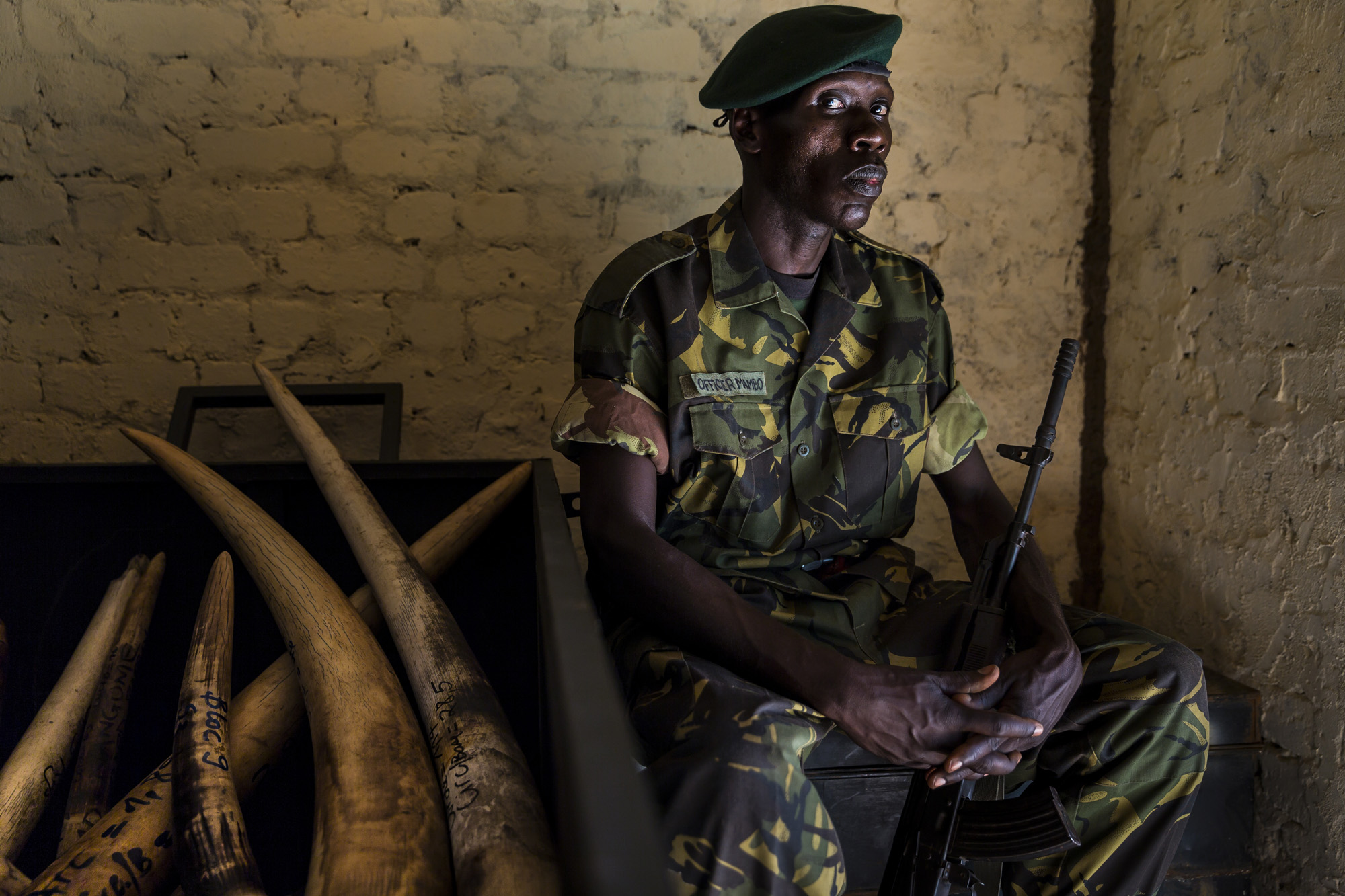
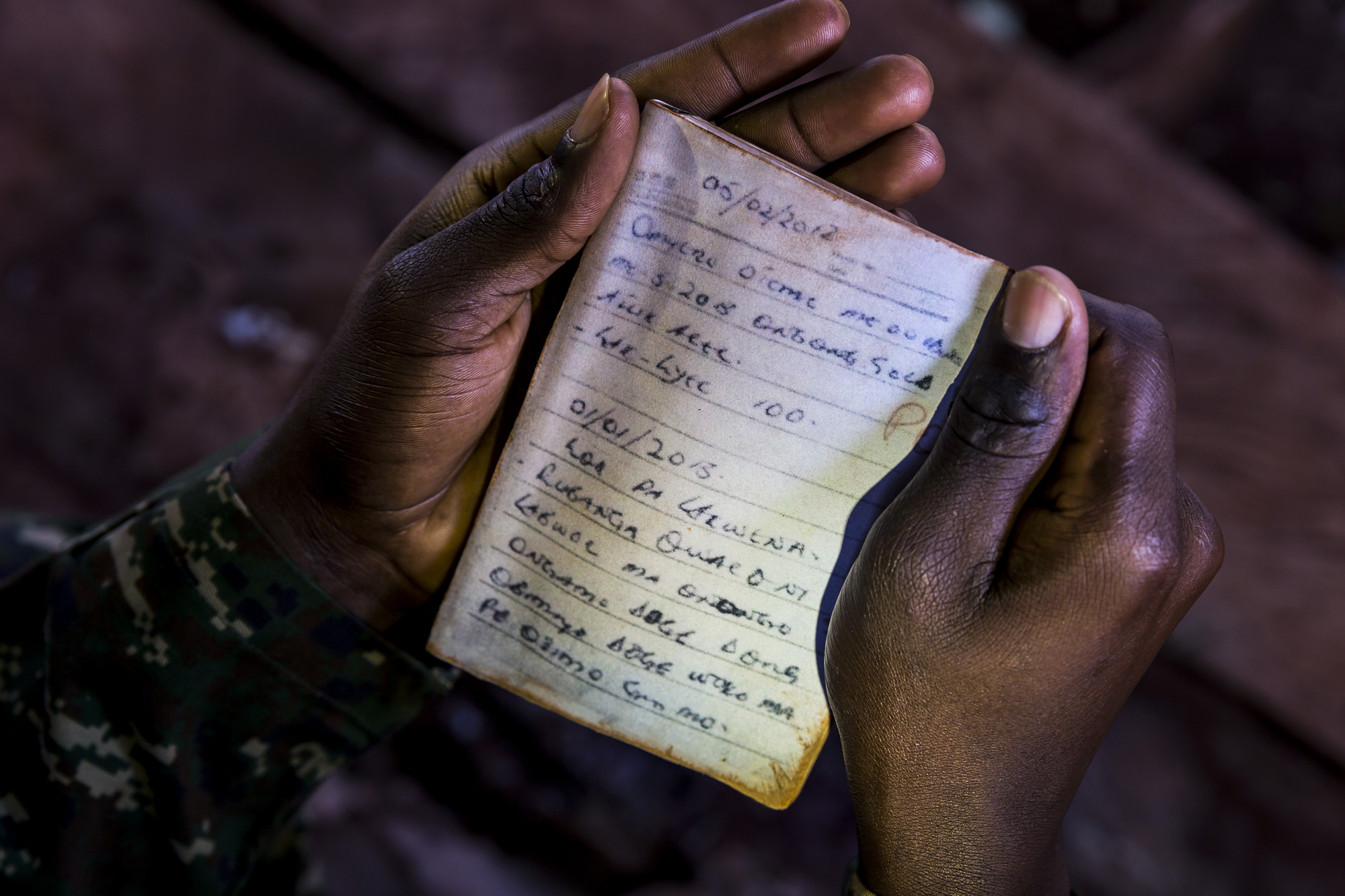
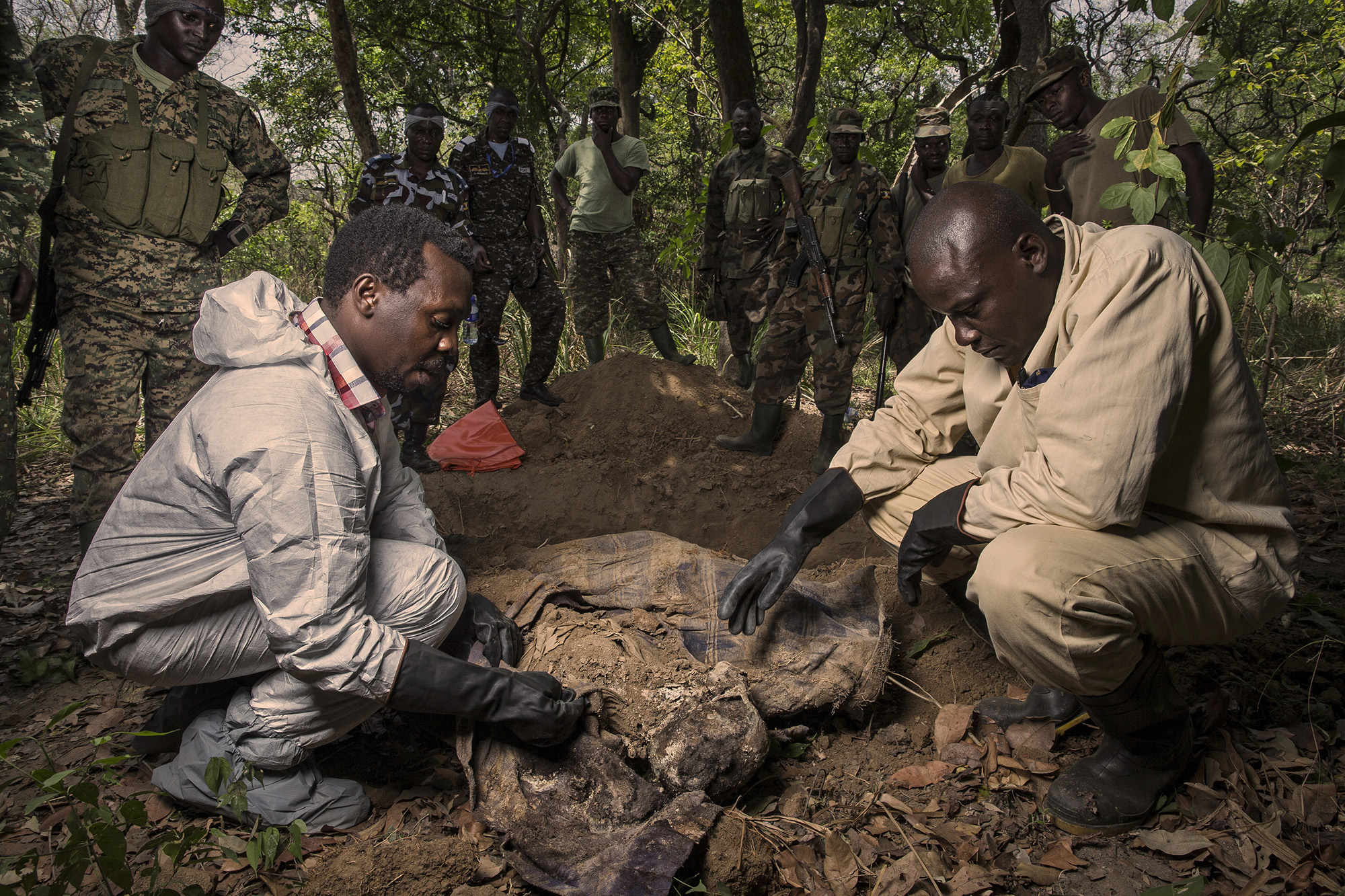

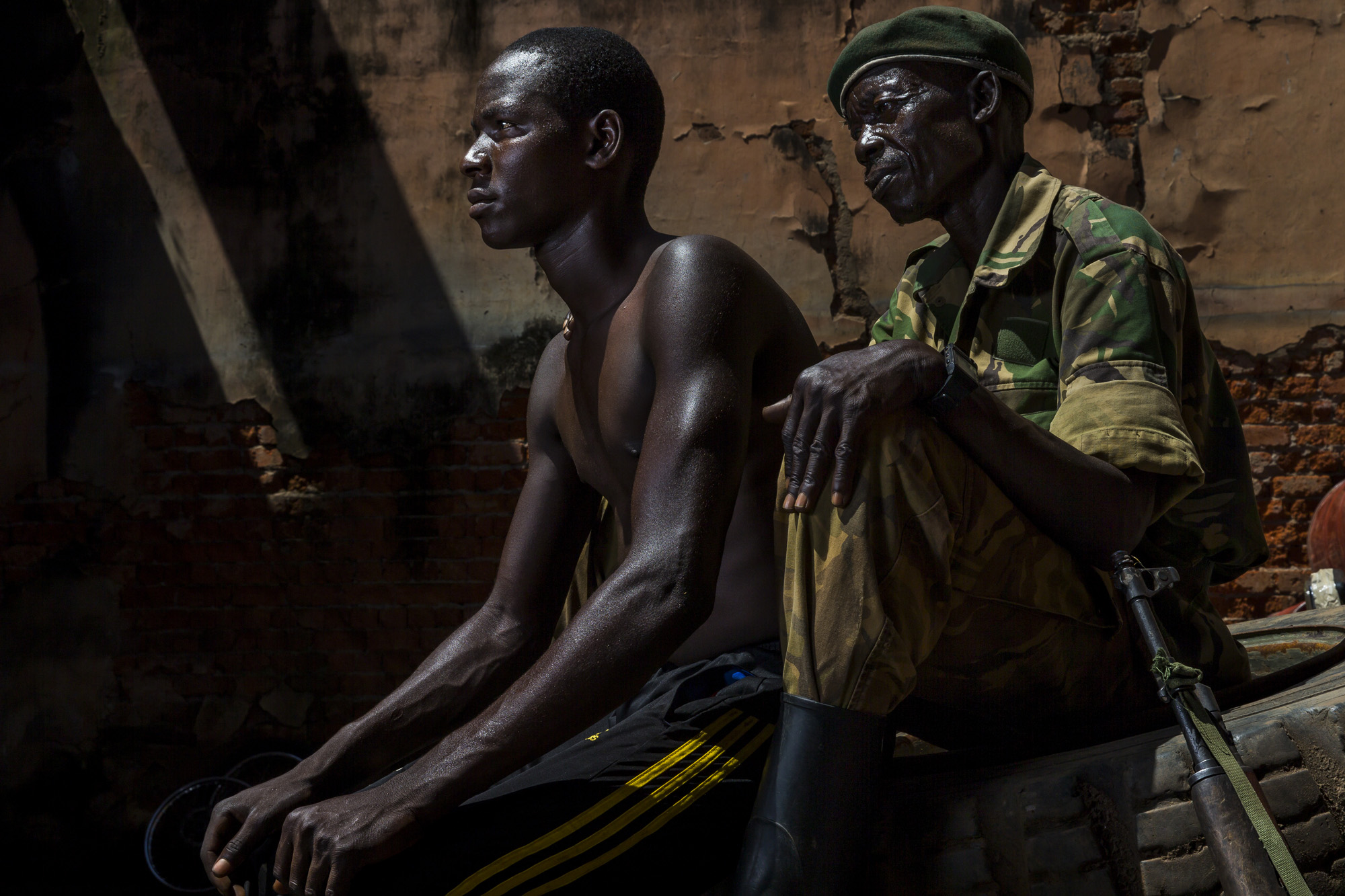
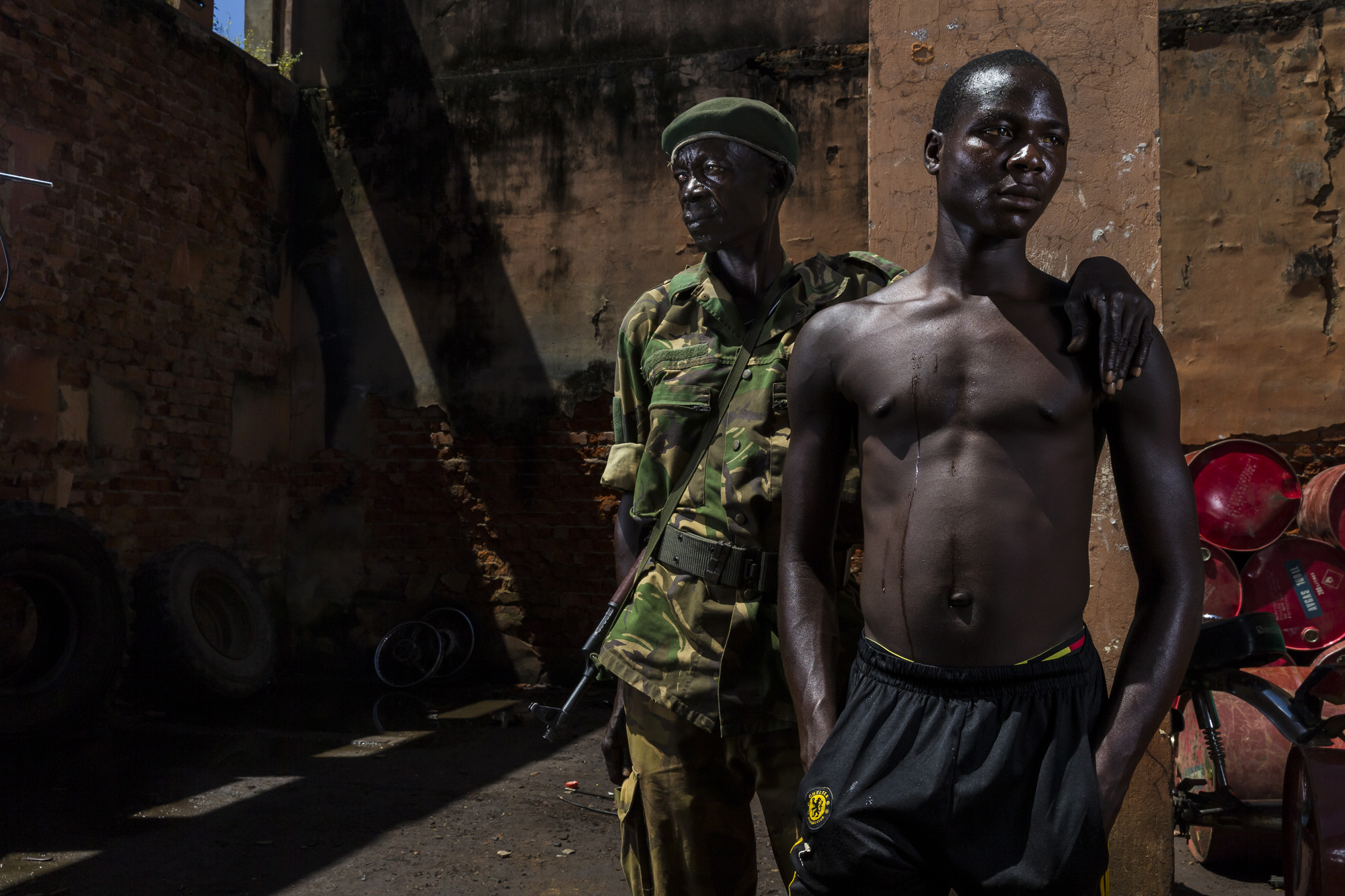
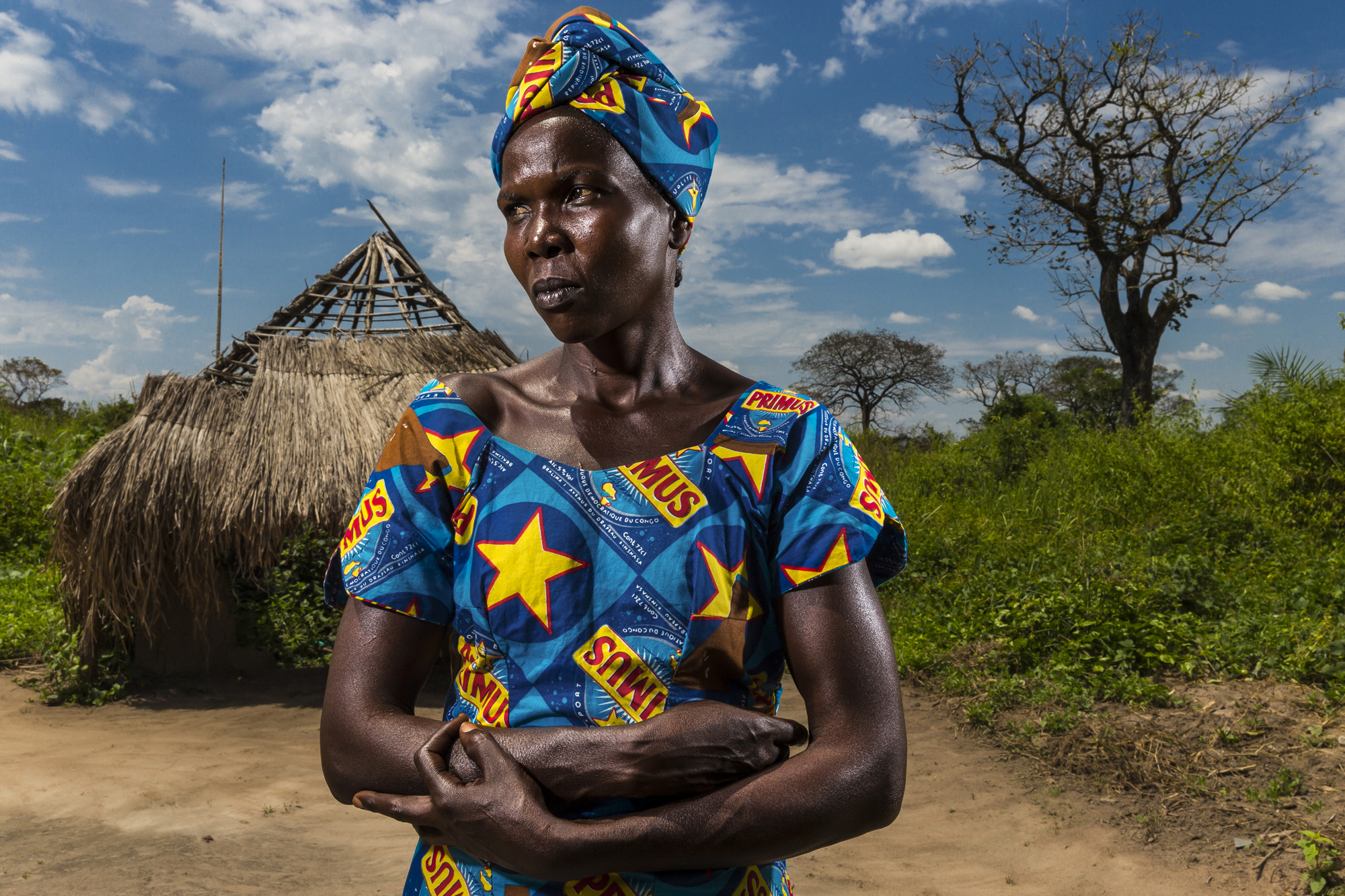
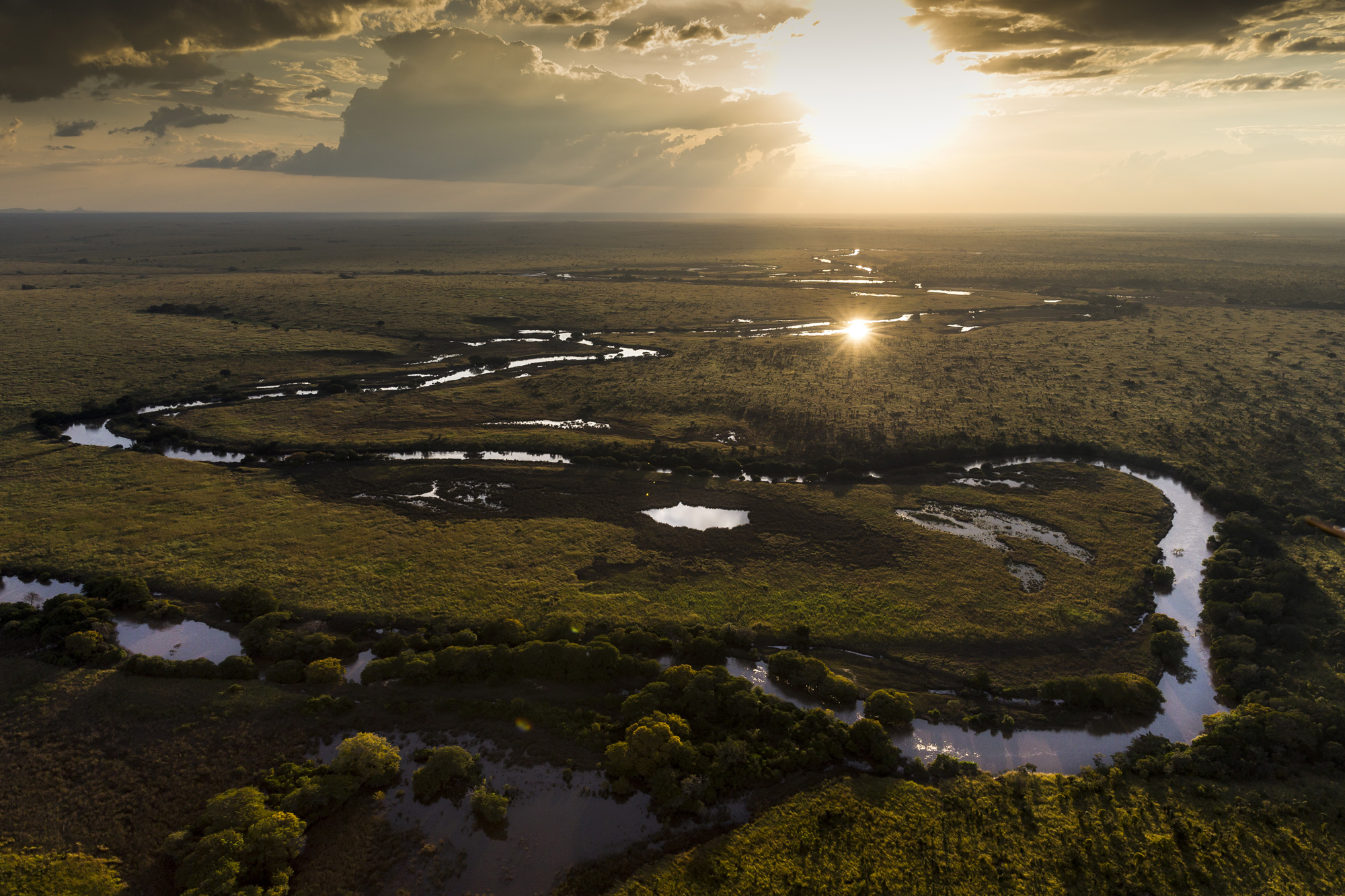
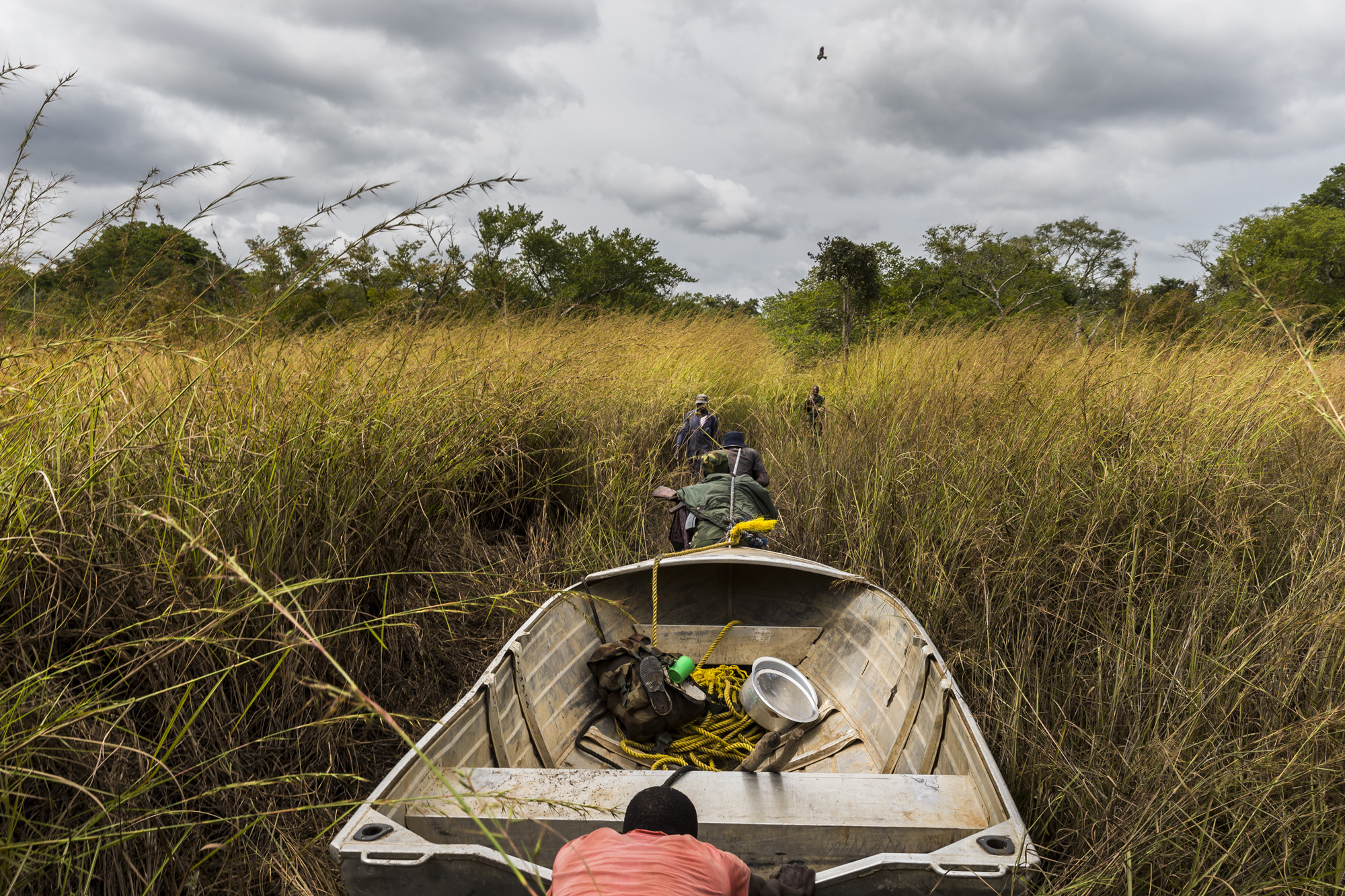
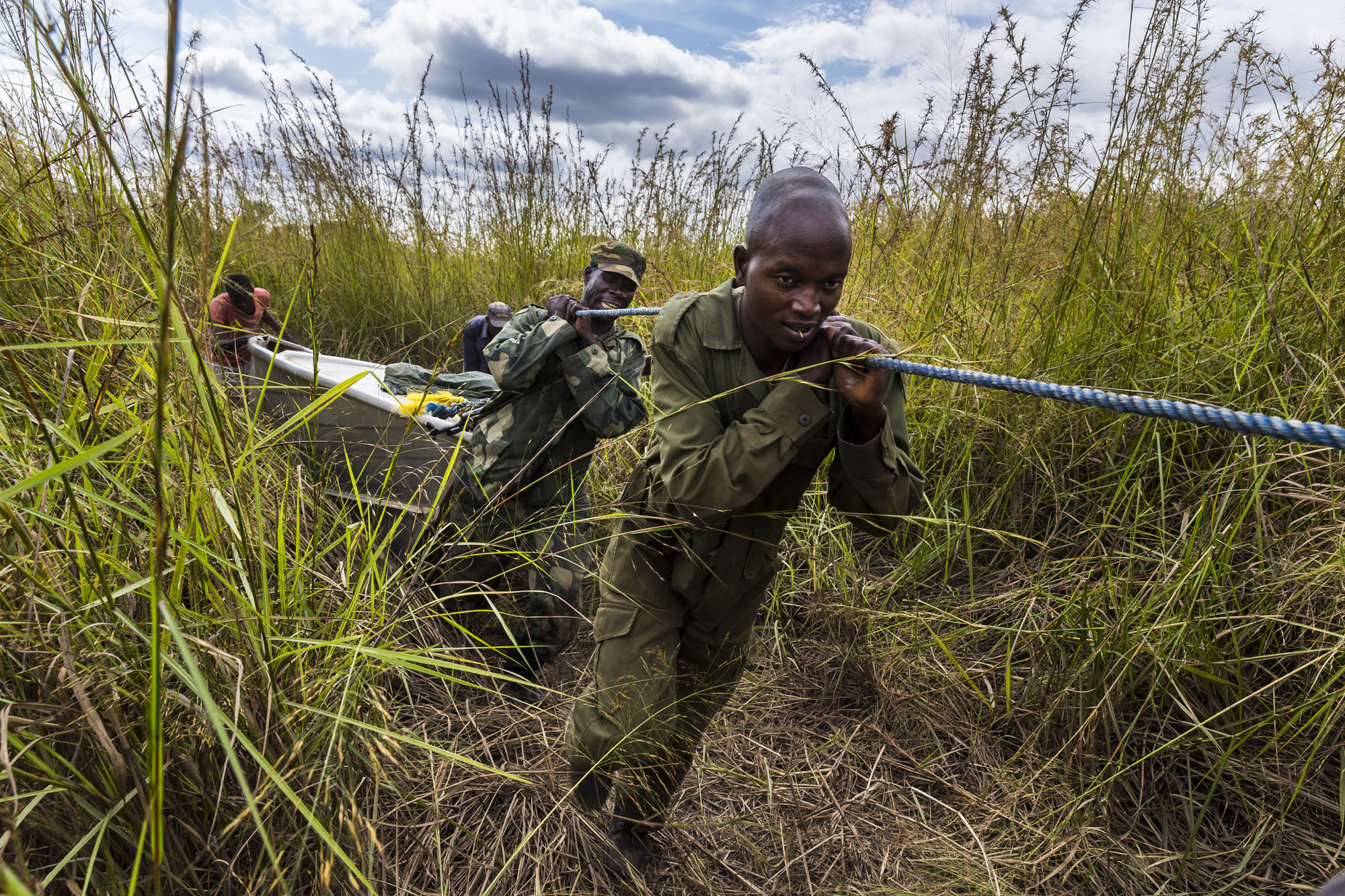
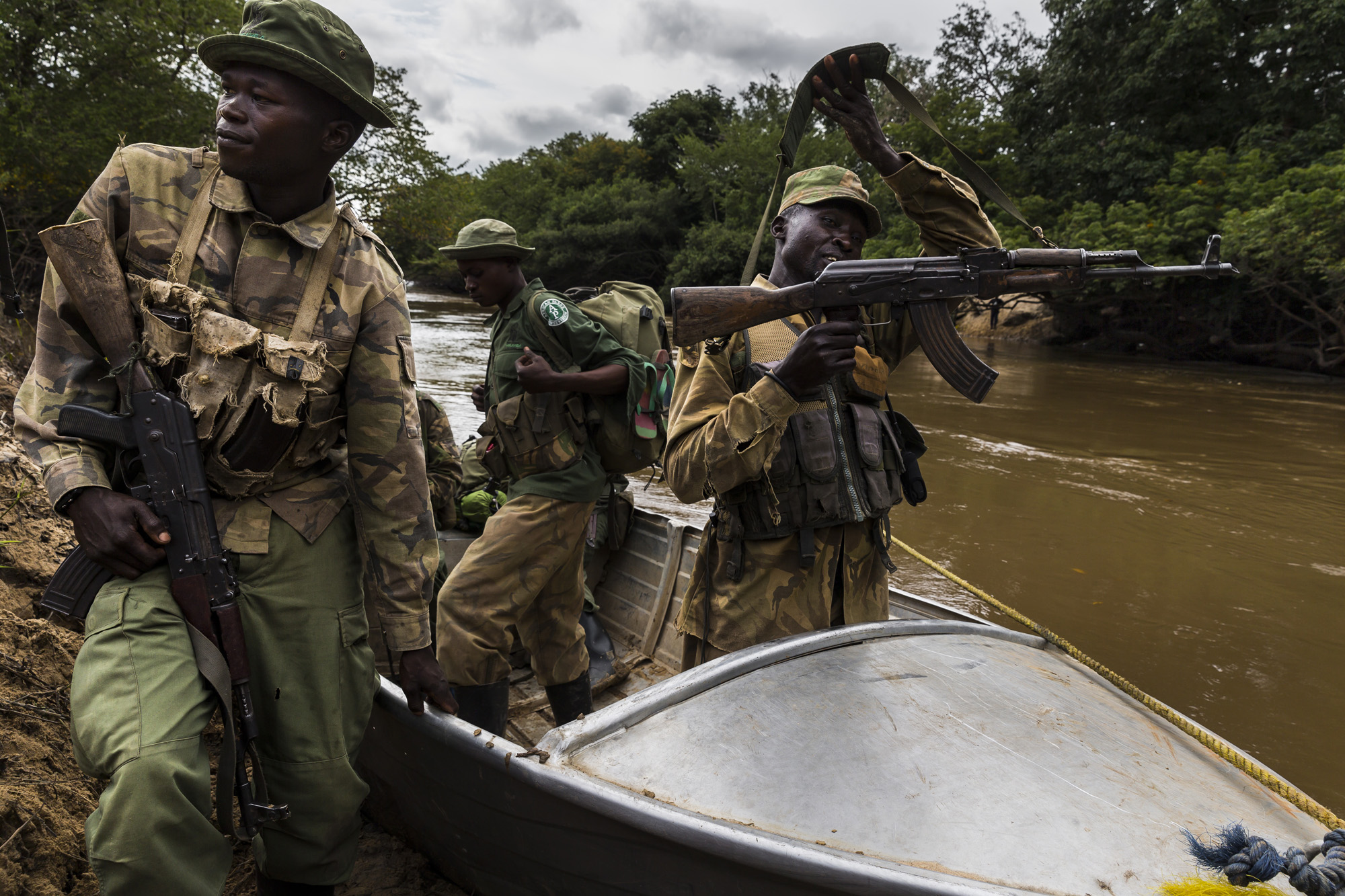
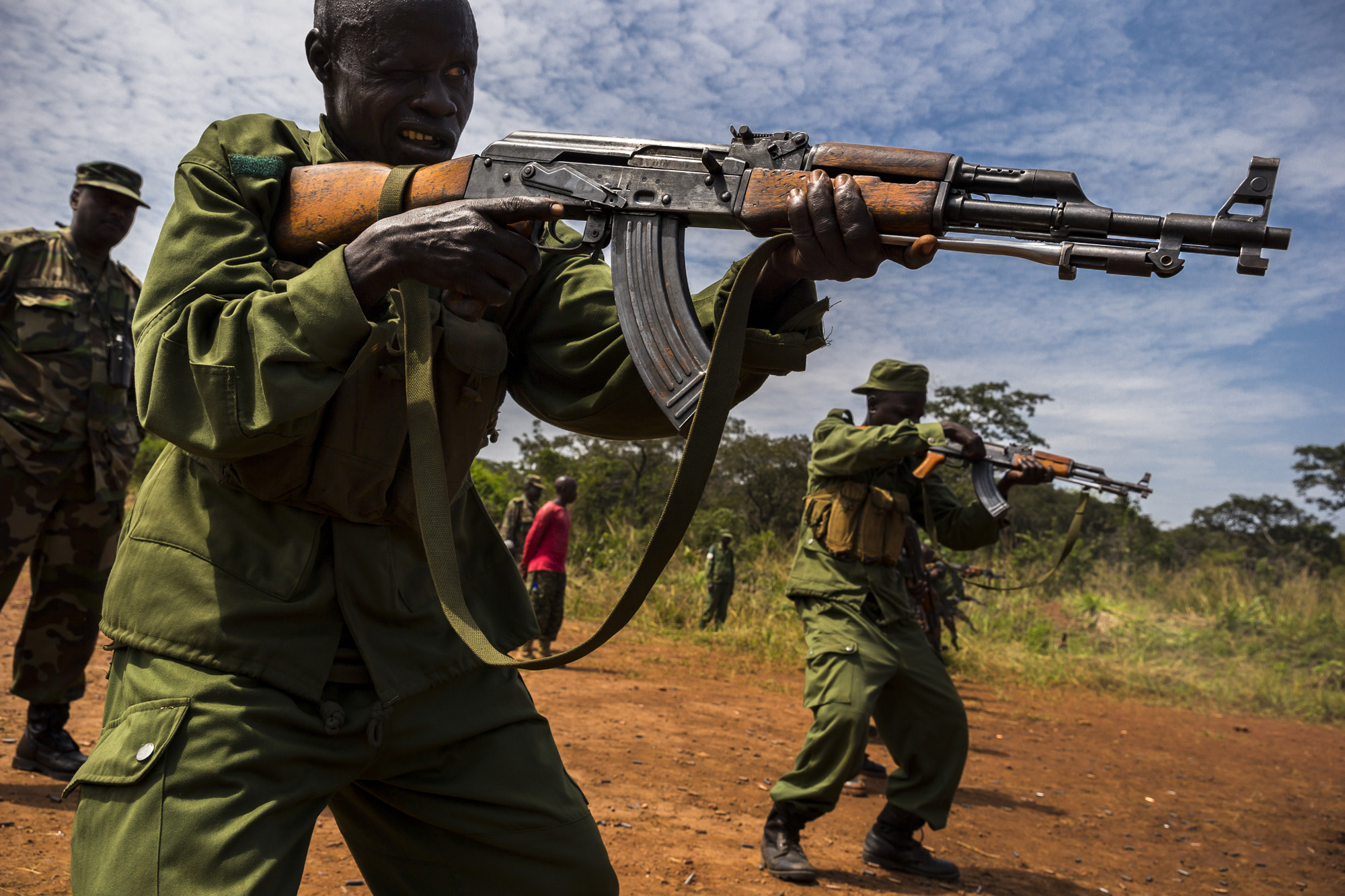
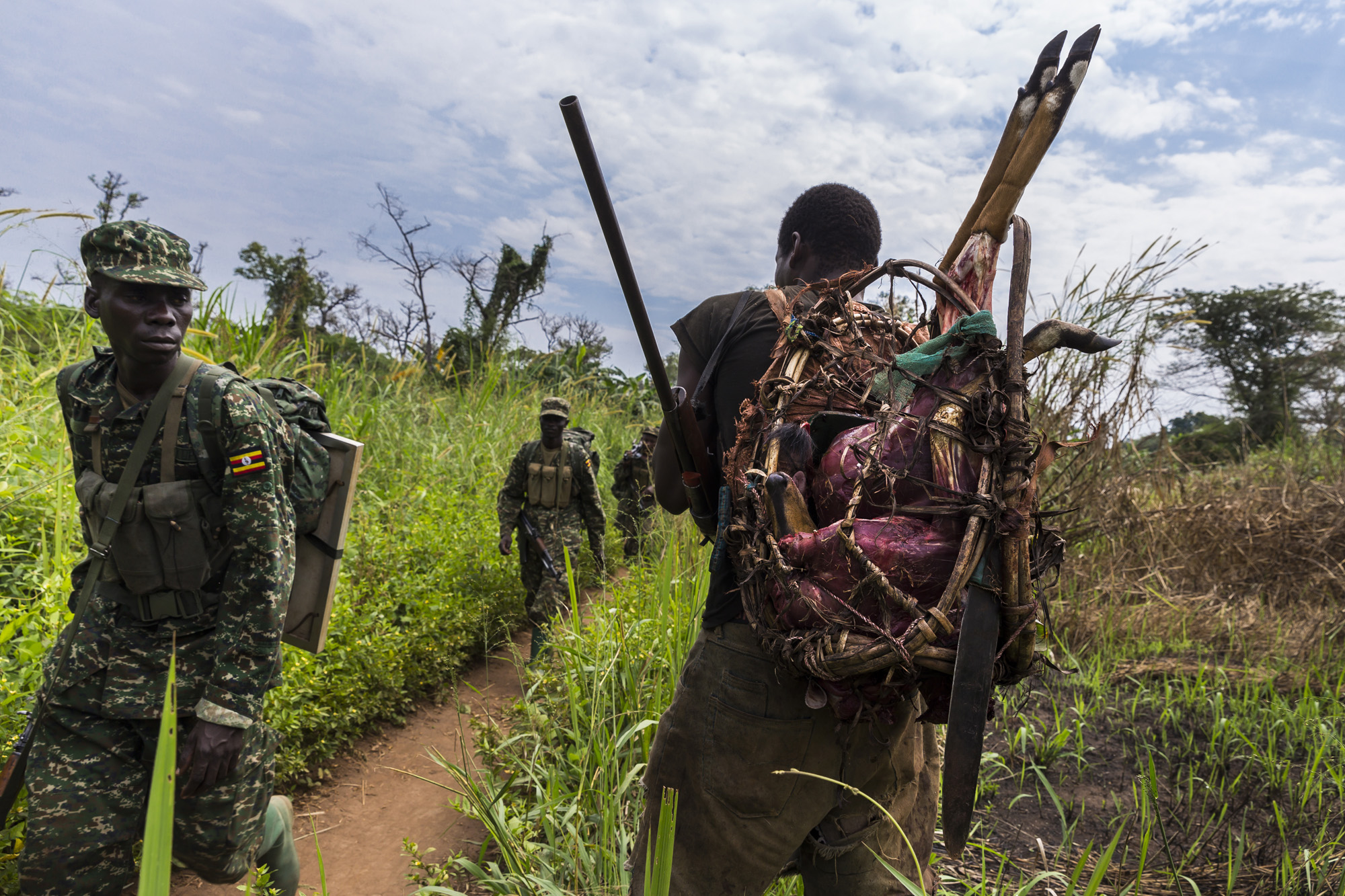

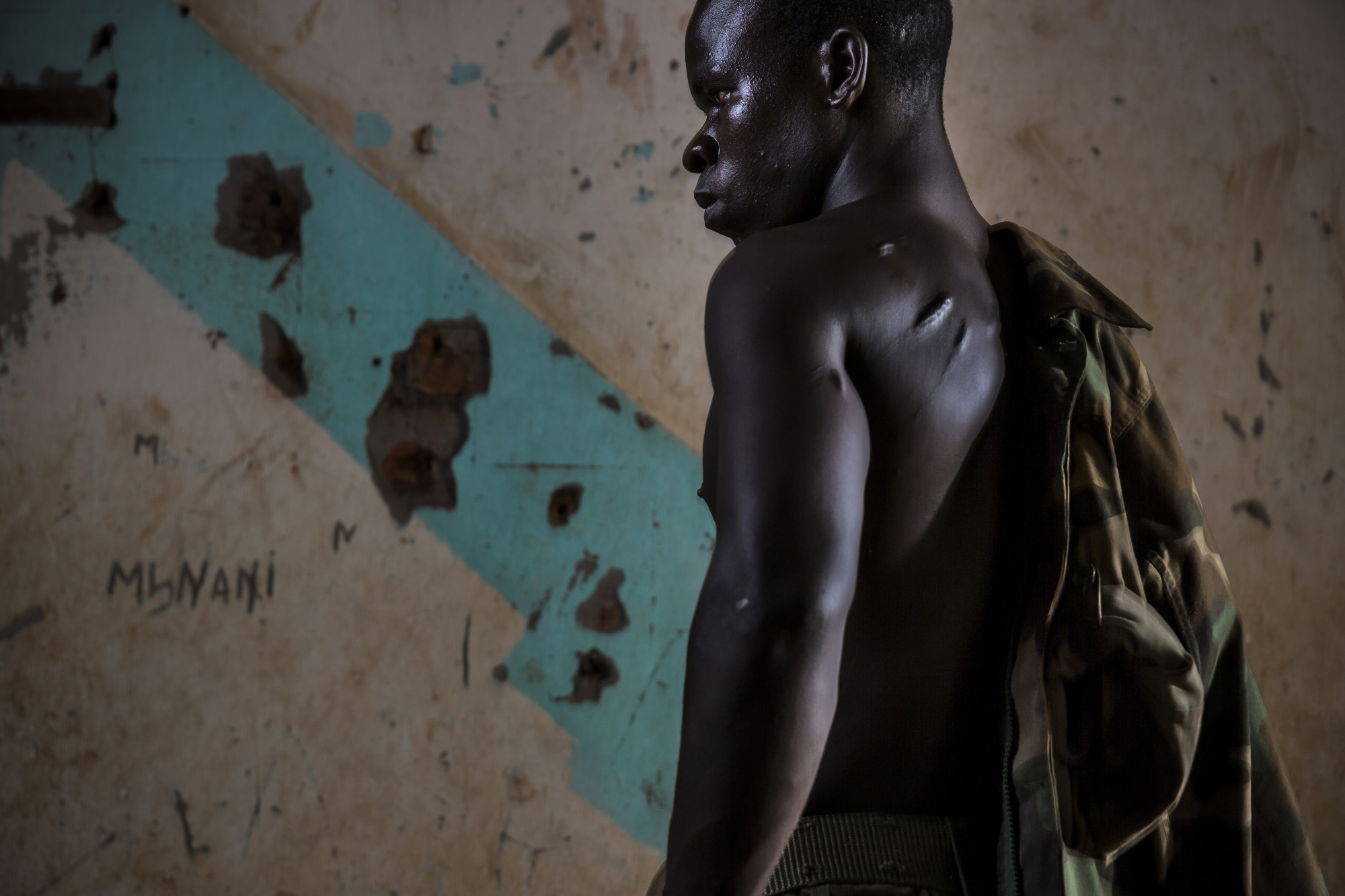
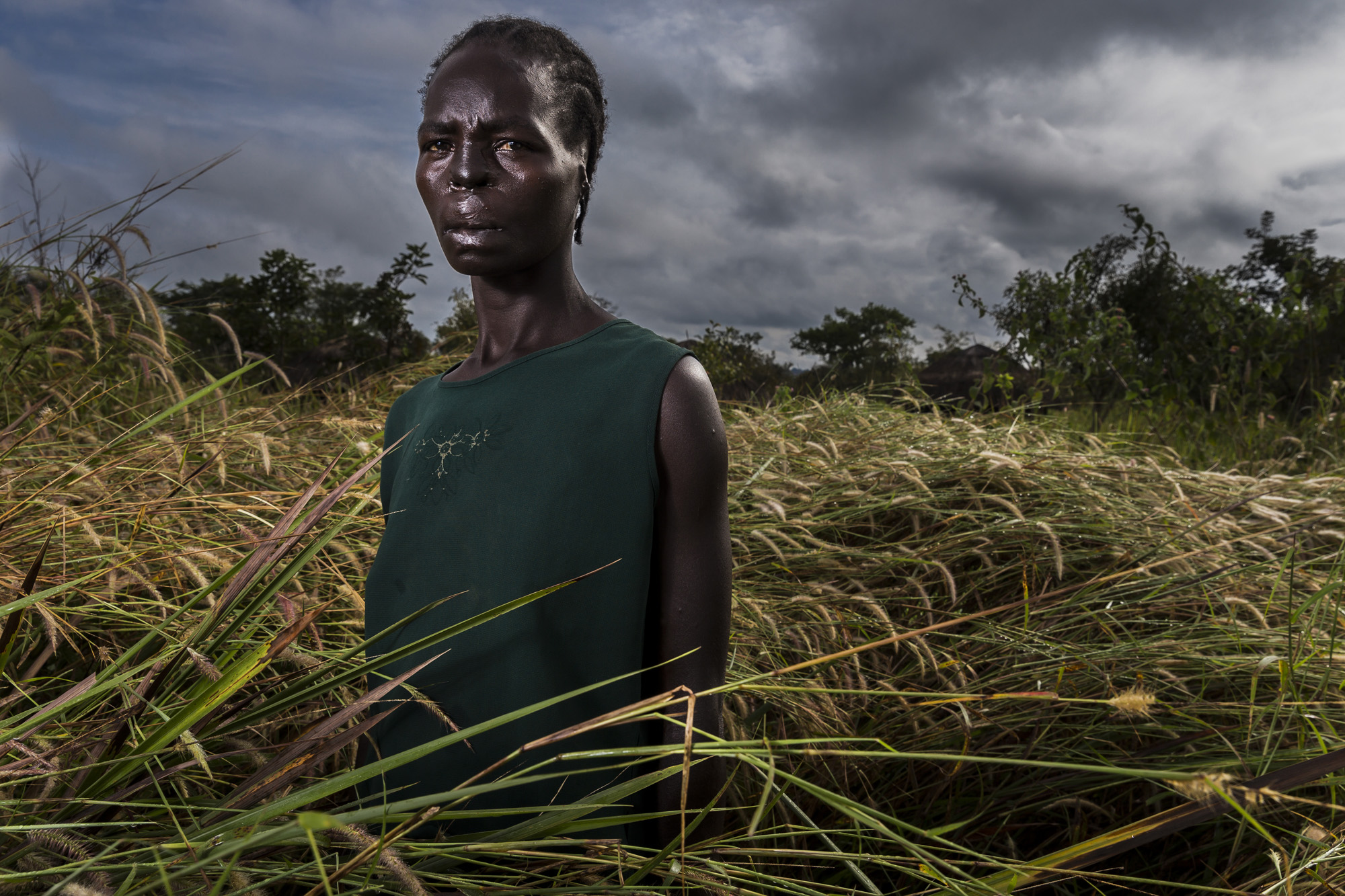


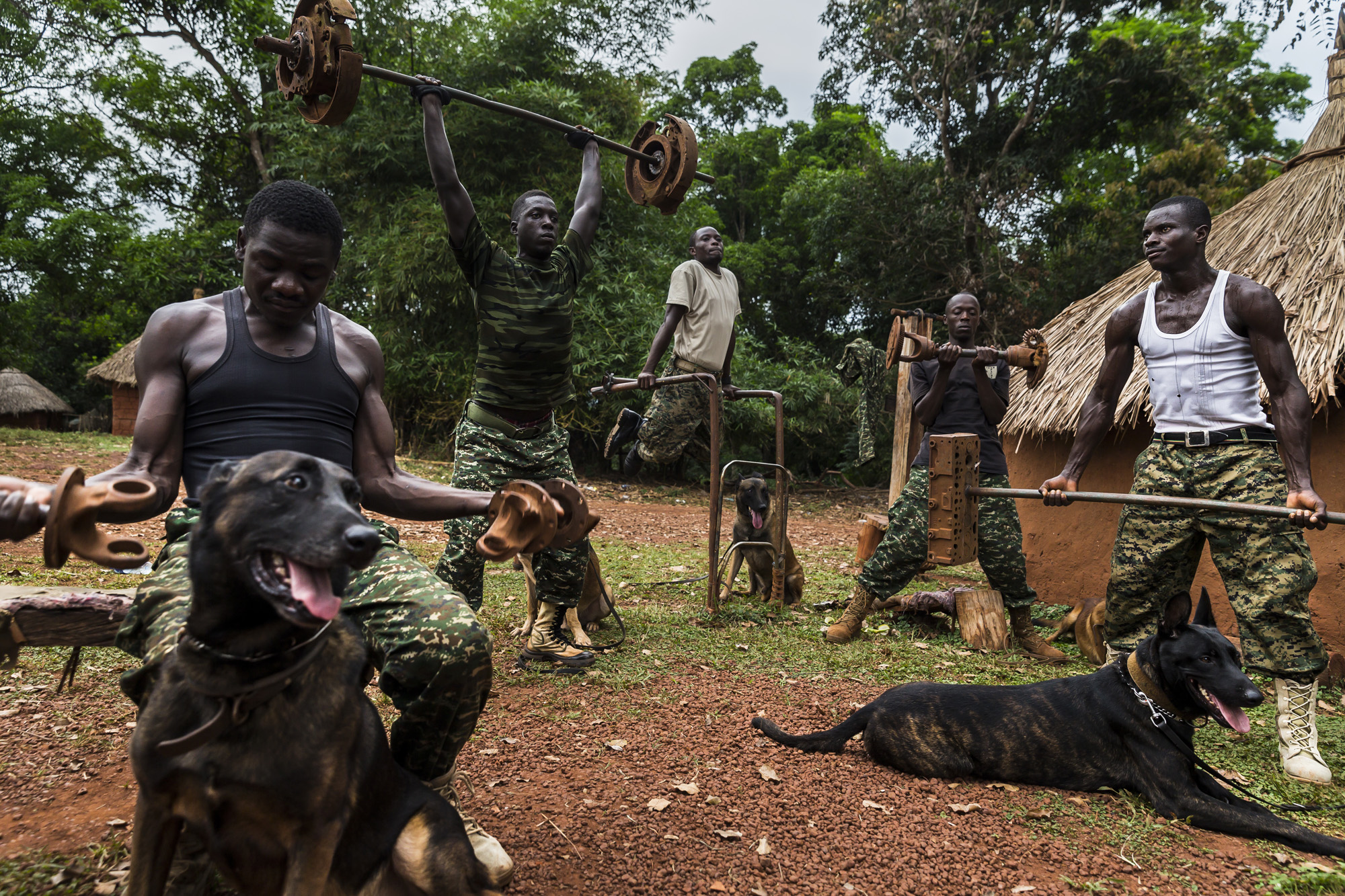
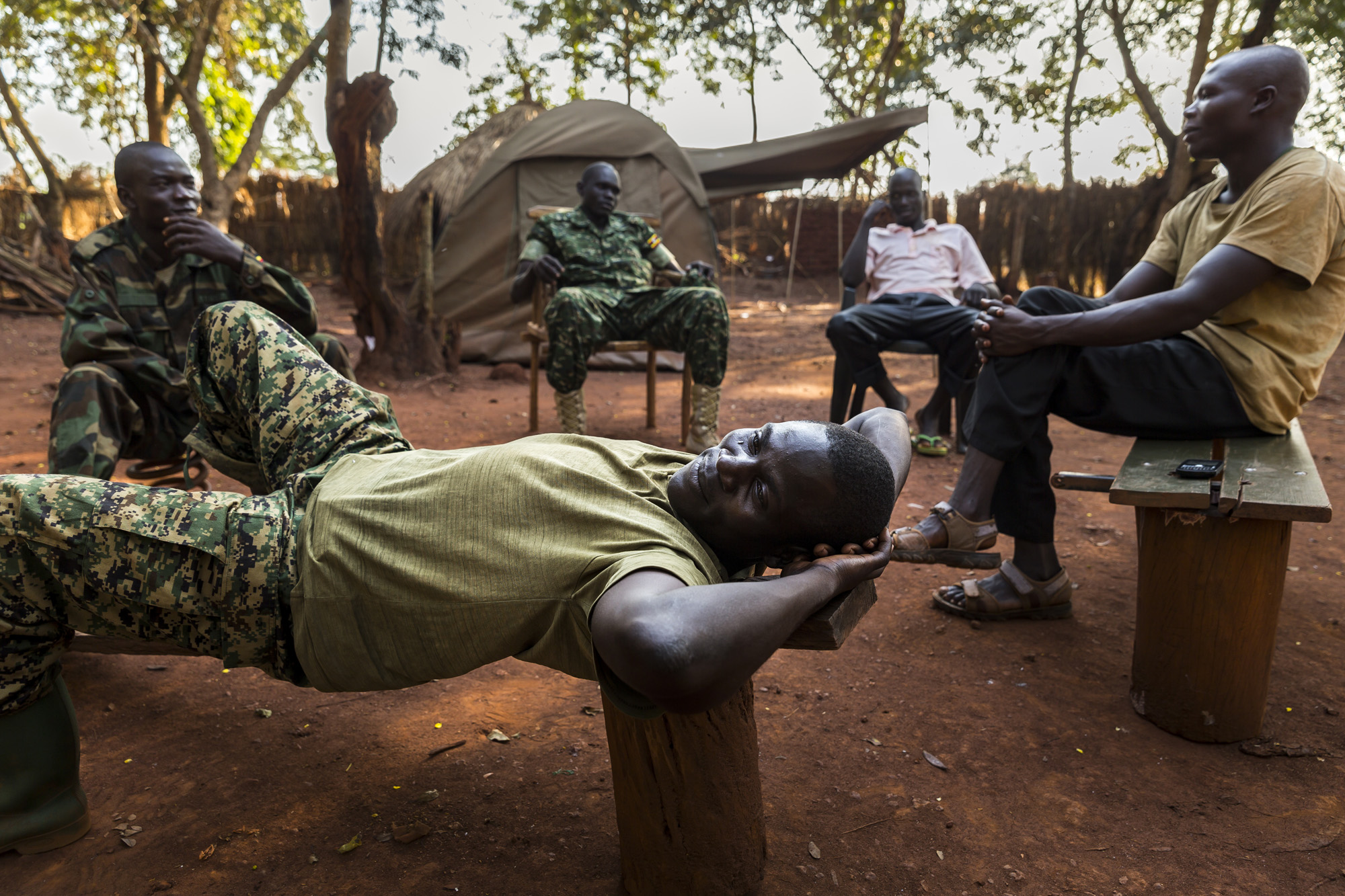
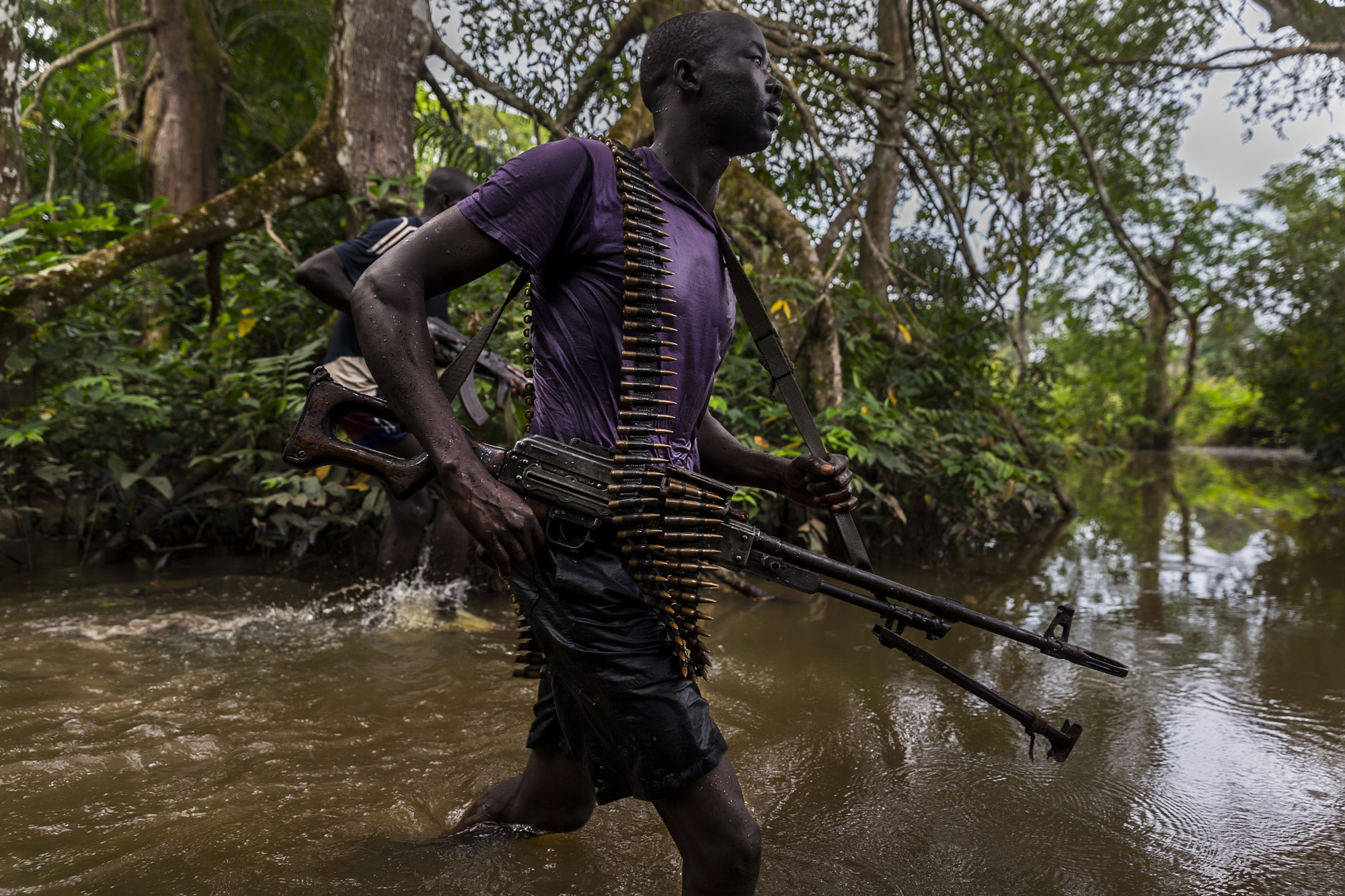
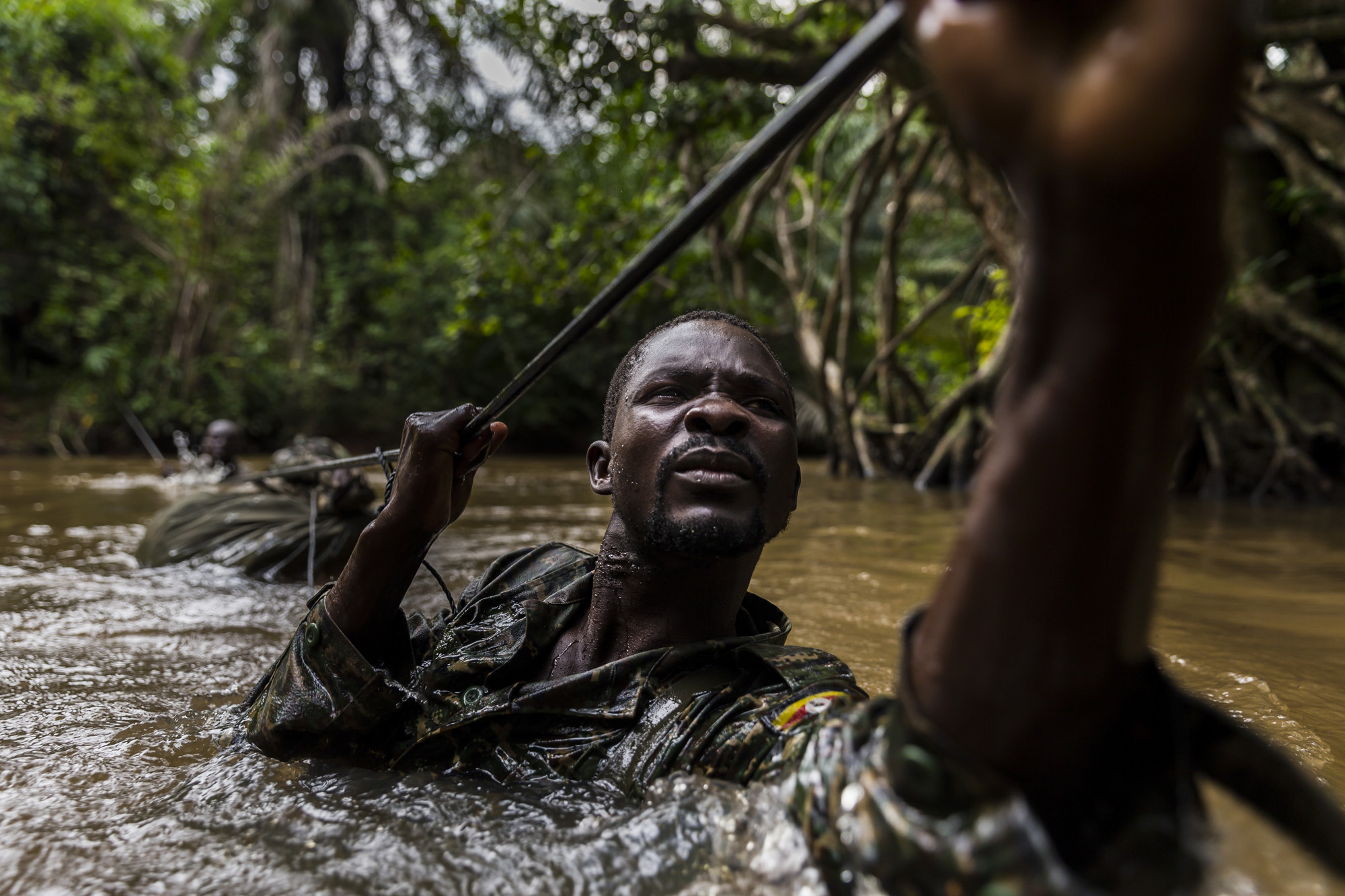
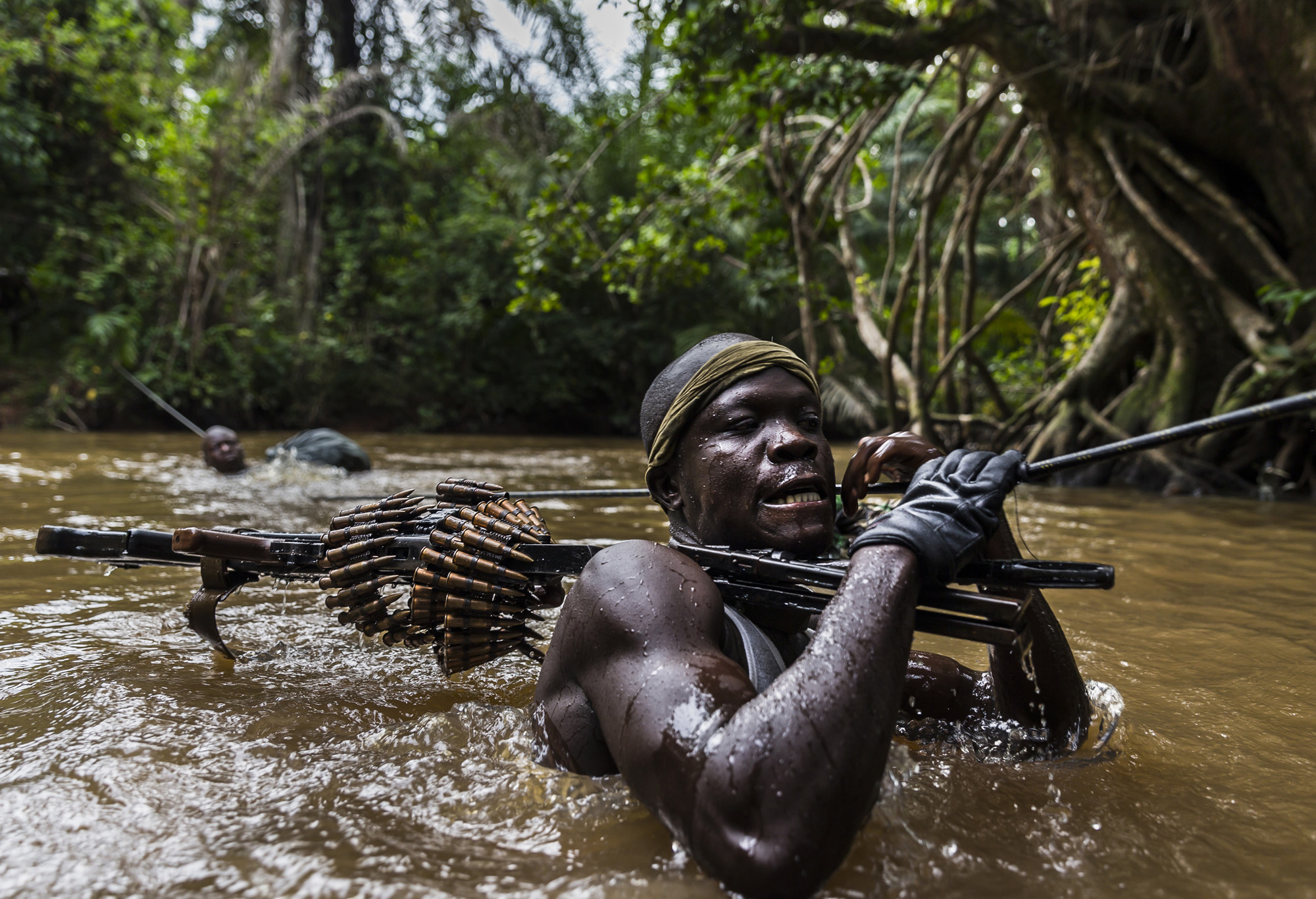
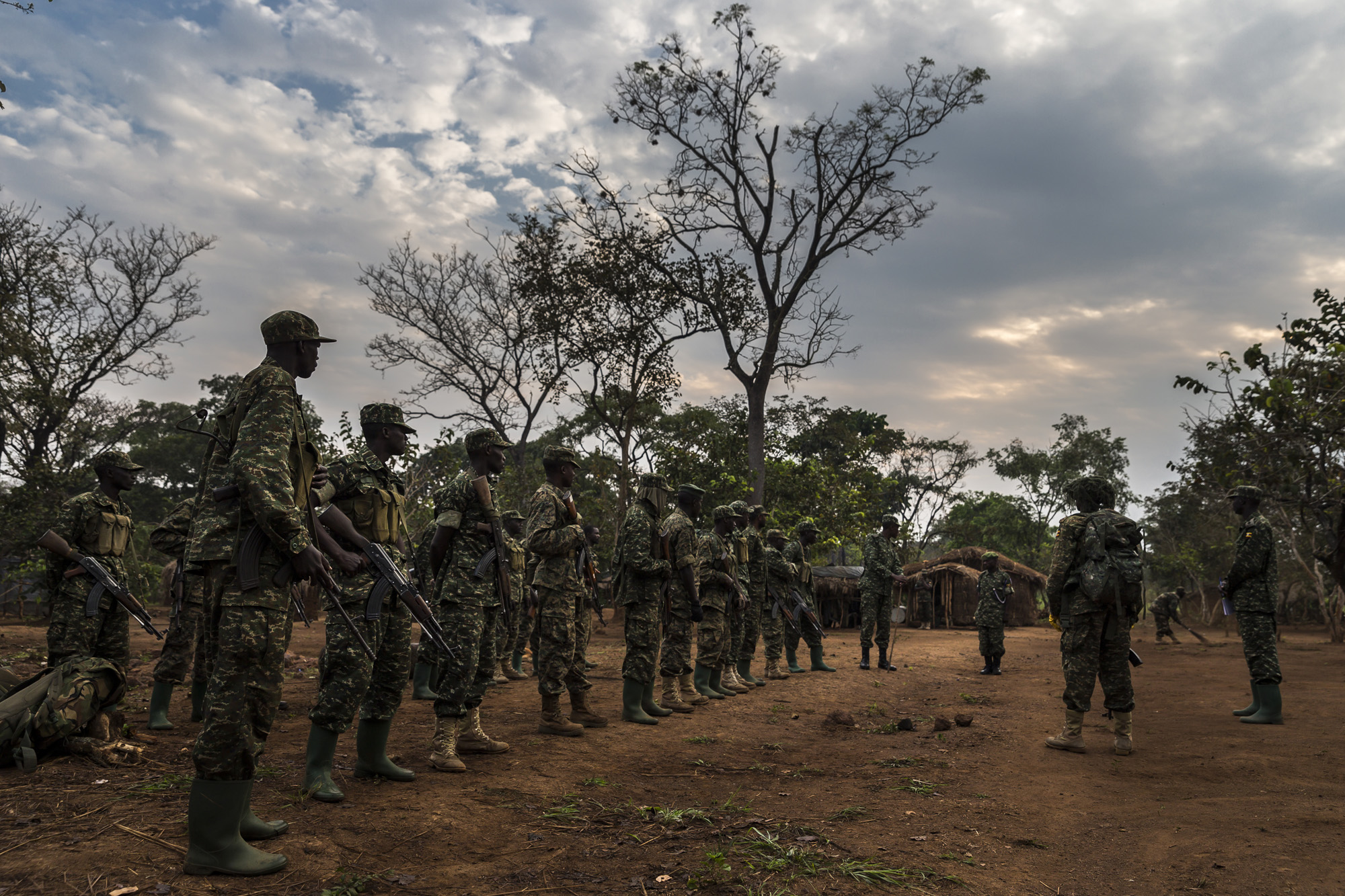
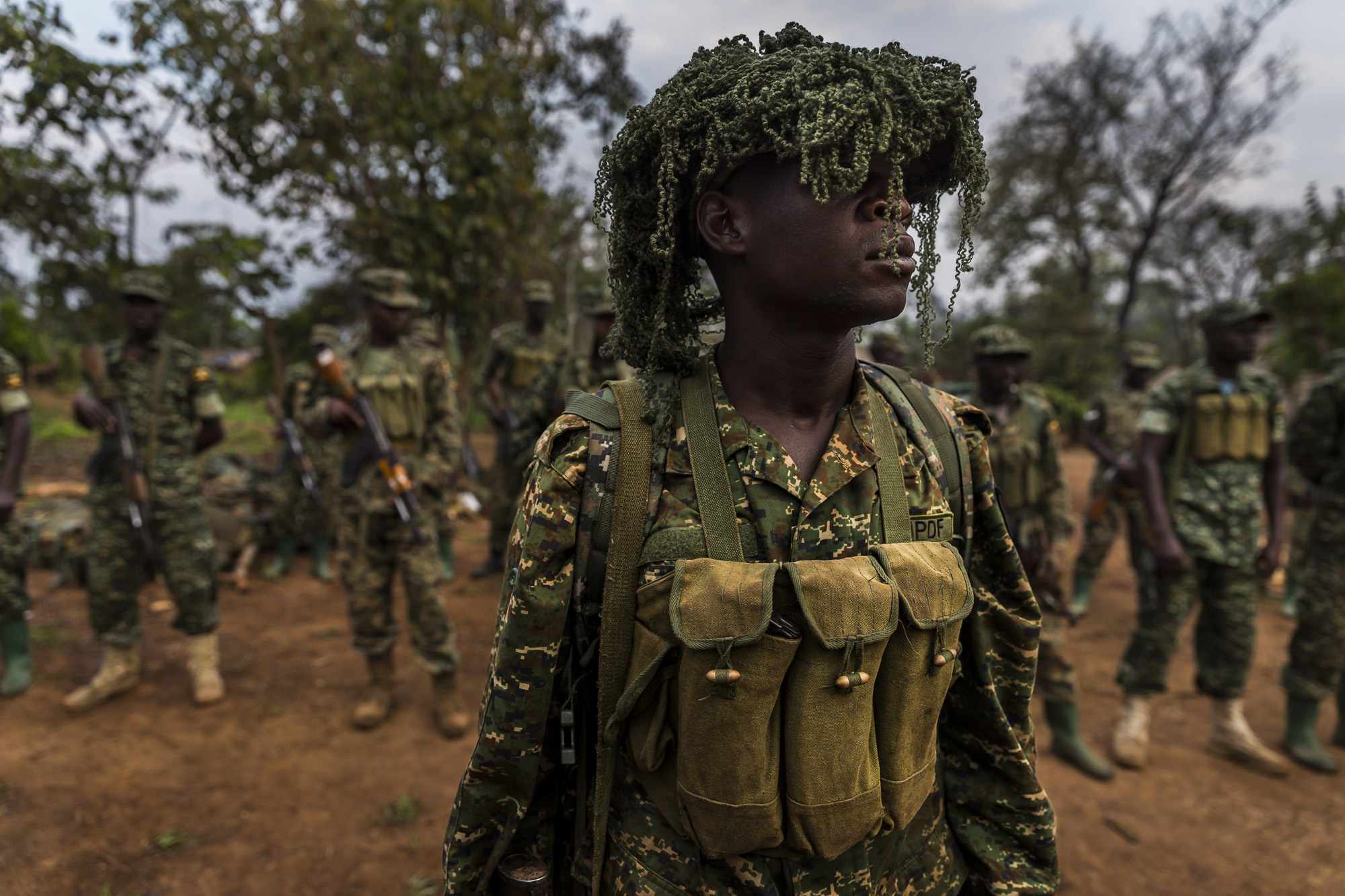
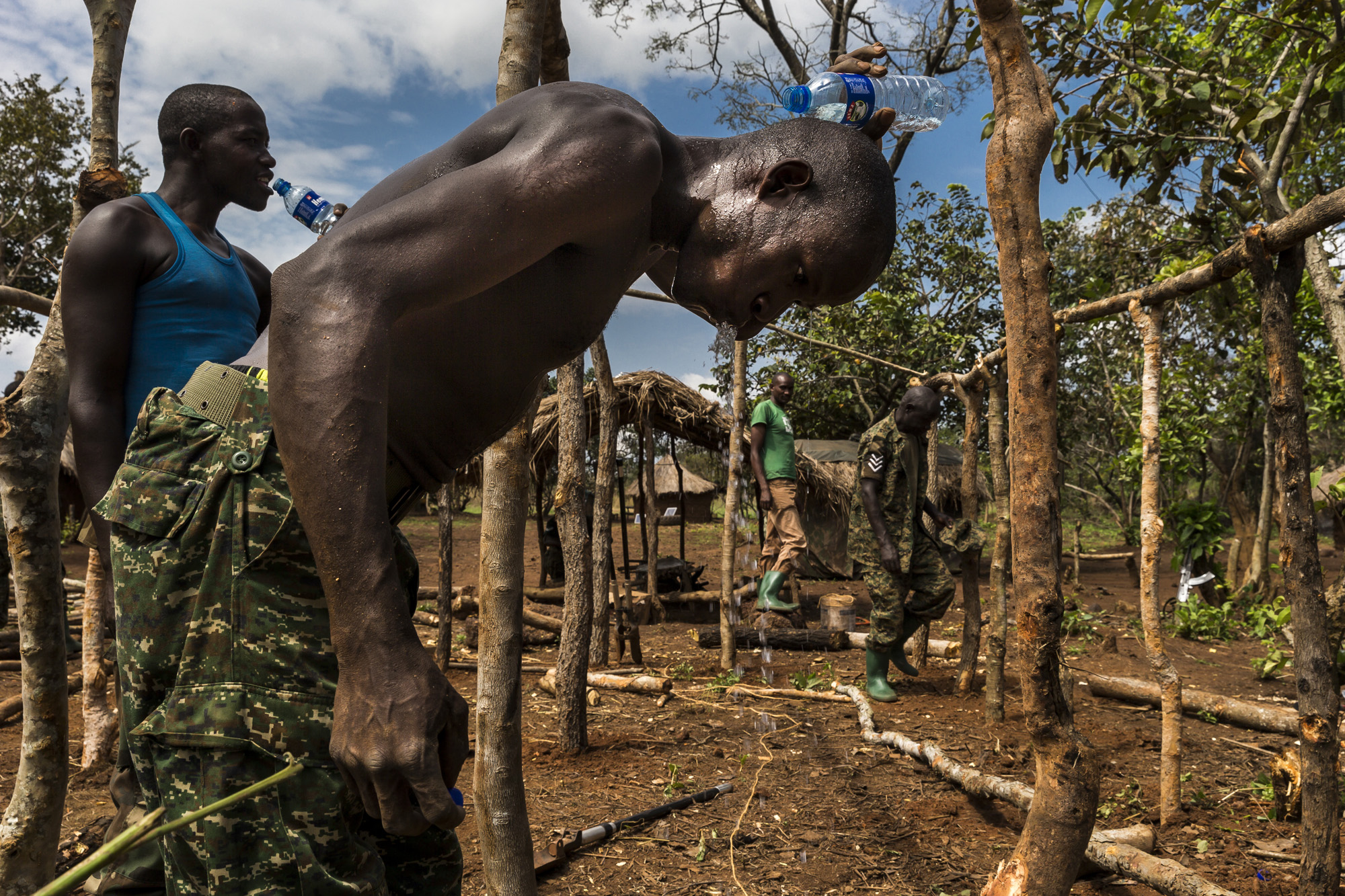

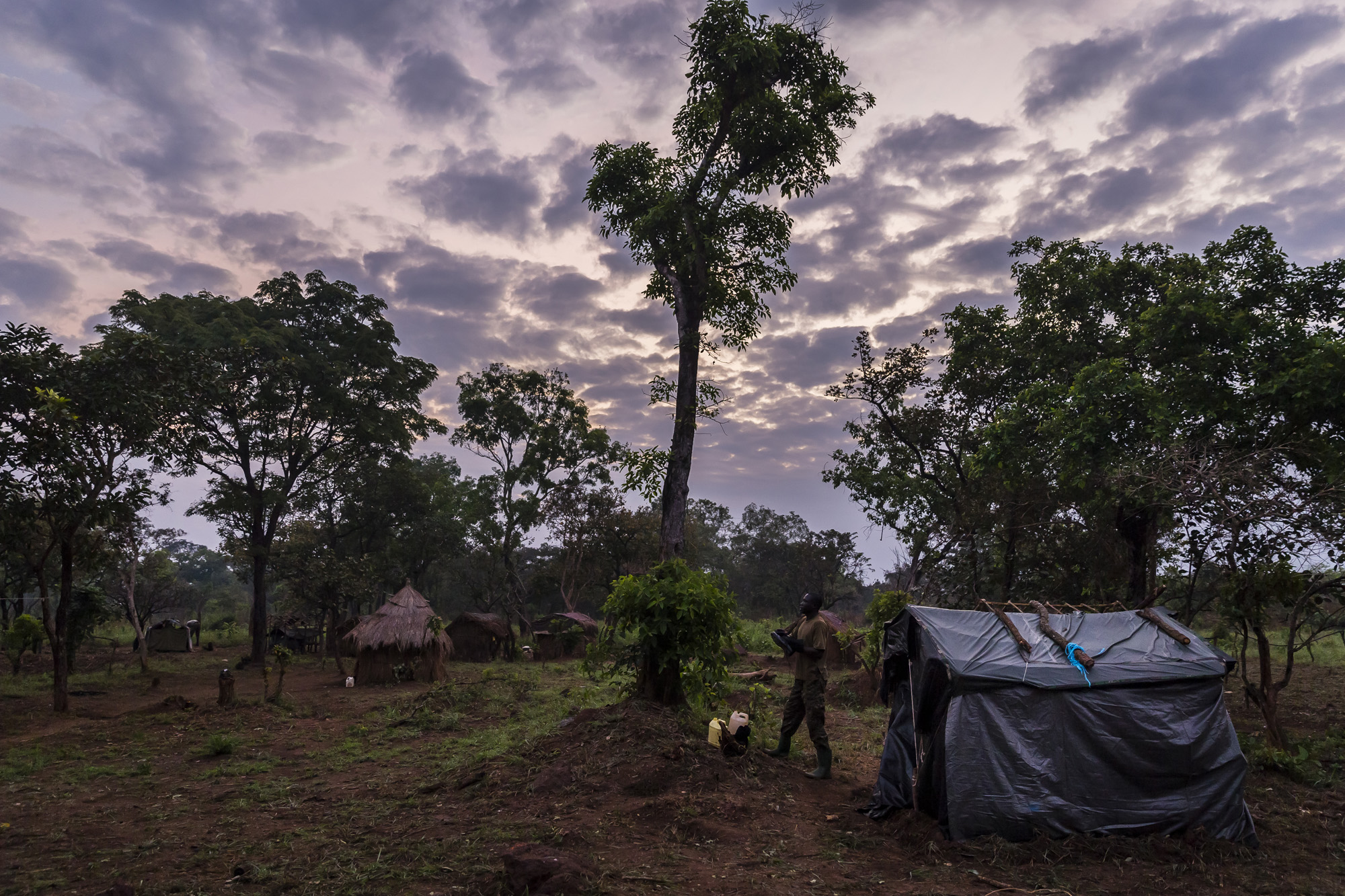
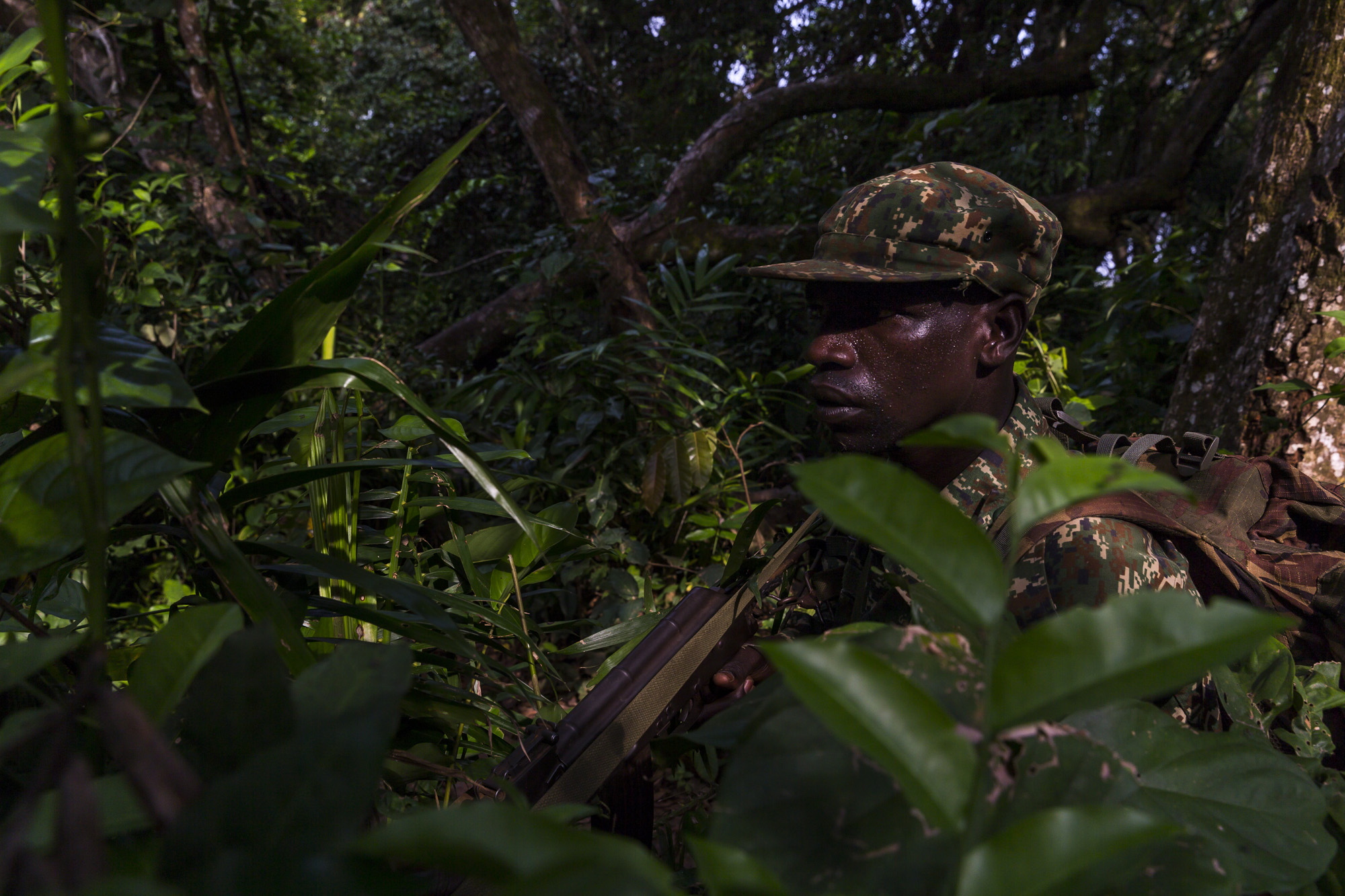
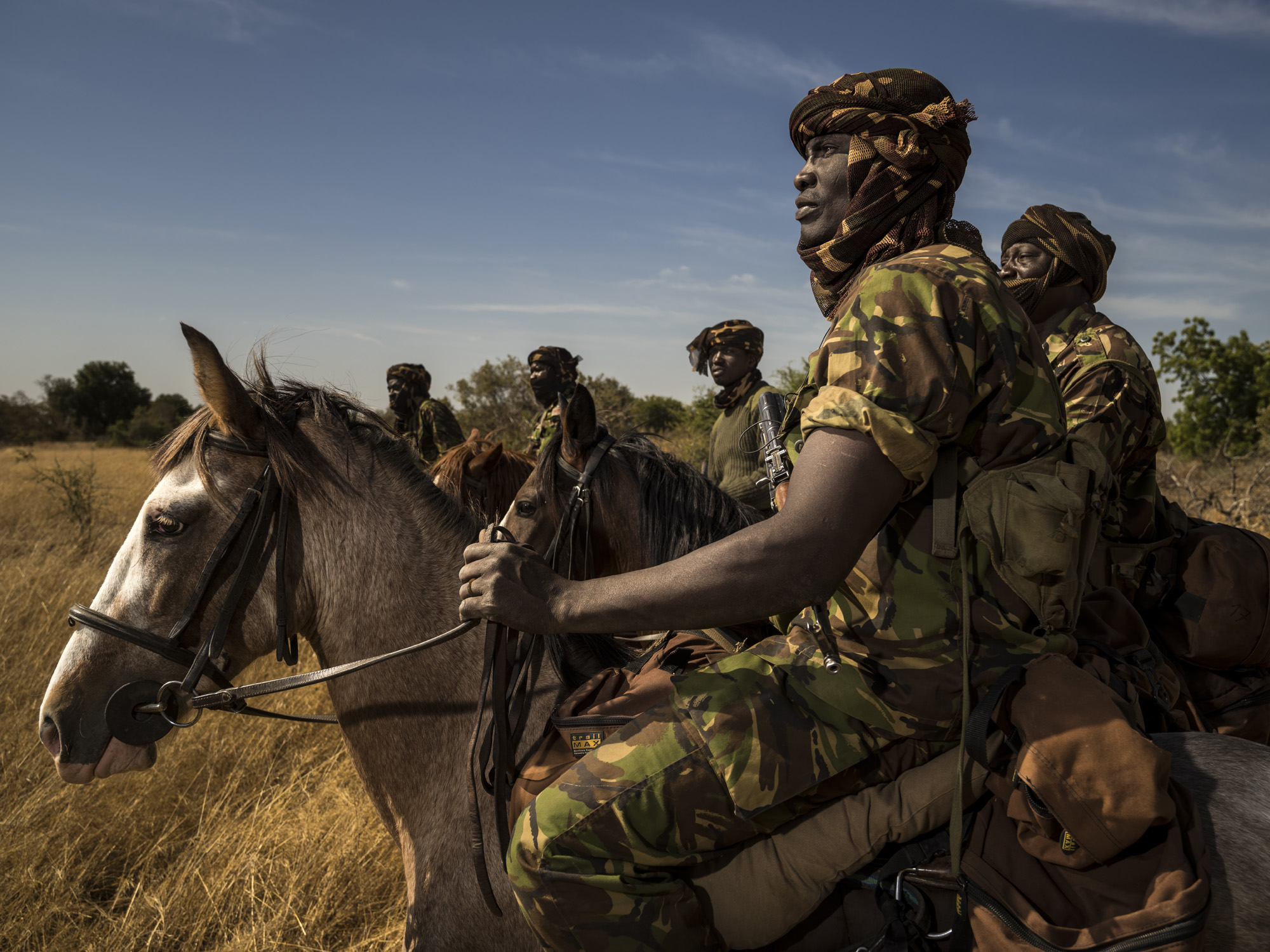

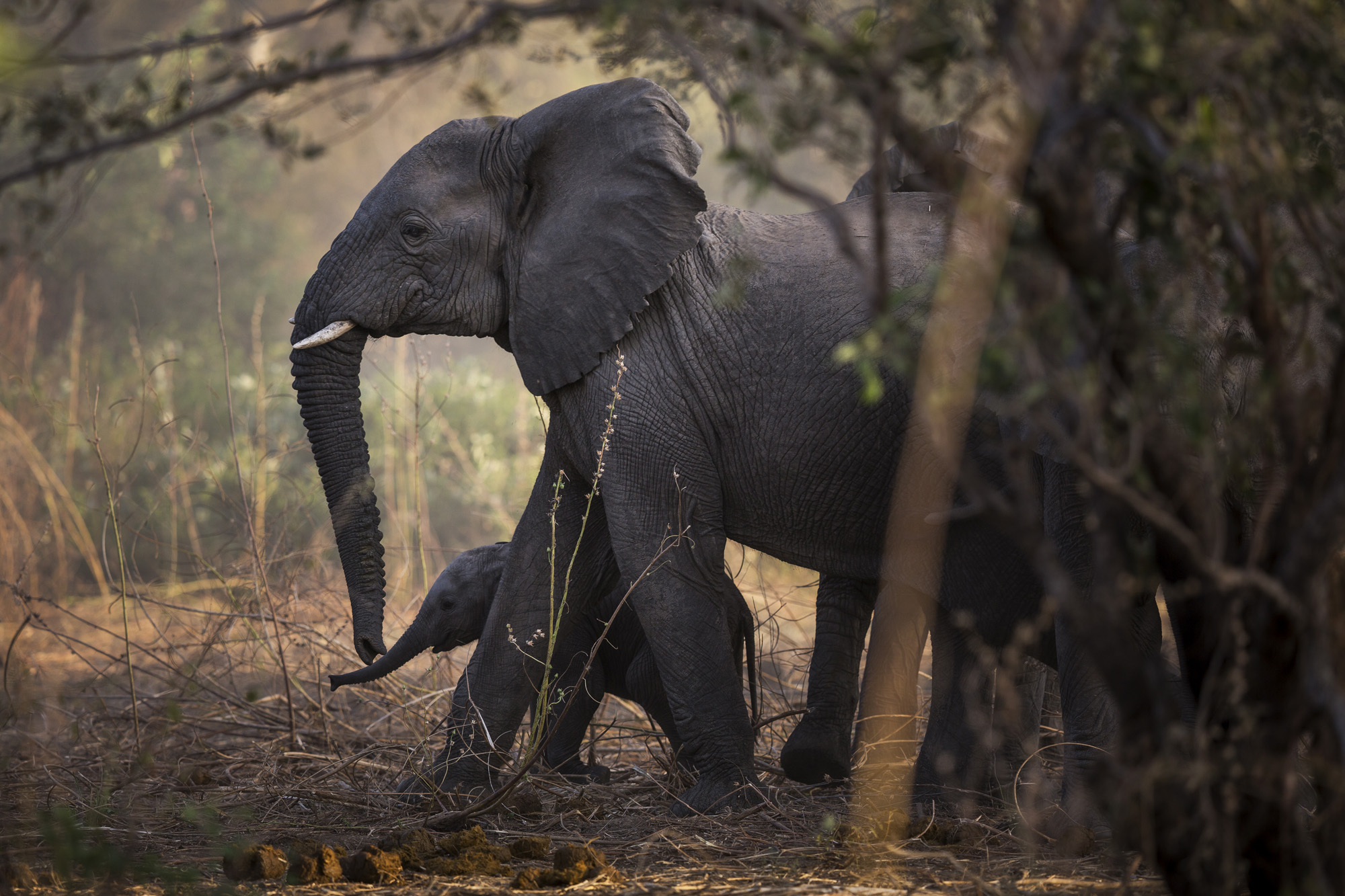
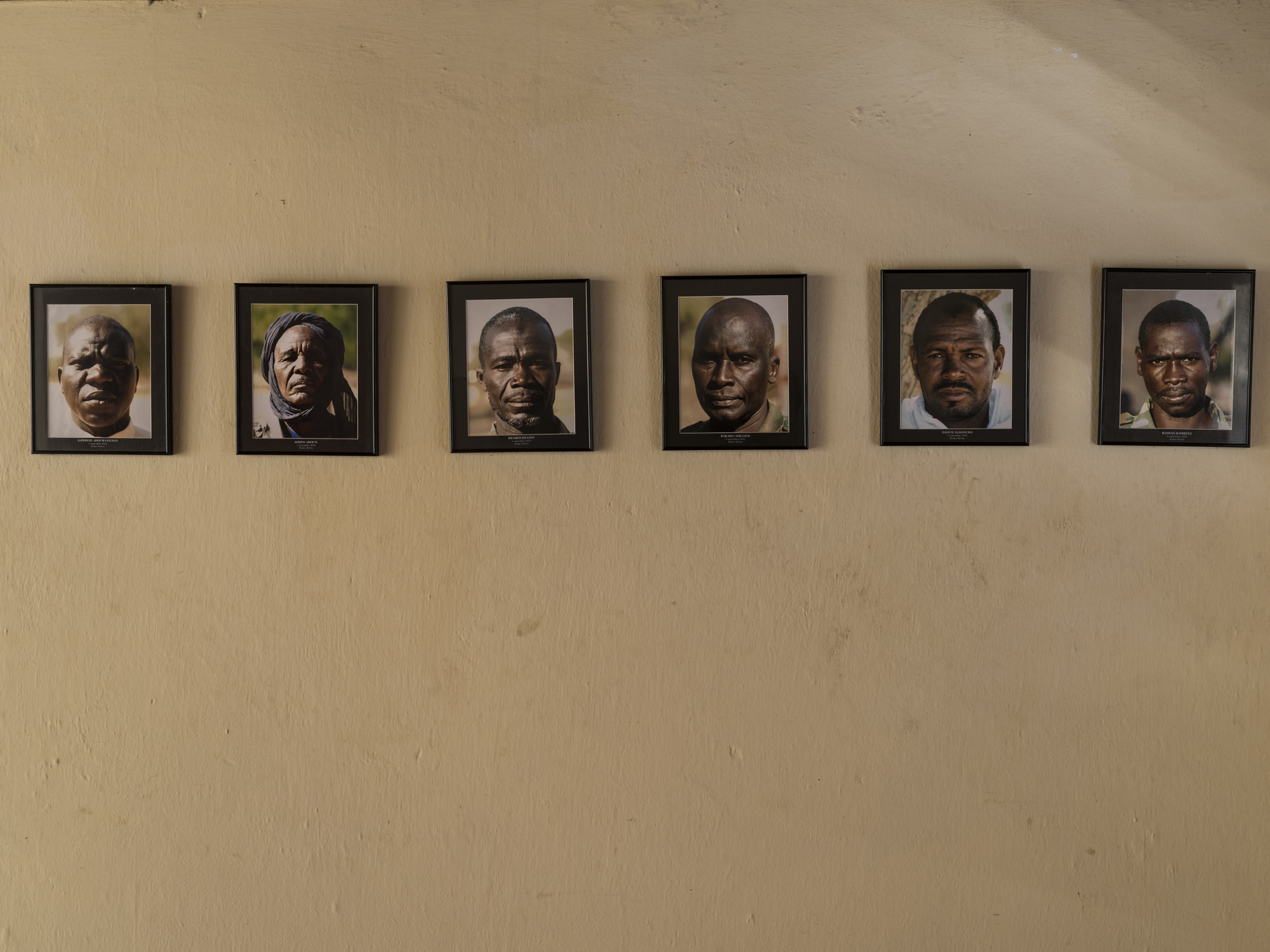
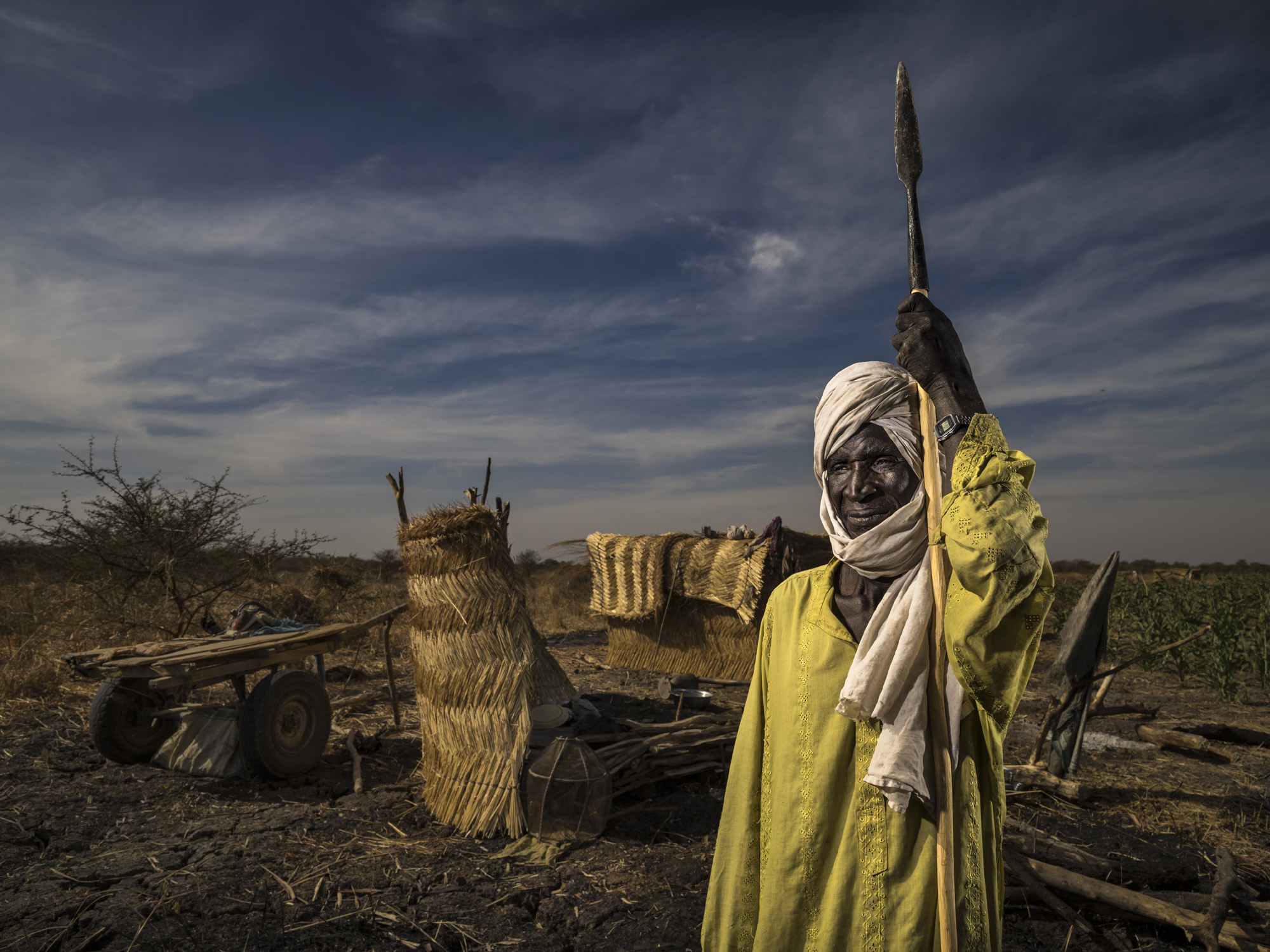
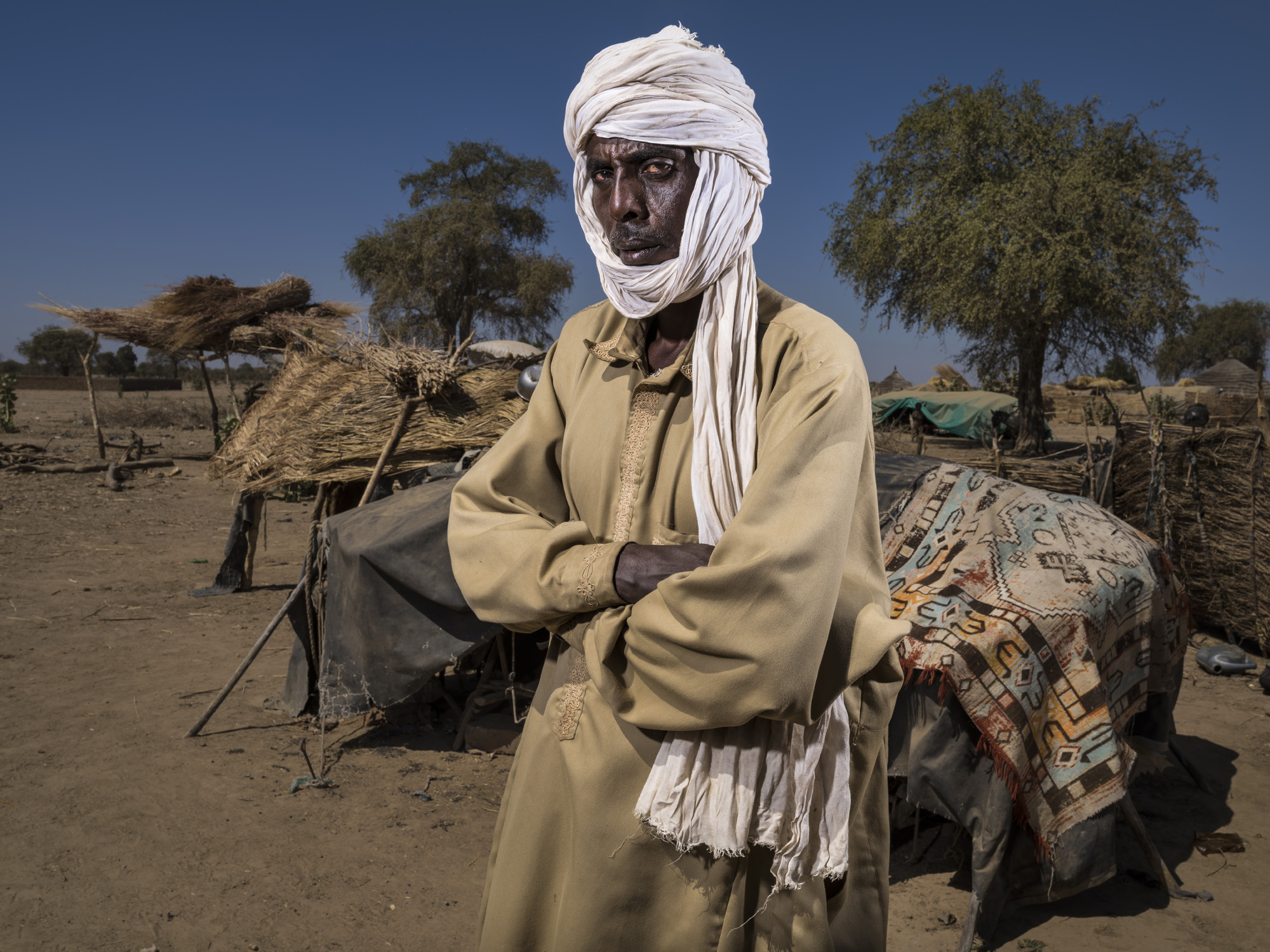
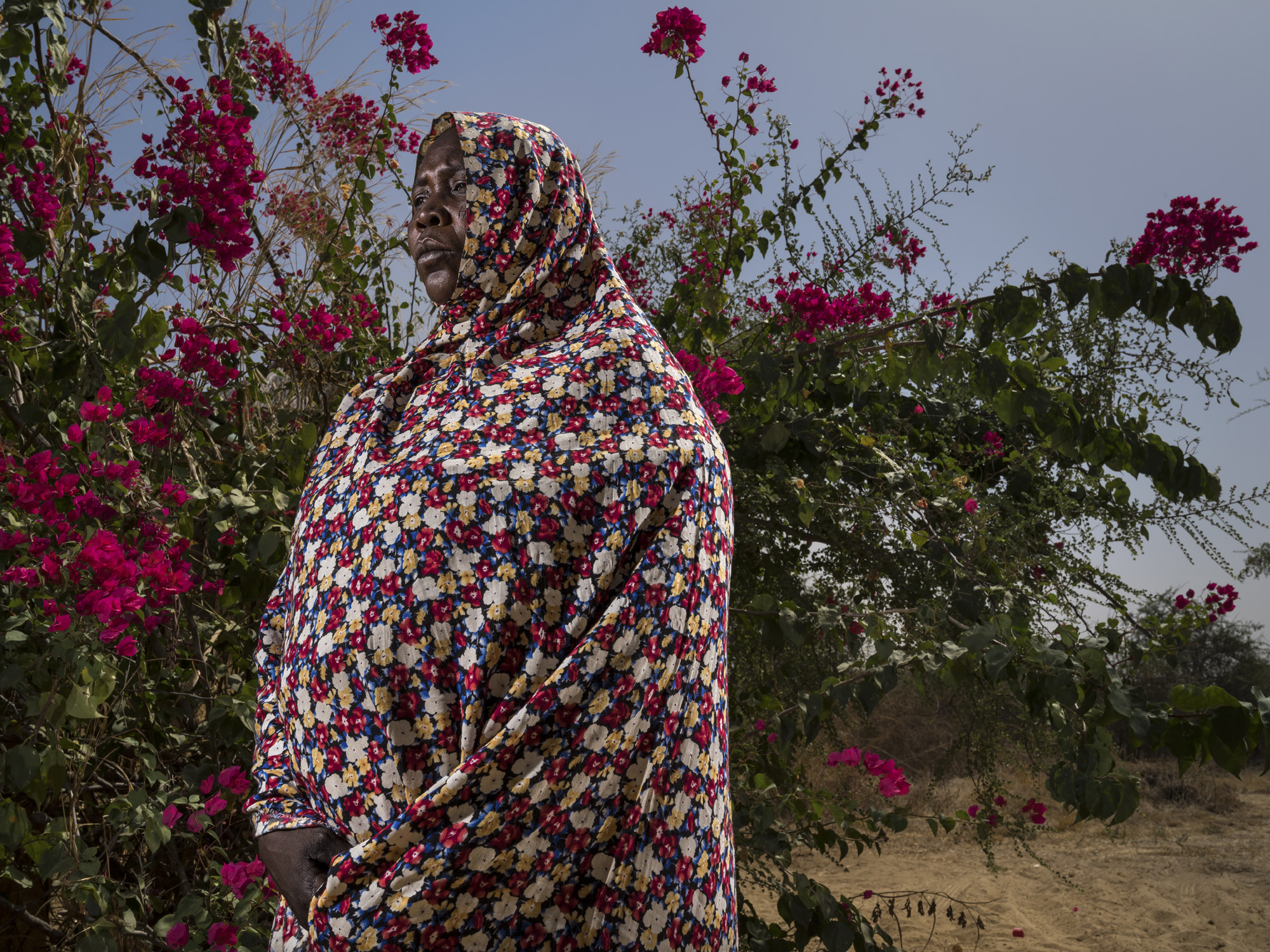
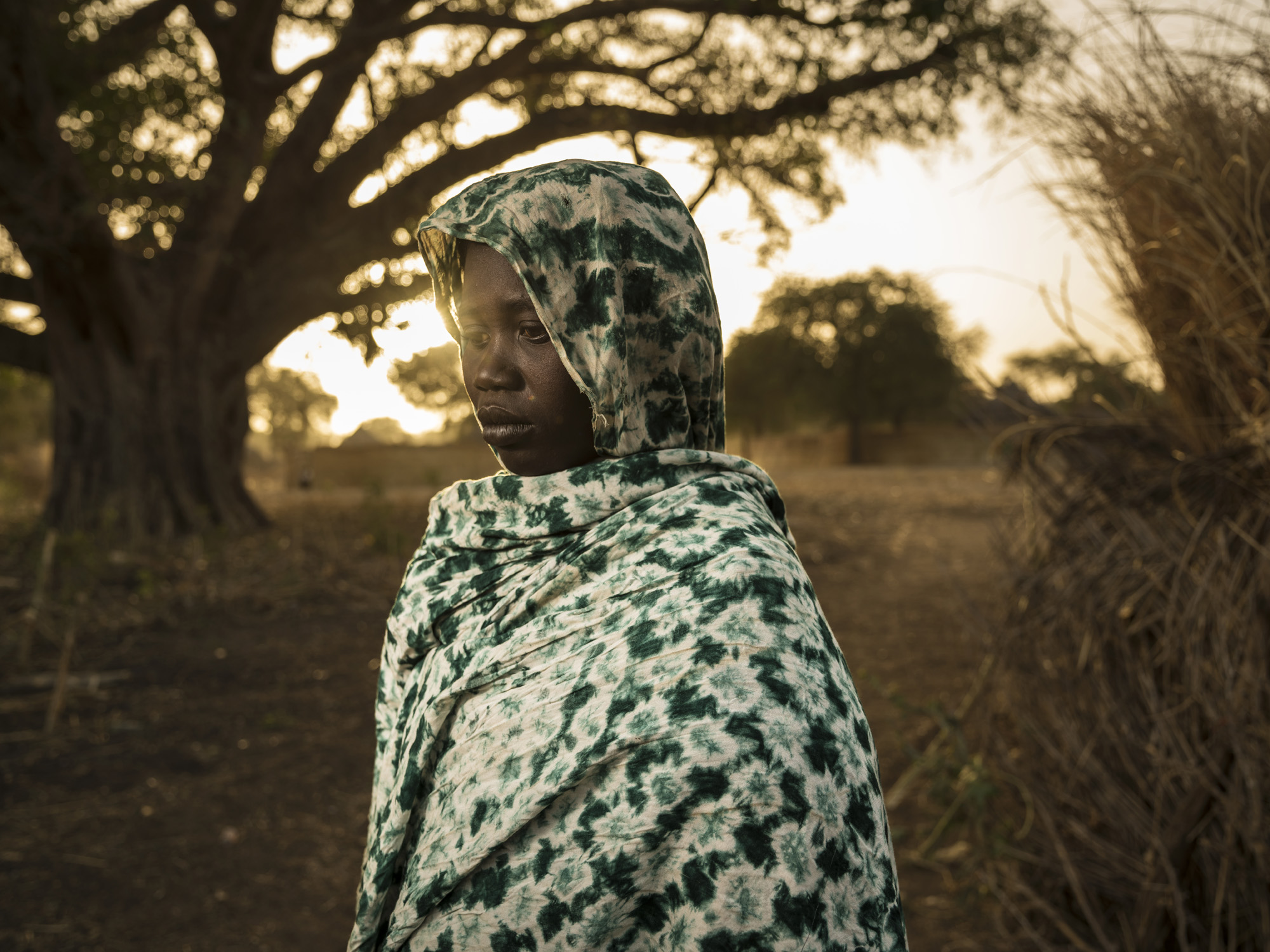
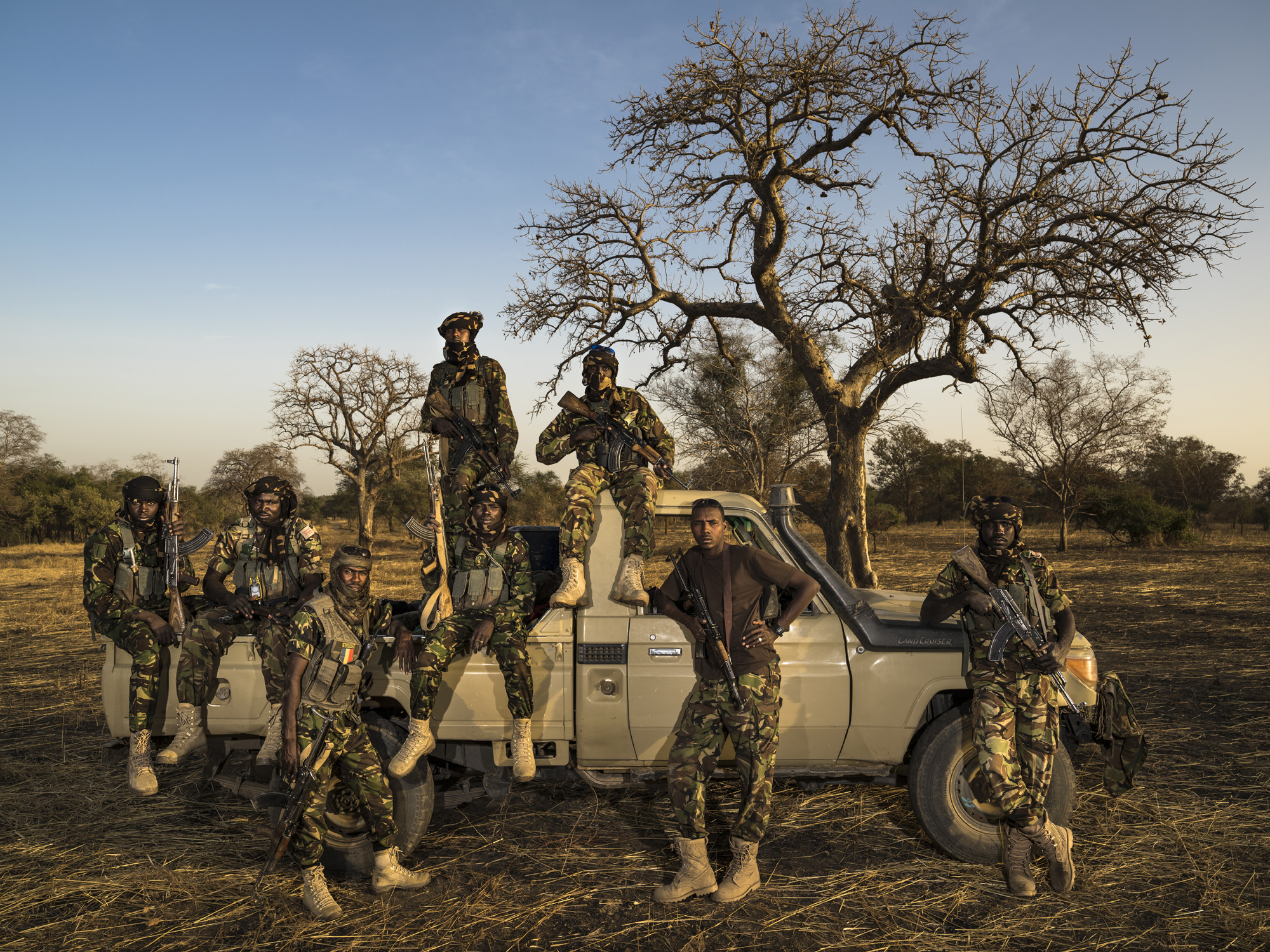
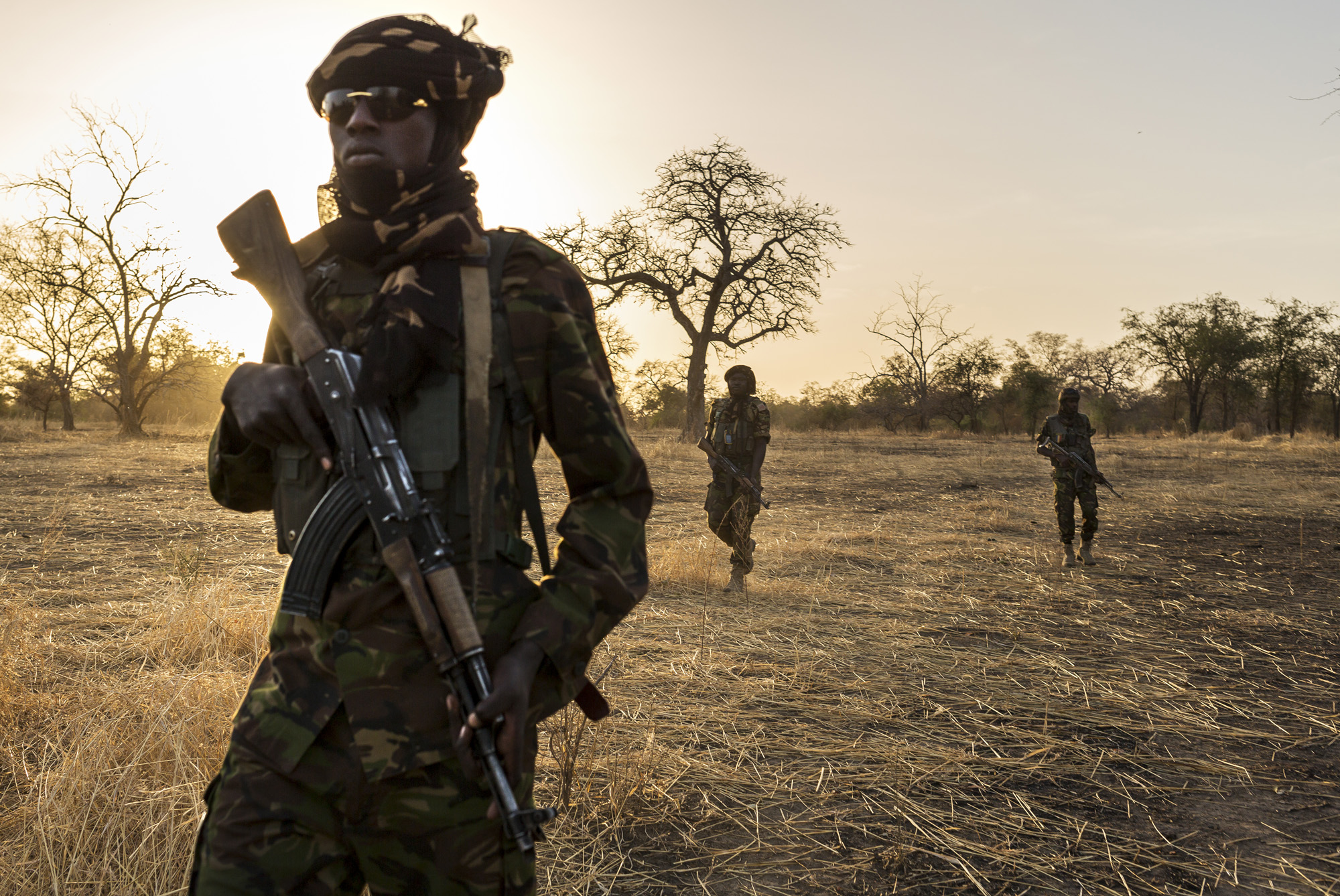
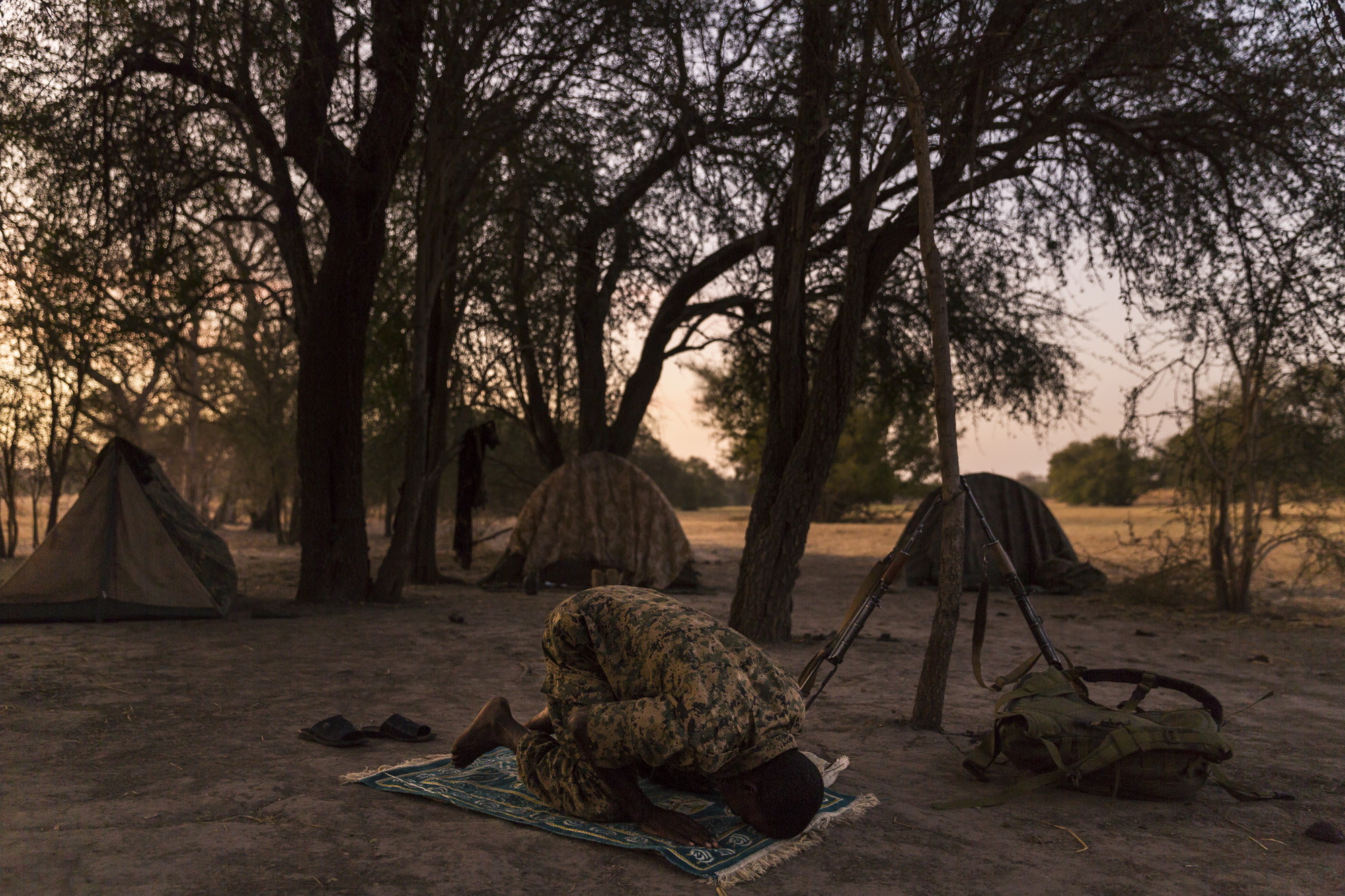
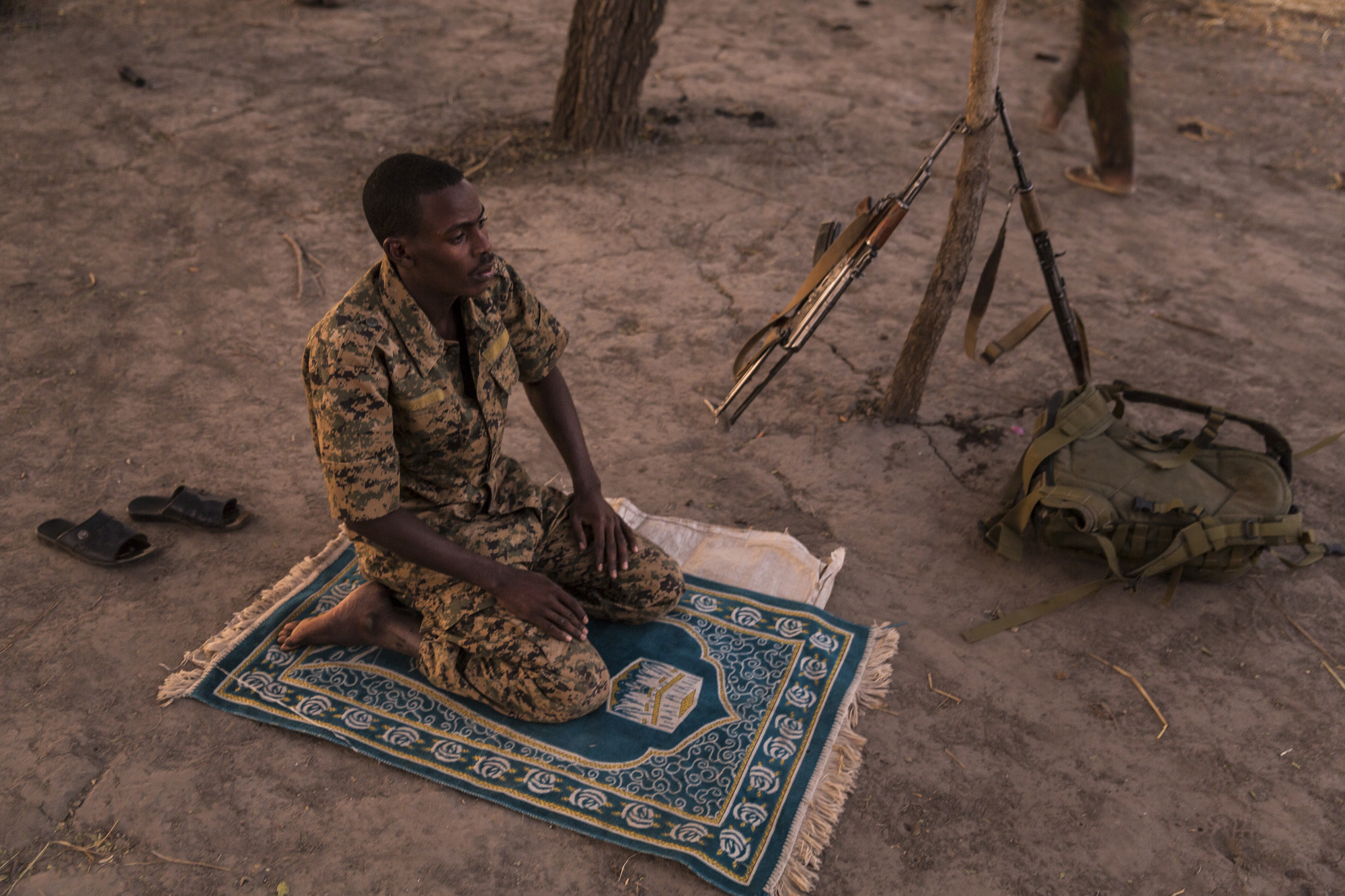
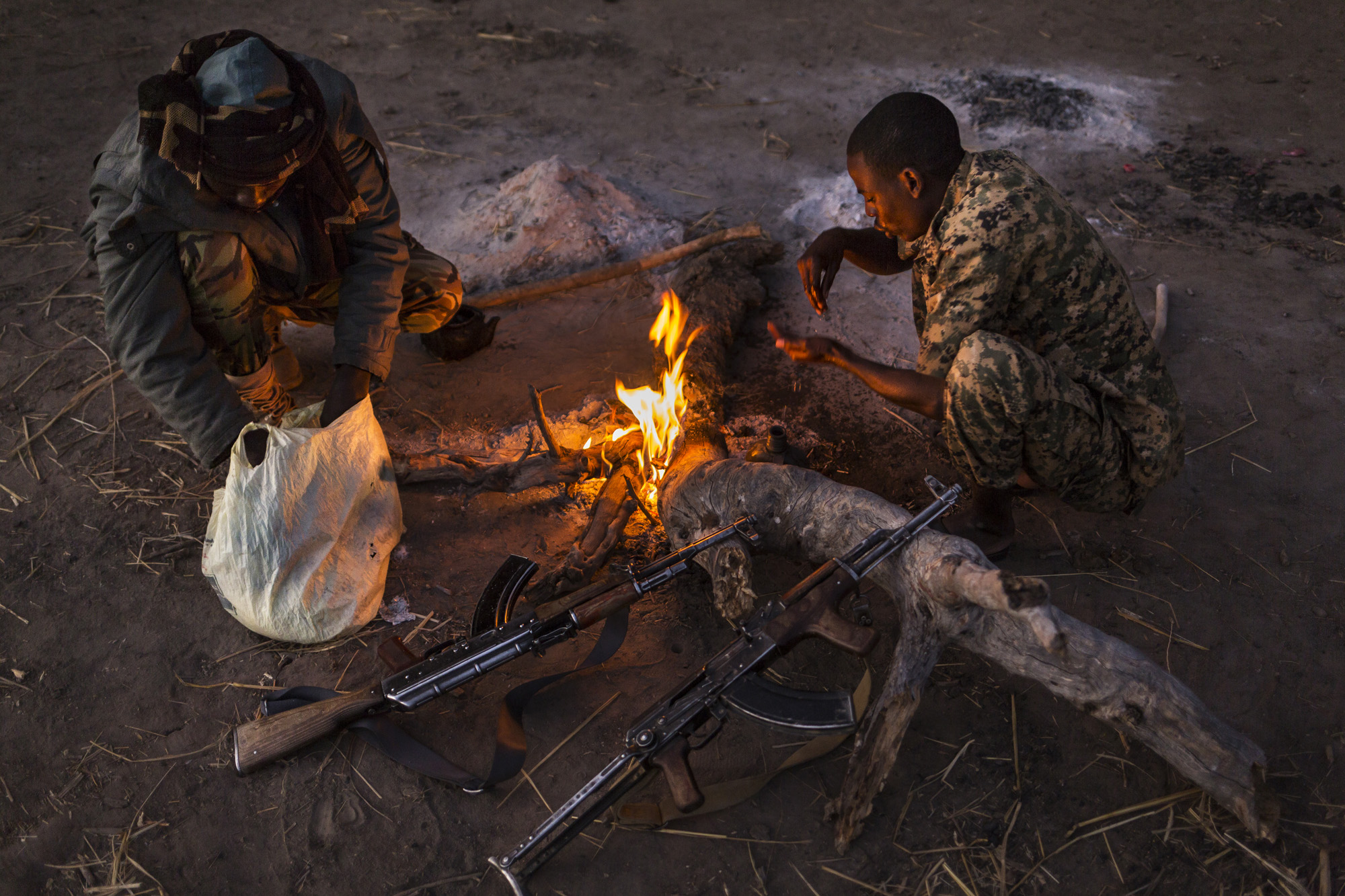
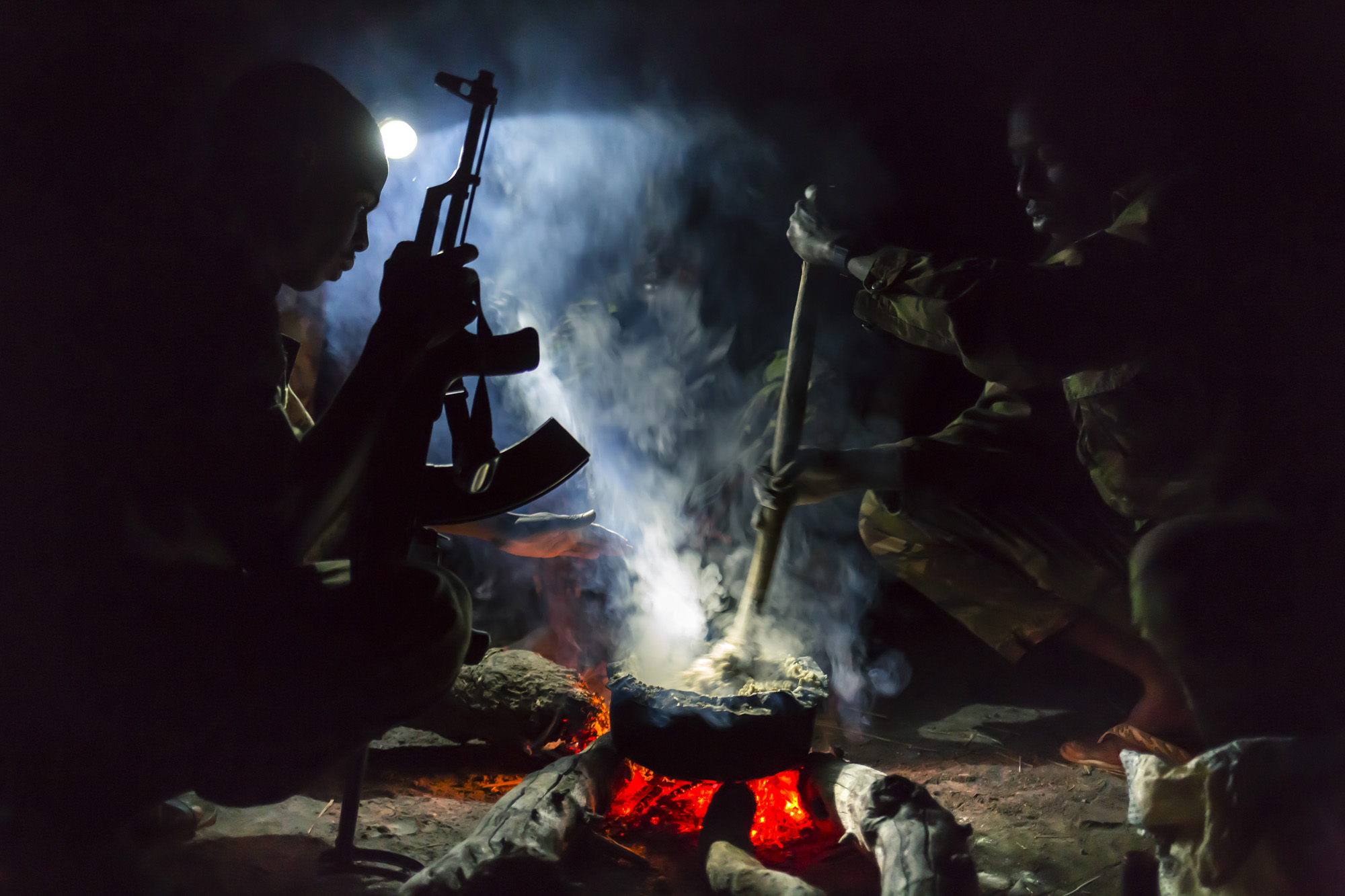

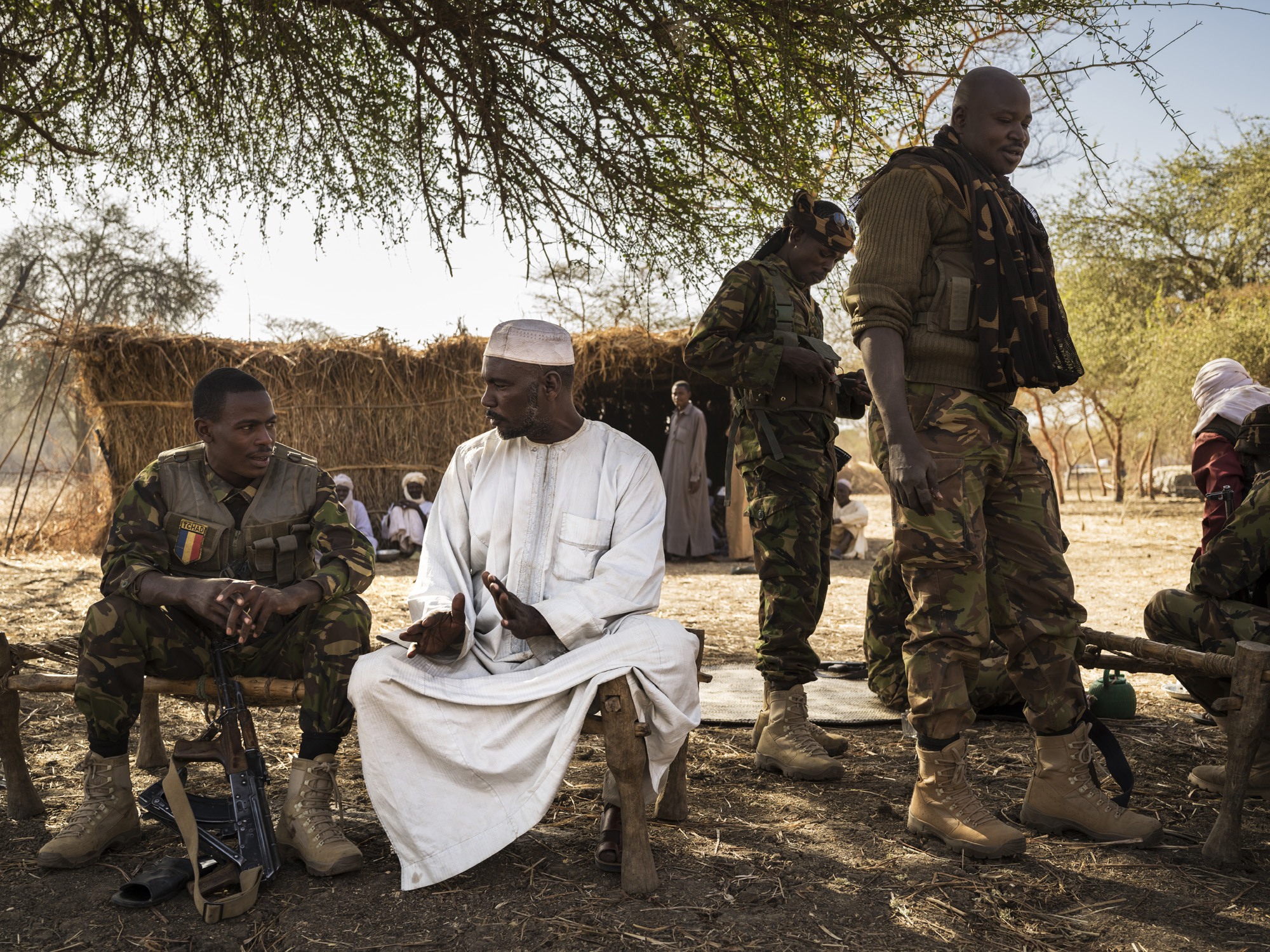
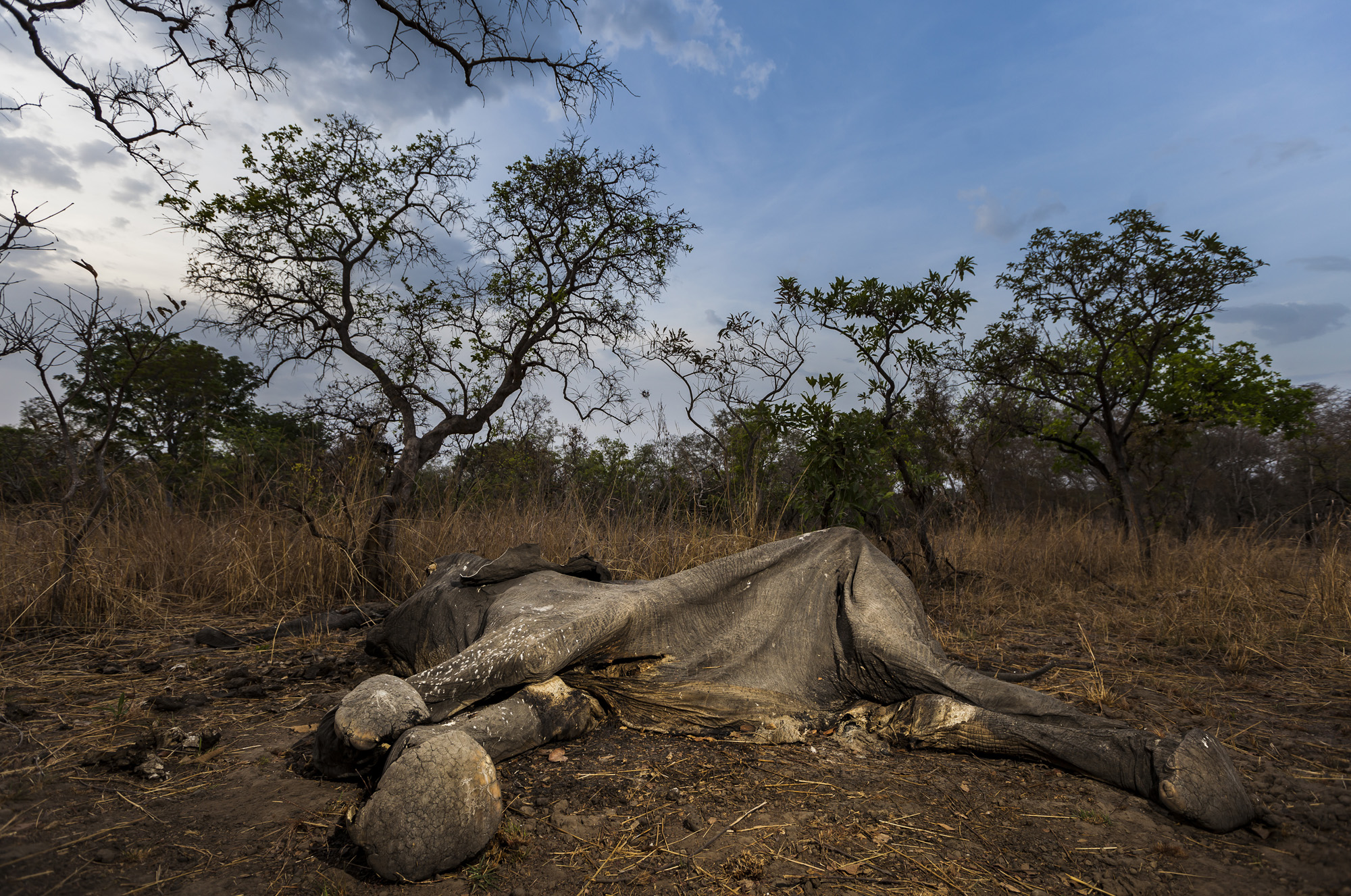
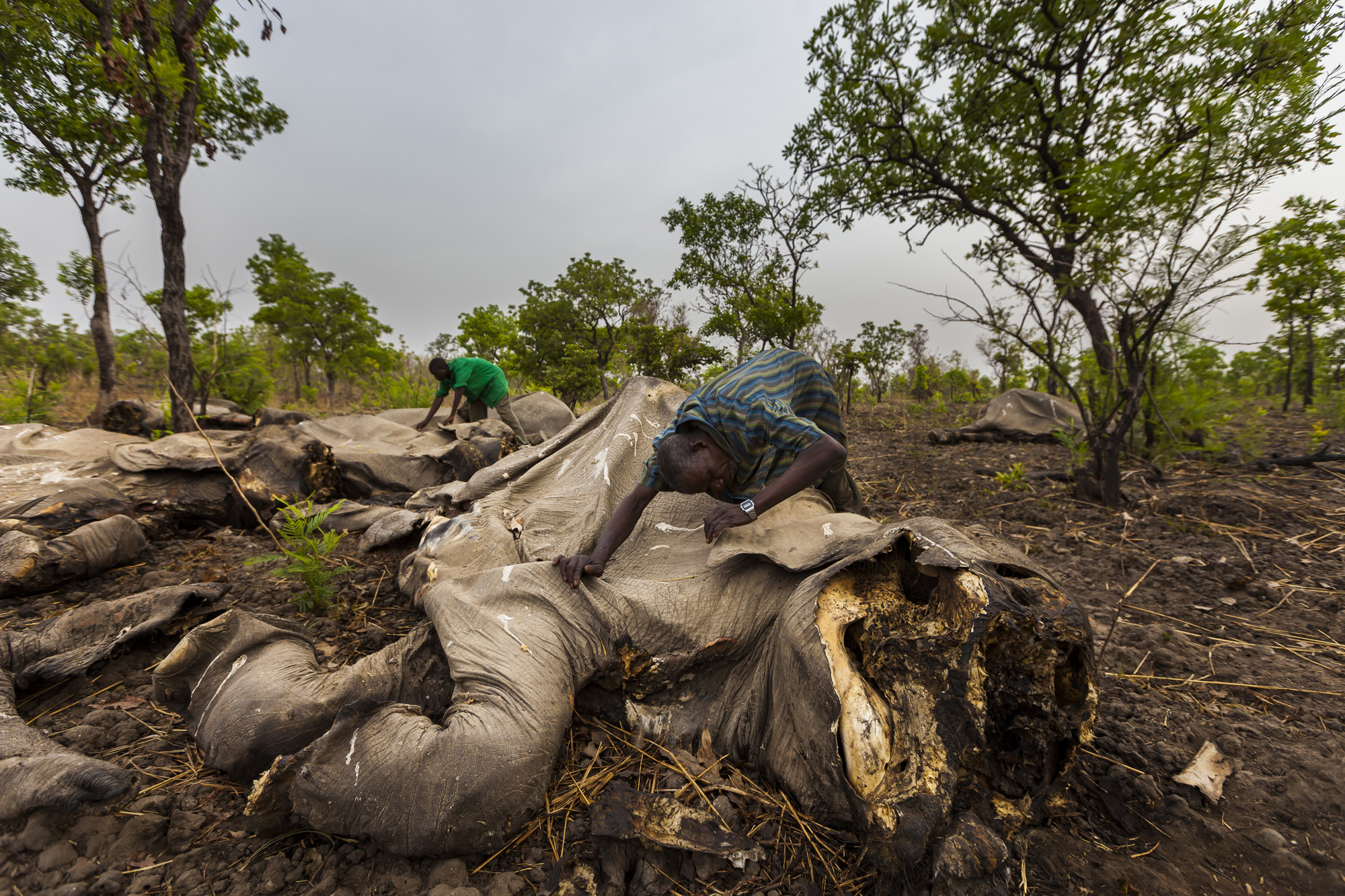
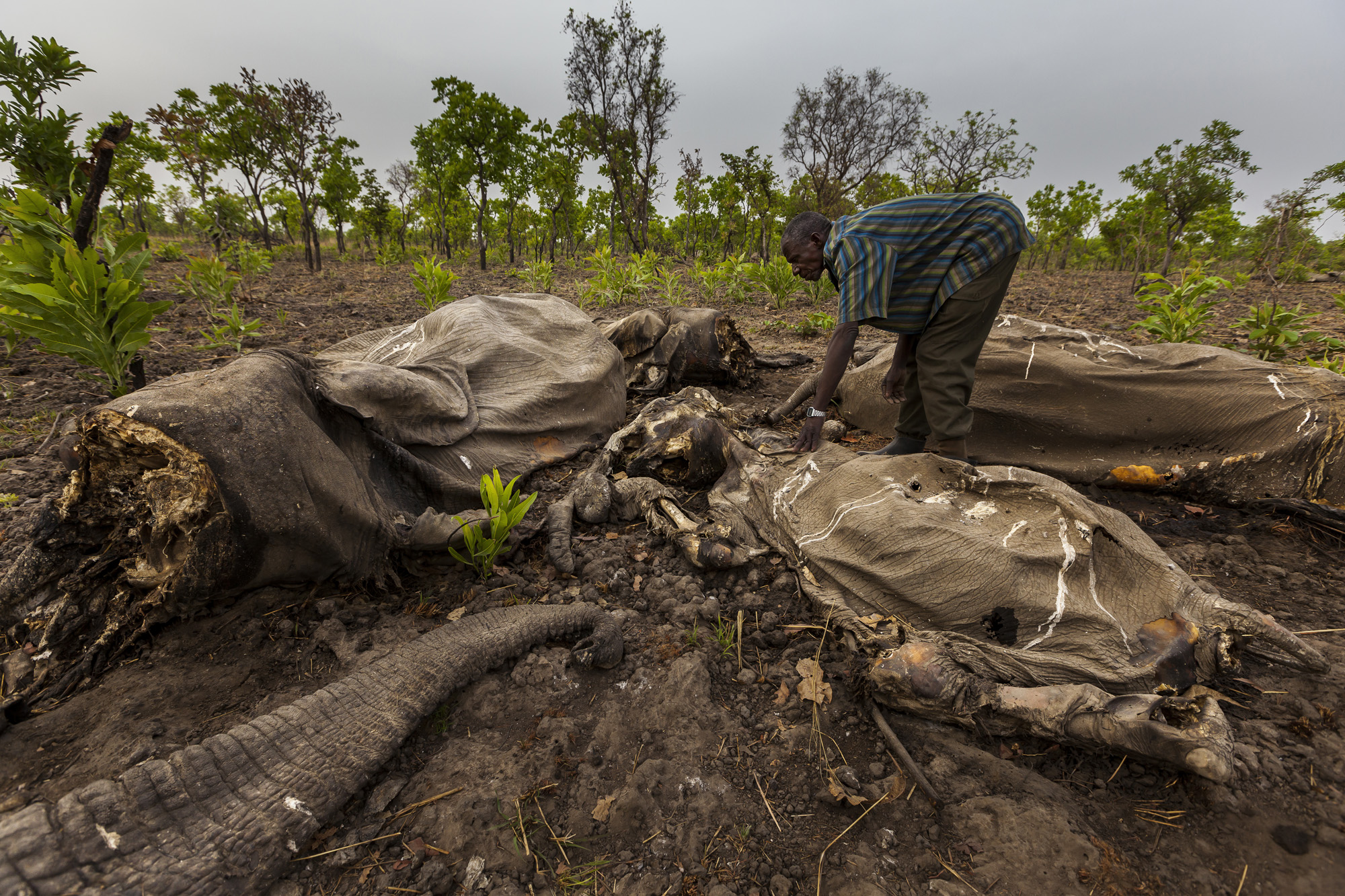
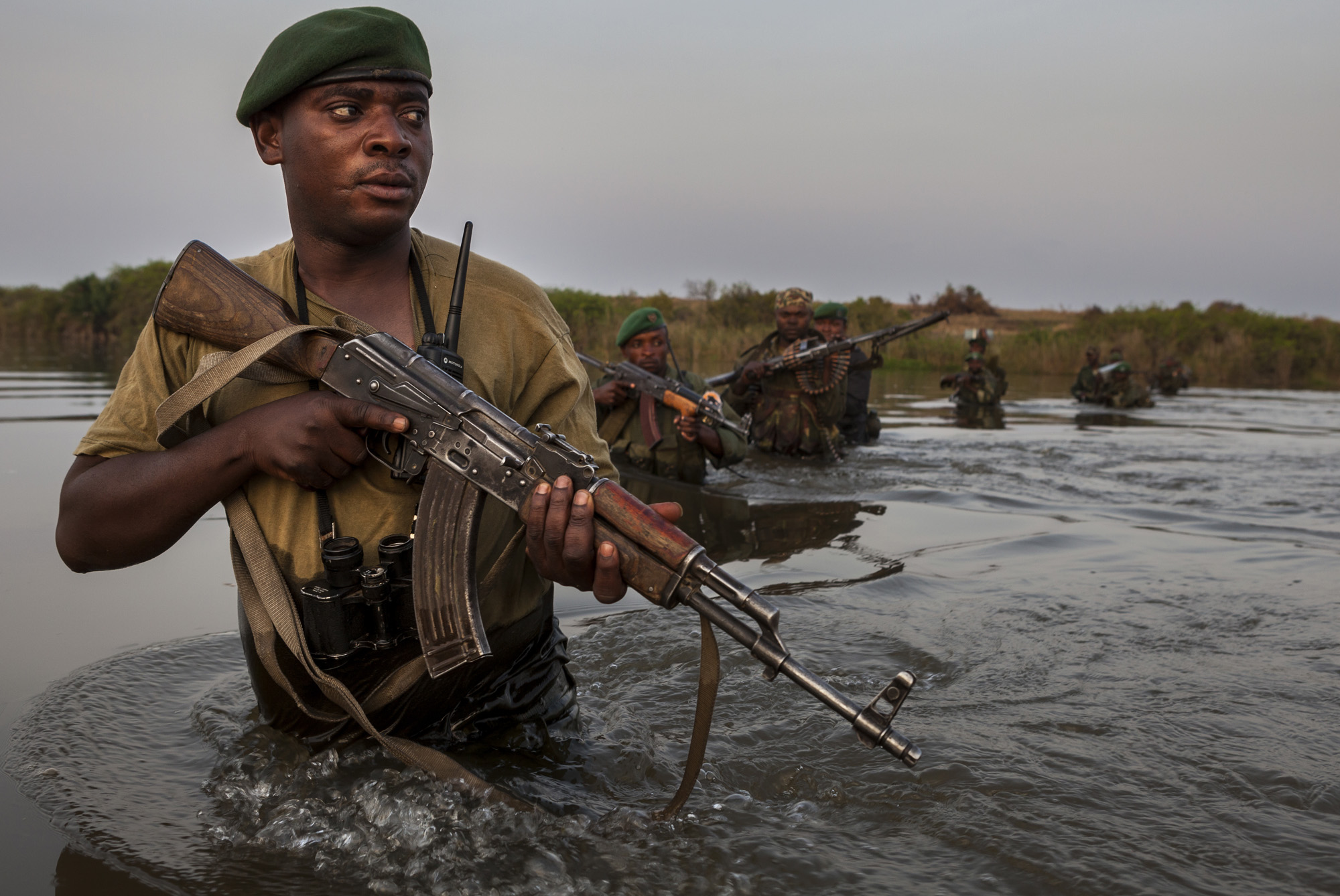
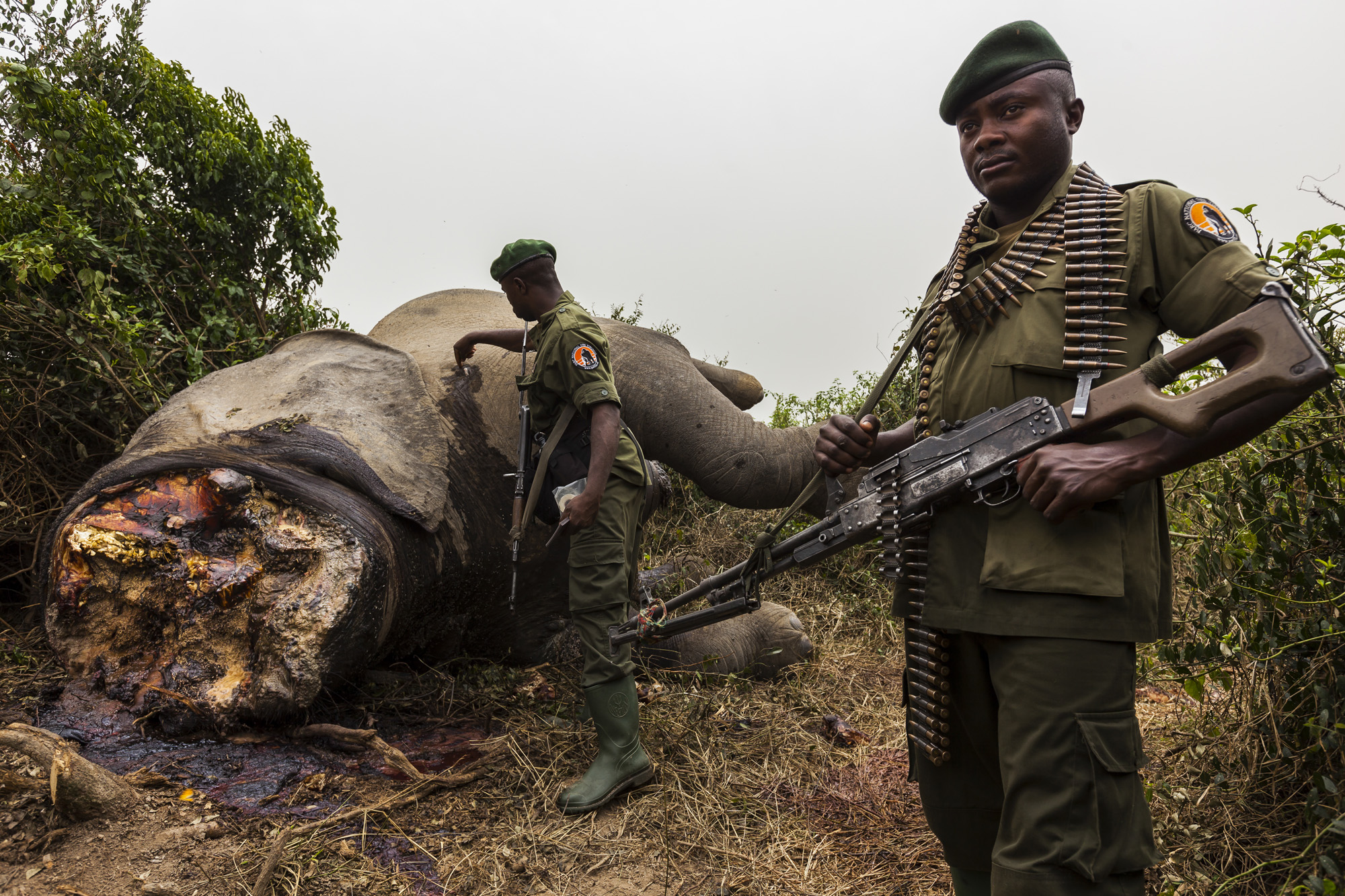
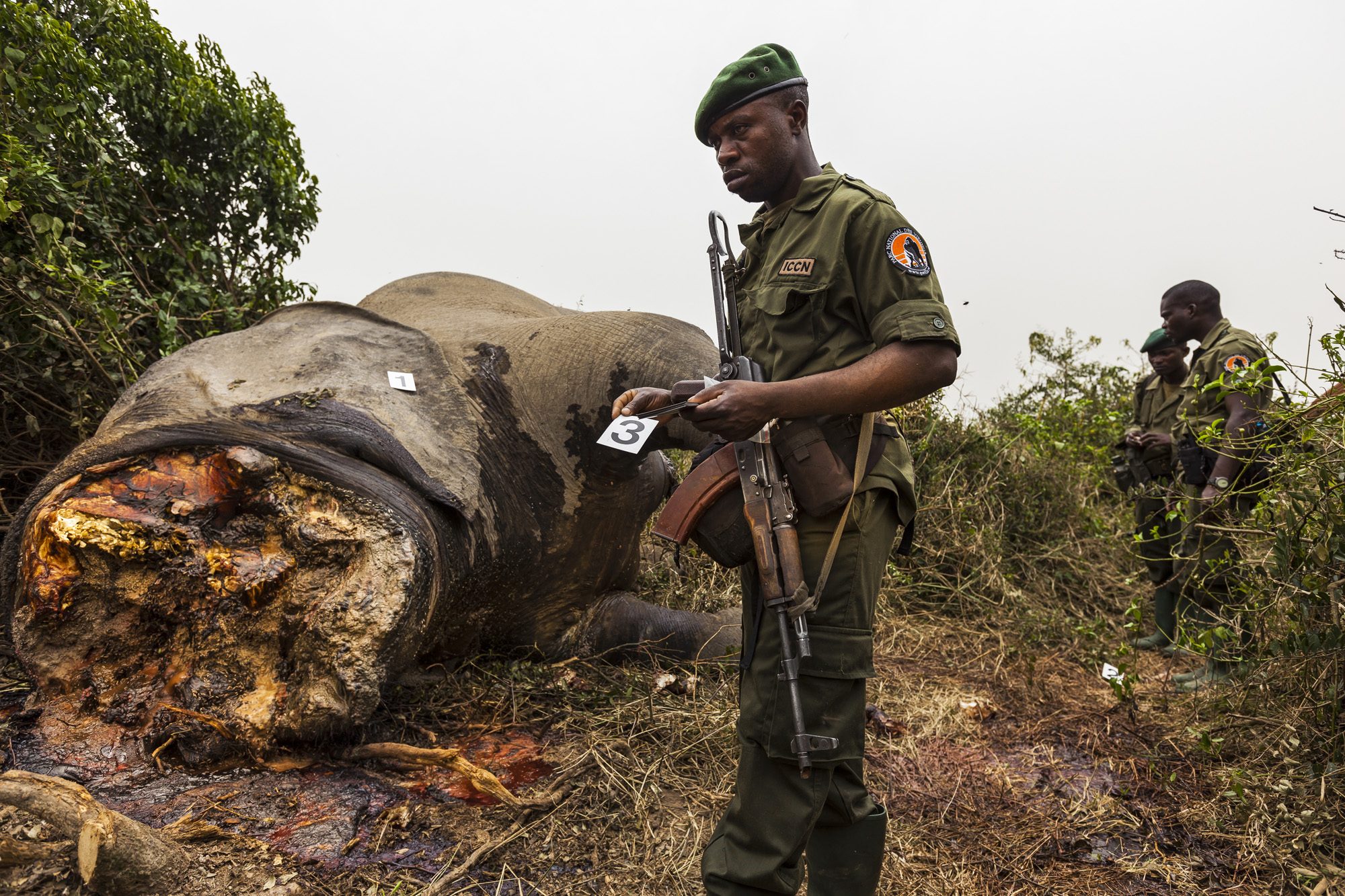
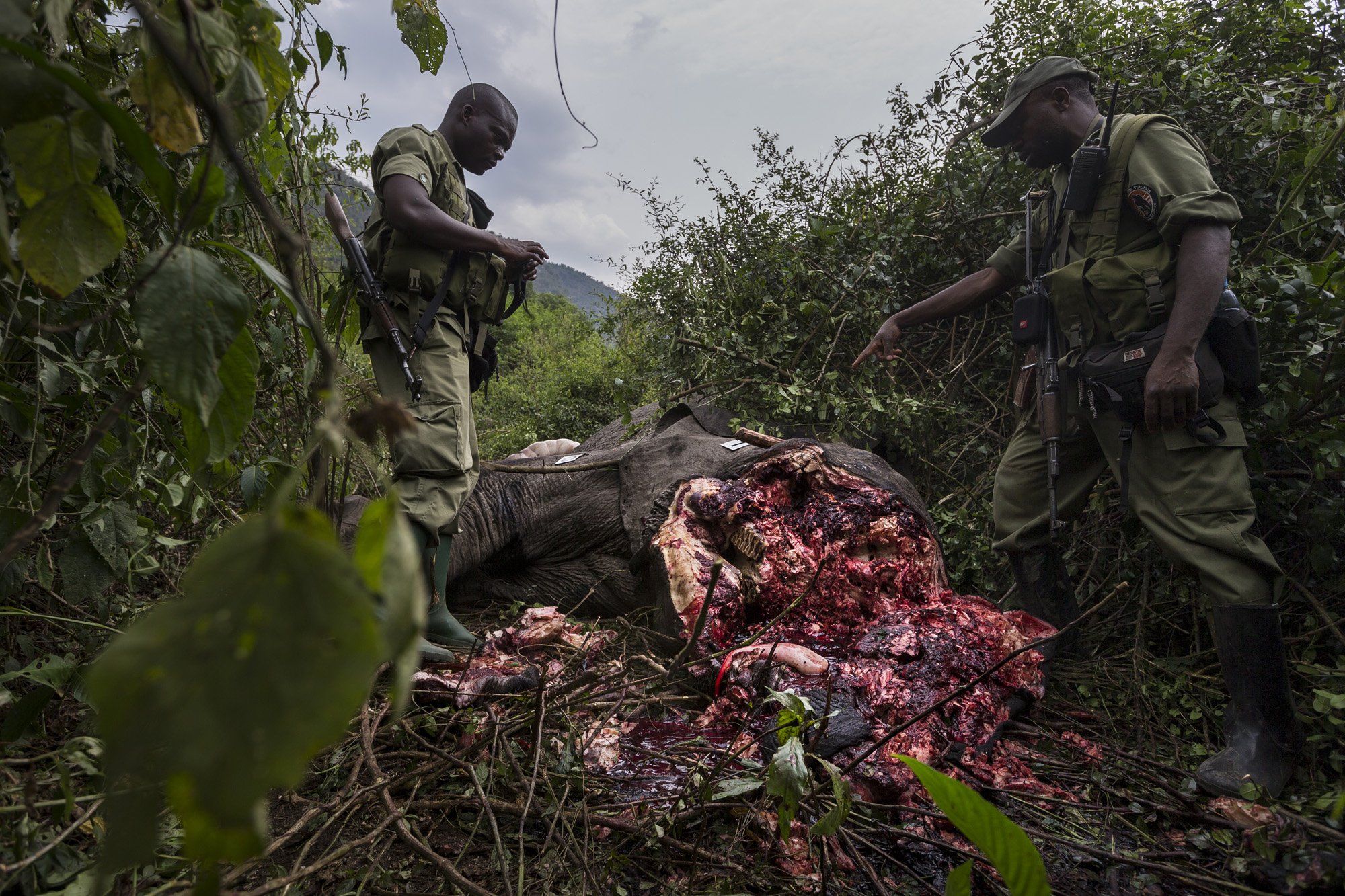
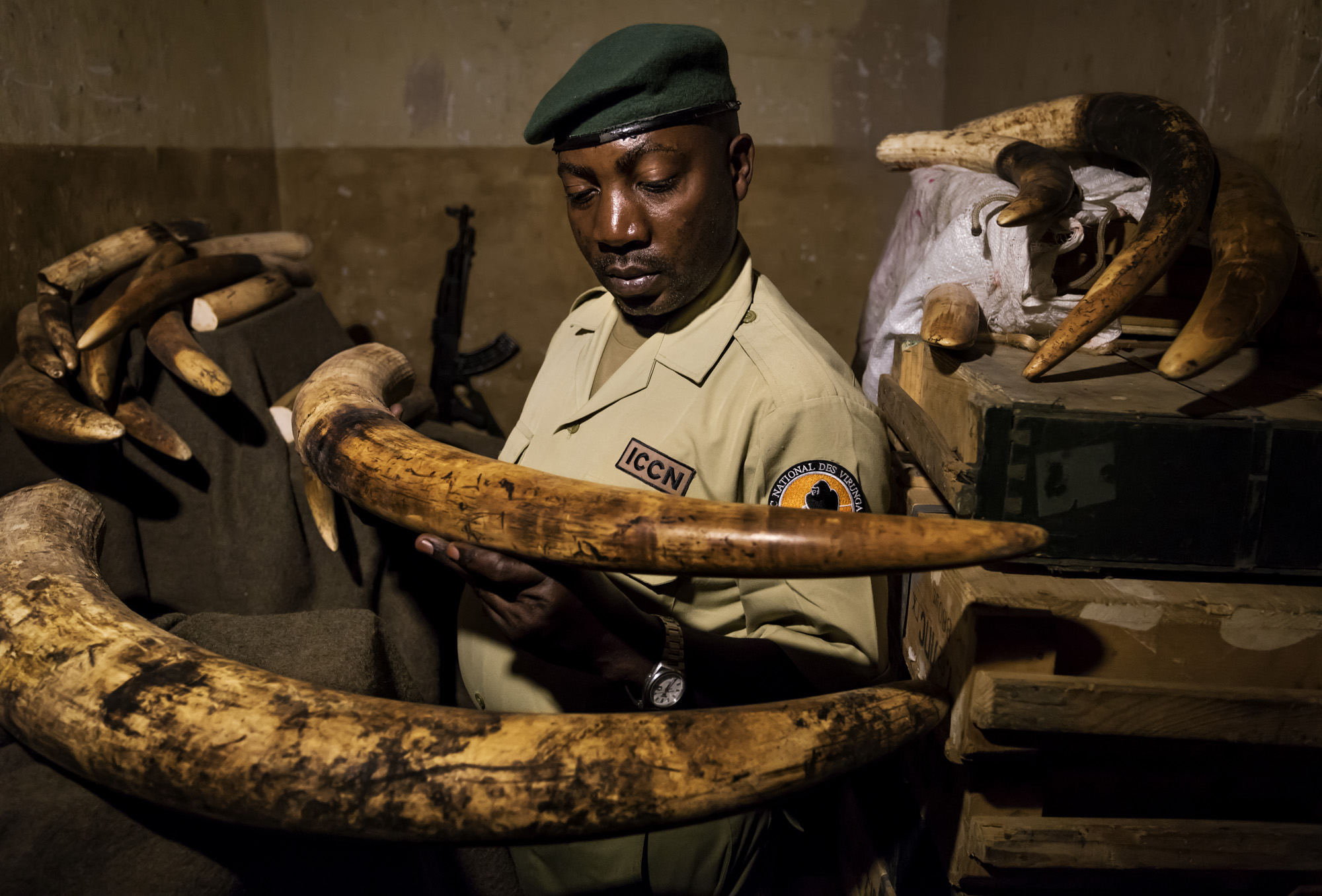
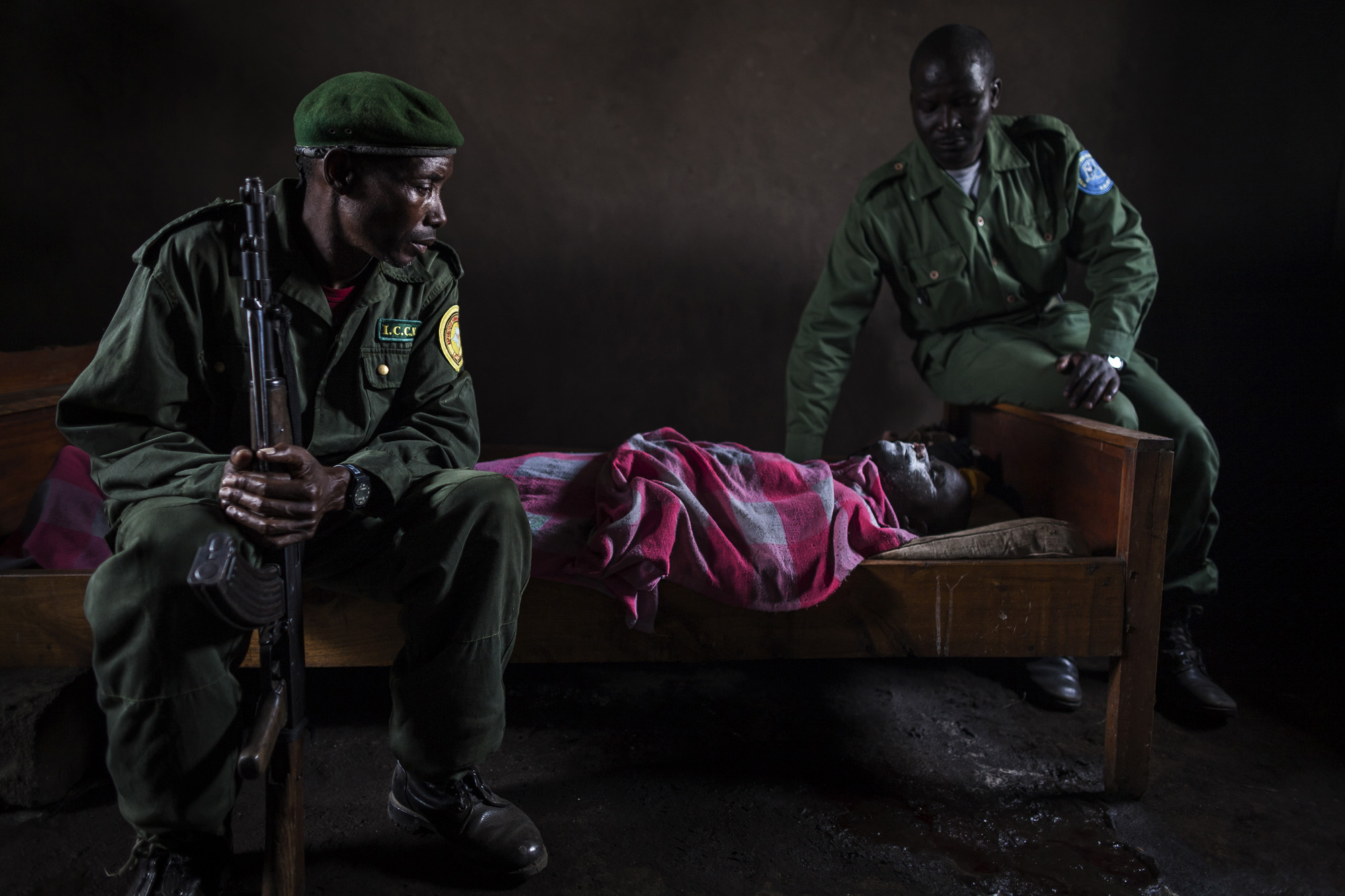

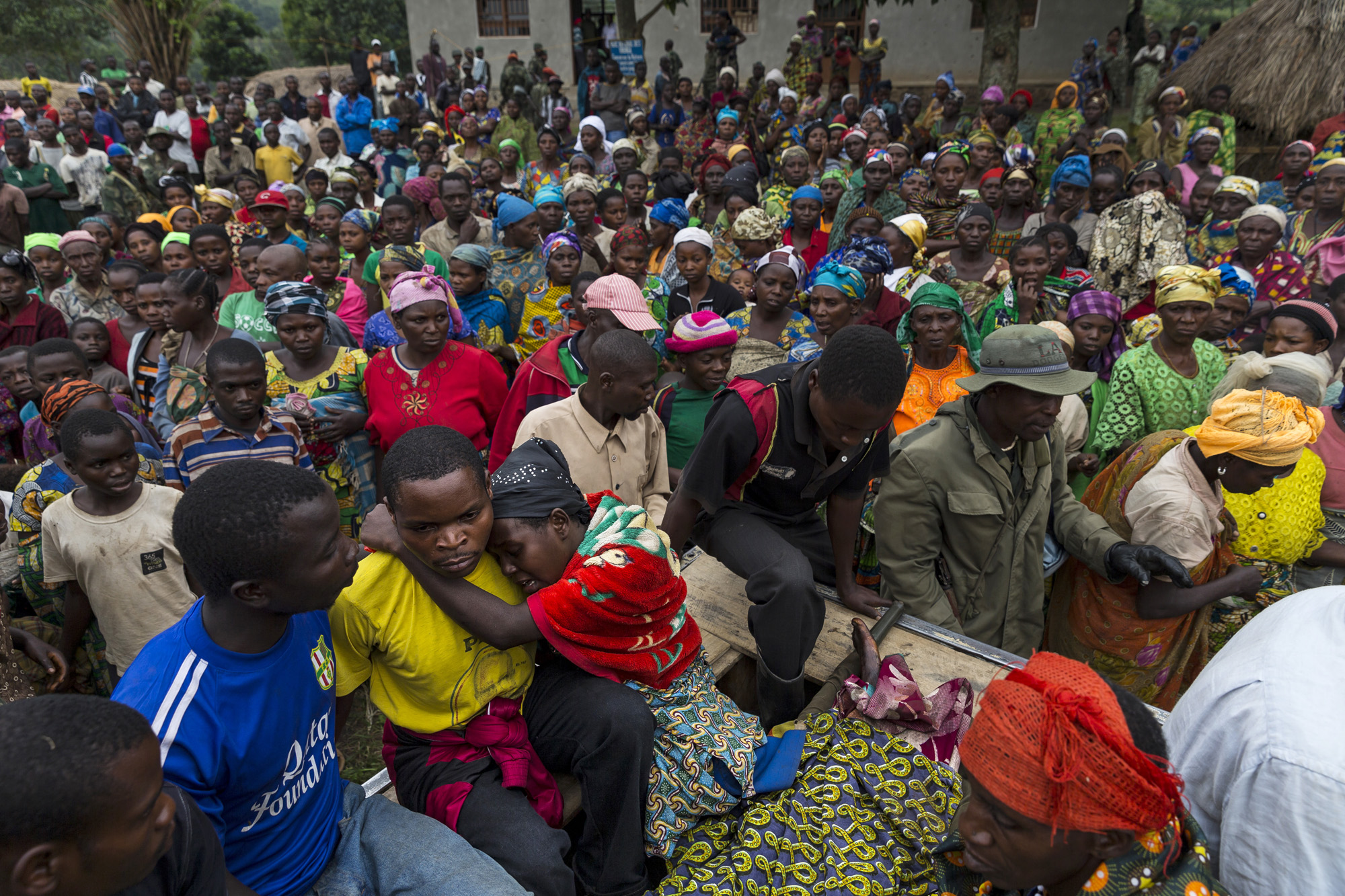
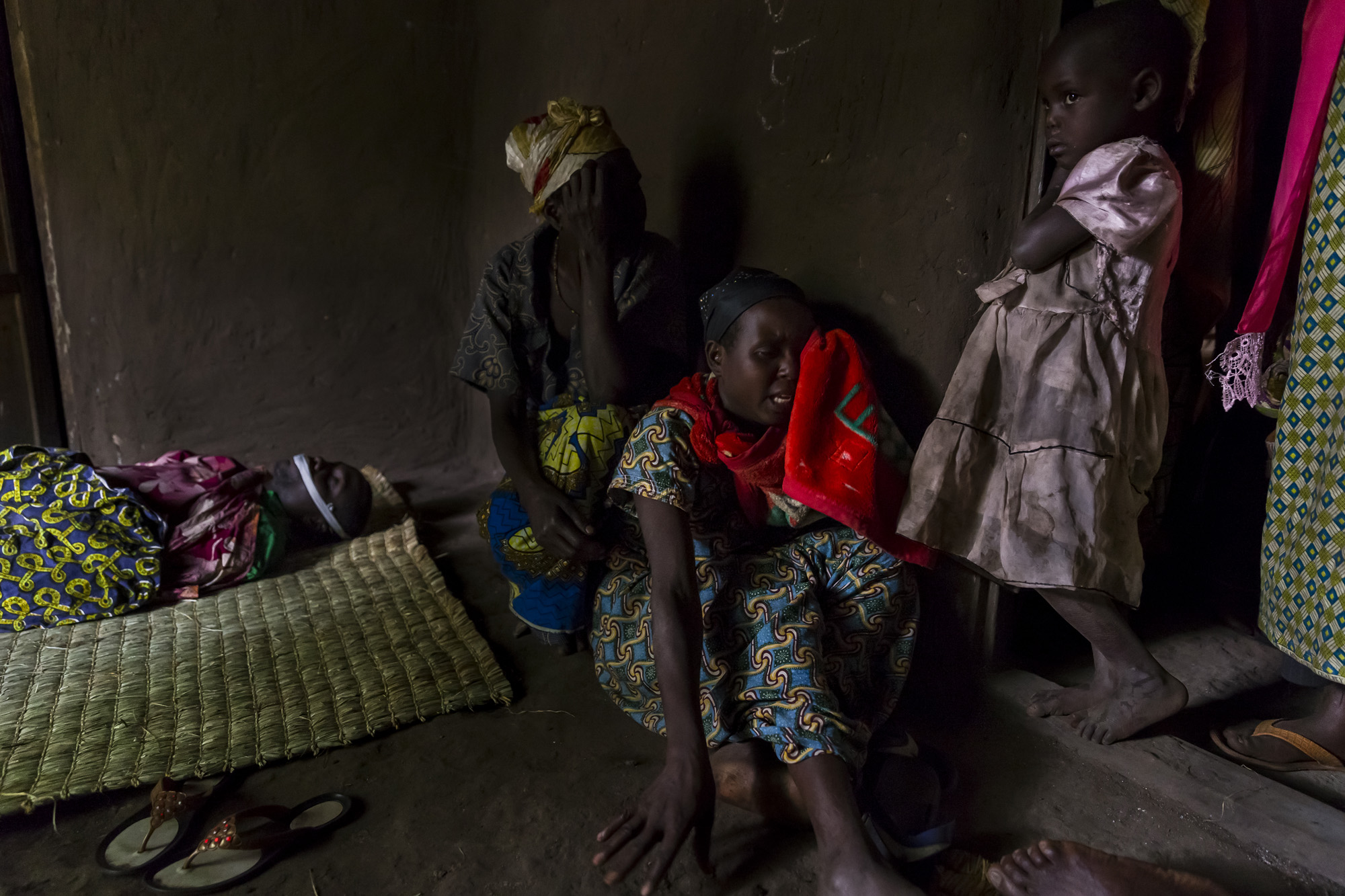
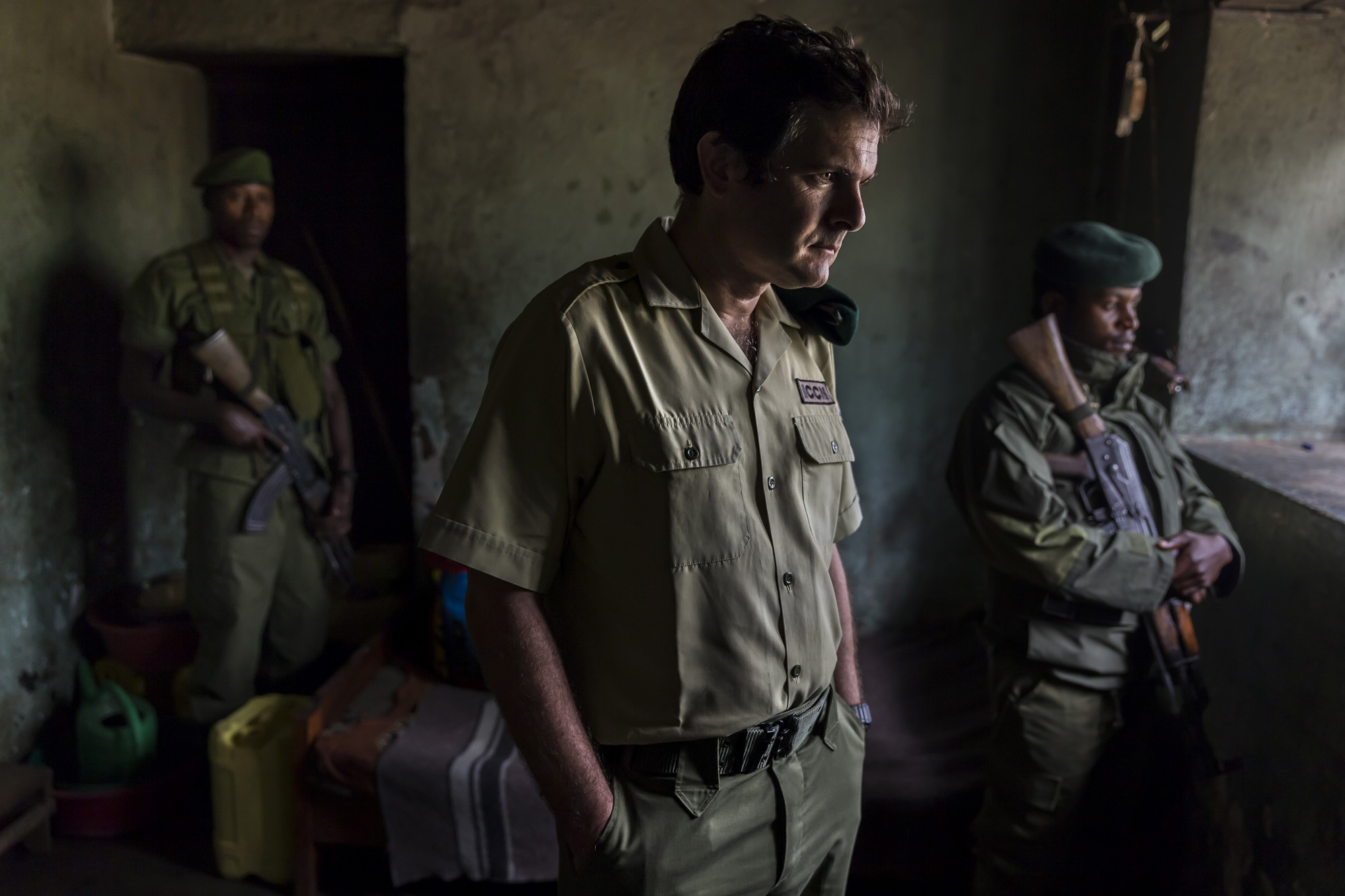
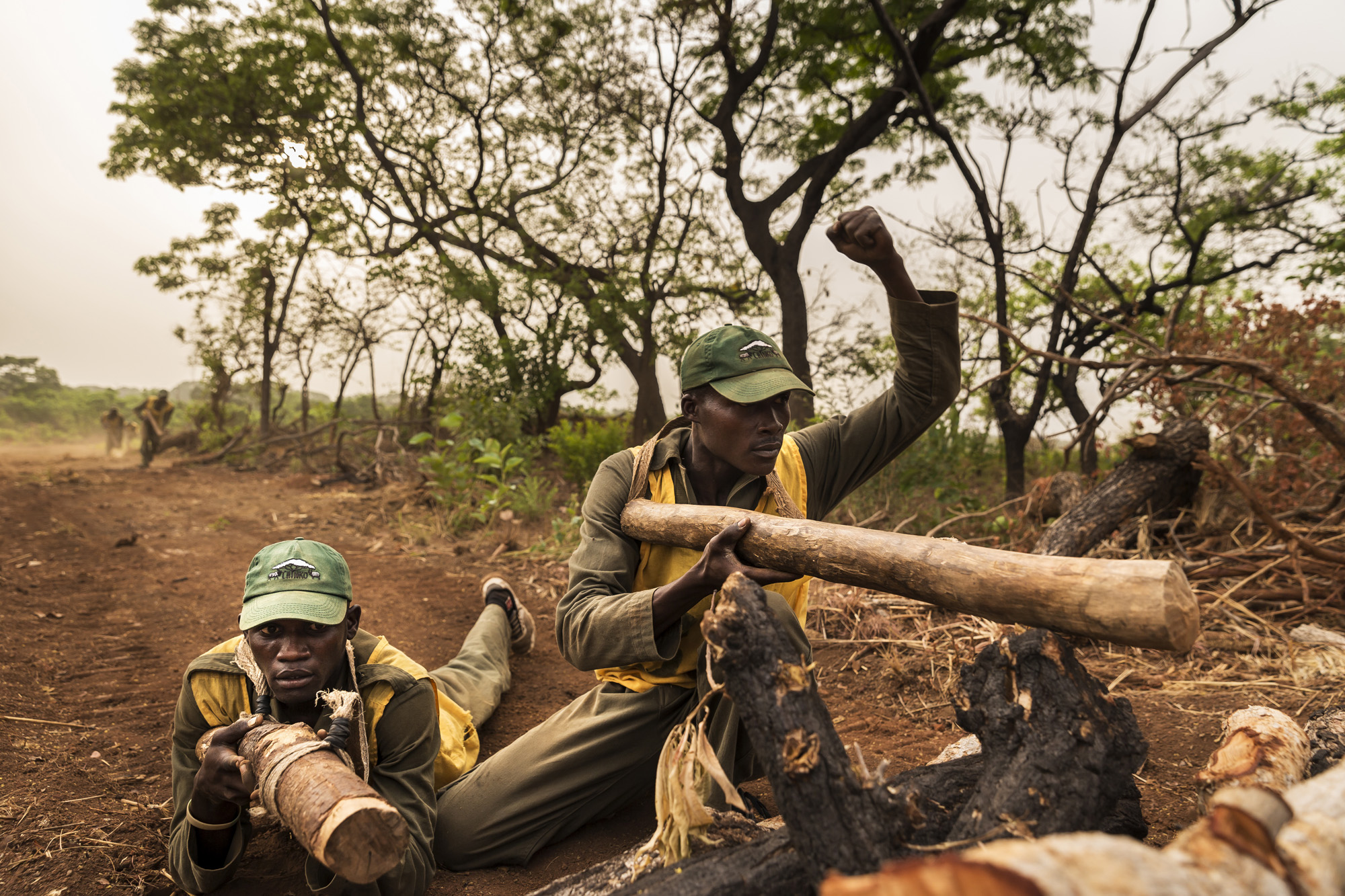

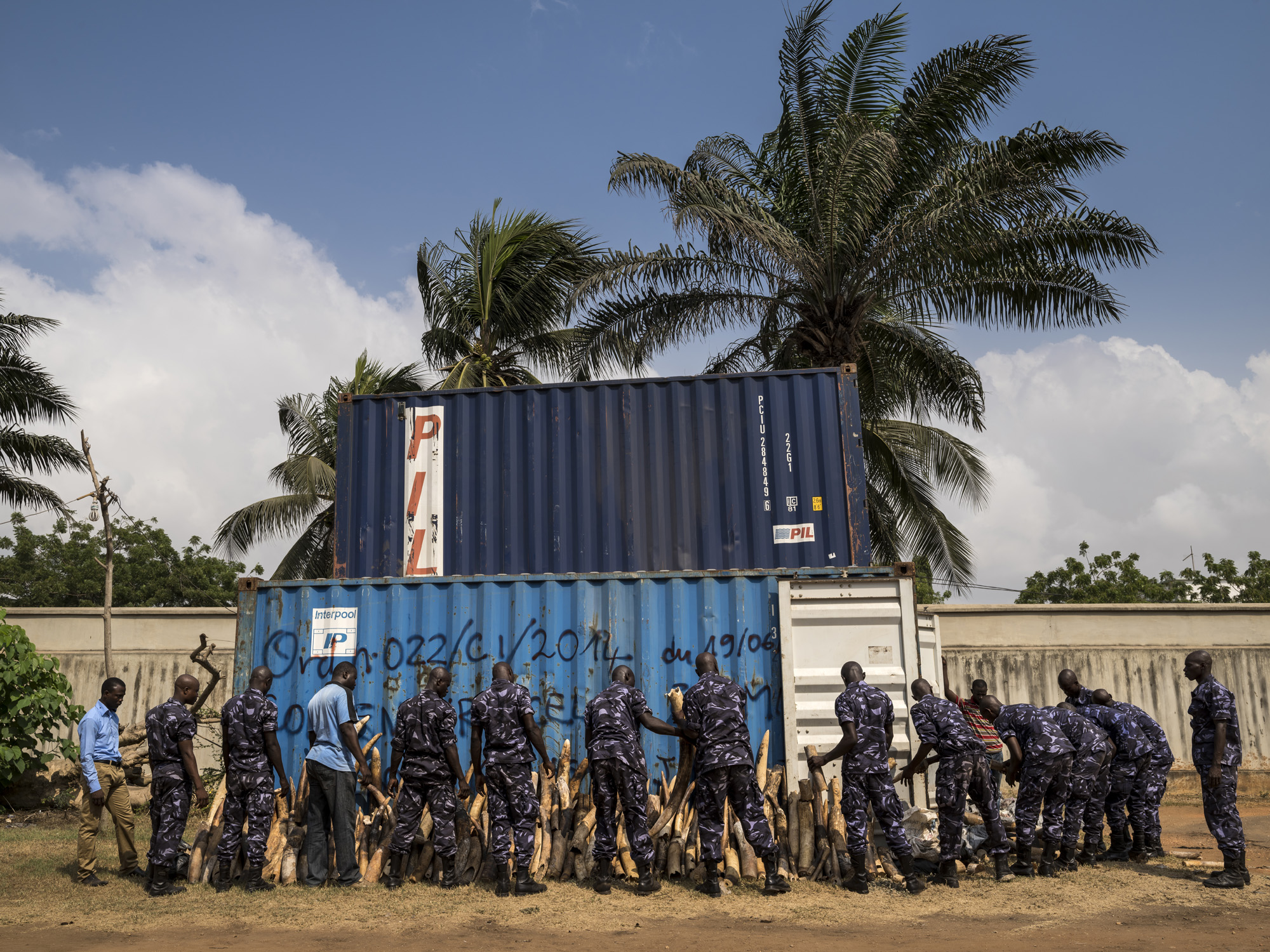


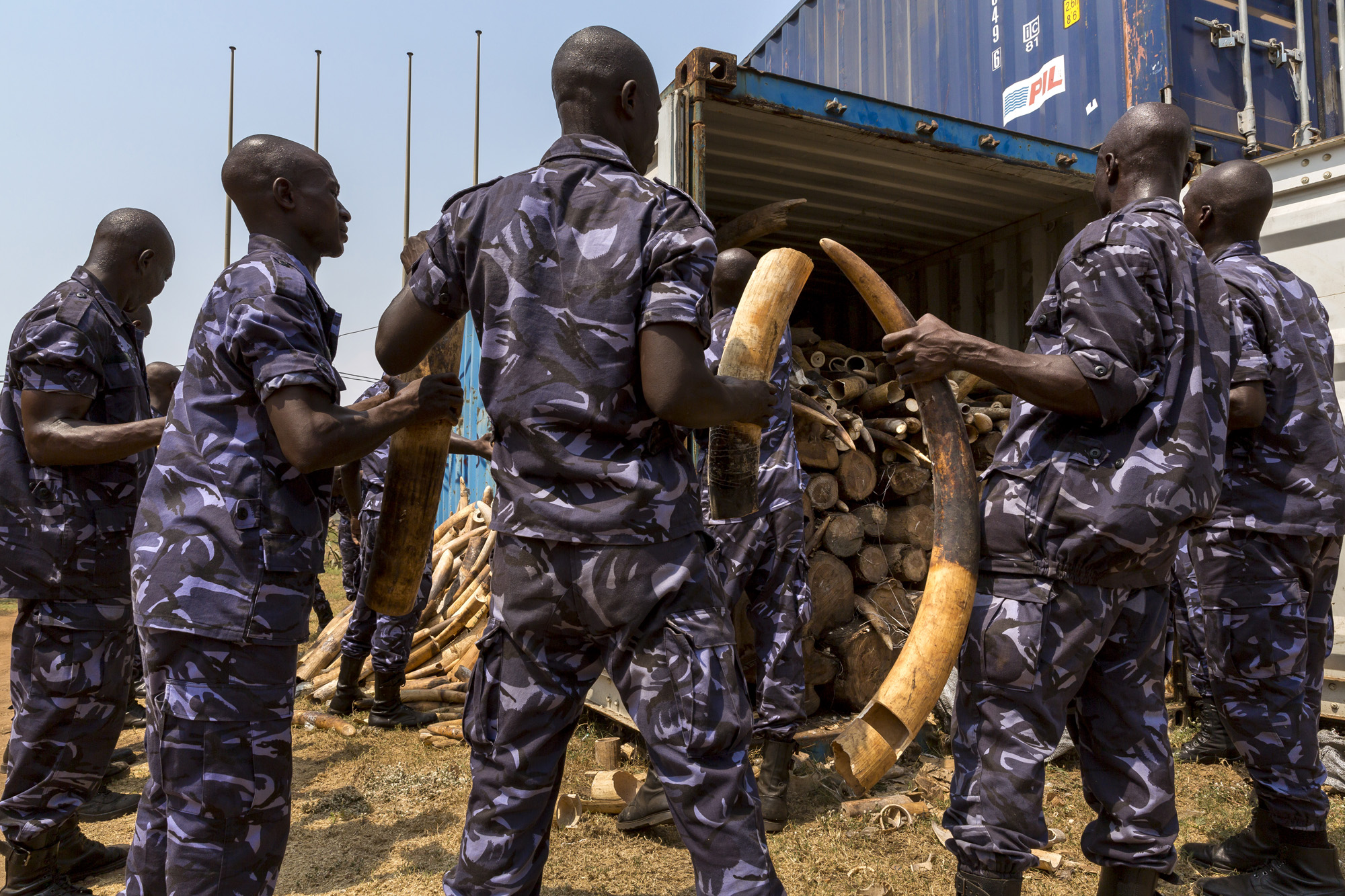
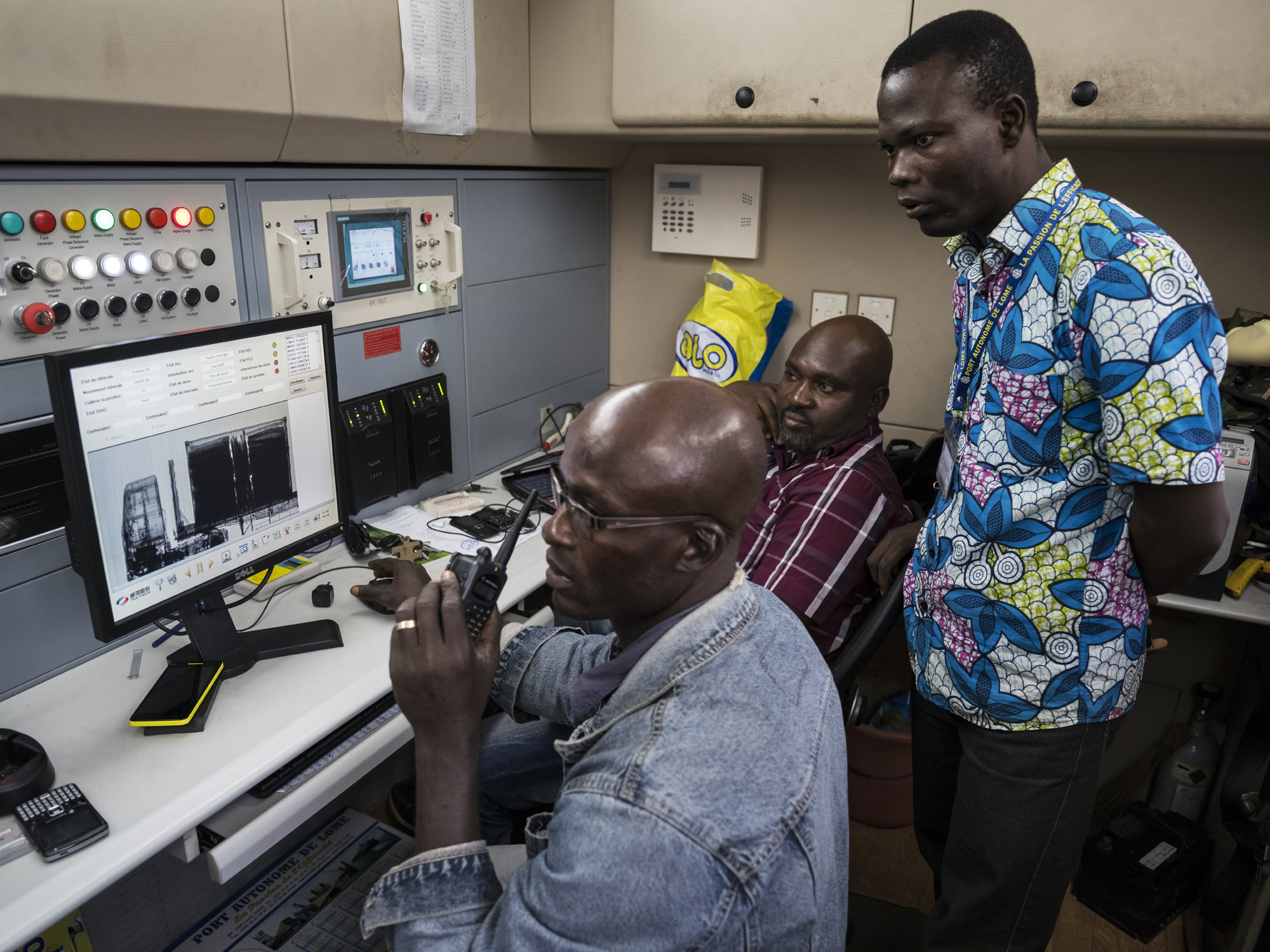
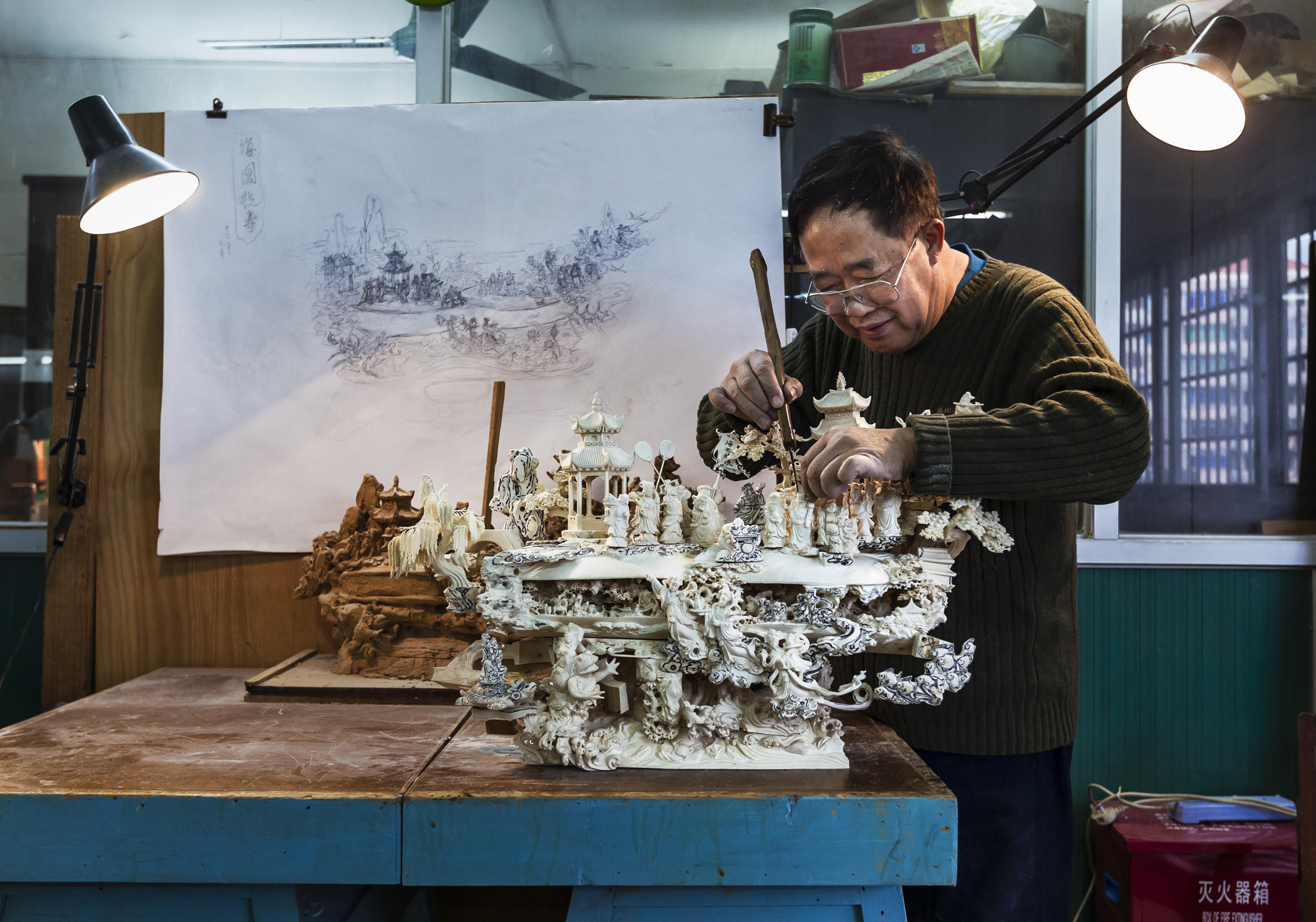
ZAKOUMA NATIONAL PARK, CHAD, 6 JANUARY 2015: A view of the largest herd of elephants in Zakouma National Park, around 400 elephants all moving towards drinking water close to the headquarters of the park. These herds used to be as large as 1000 animals all moving together, severe poaching over the last decade saw that number decimated and now only around 20% of the number remains. Figures of 4300 elephants in 2002 were reduced to 450 in a 2011 survey. Since 2011 however there has been control over poaching and there has not been a single elephant poached in the last 2 years. The president of Chad, Idris Deby, is a strong supporter of the park and Zakouma is on the upsurge in terms of its elephant population once again. (Photo by Brent Stirton/Reportage for National Geographic Magazine.)
NZARA, SOUTH SUDAN, 17 NOVEMBER 2014: Michael Oryem, 29, is a former Lord's Resistance Army fighter who was involved in the poaching of Ivory in Garamba National Park in the Democratic Republic of Congo, a former base of operations for the LRA and a major source of financing for the notorious group. Oryem was abducted by the group when he was 9 and lived with them for over 17 years in the wild. He was made a commander in the group at the age of 12. The LRA is infamous for the killing and abduction of thousands of civilians across multiple countries. He defected and is now a member of the Ugandan Army, UPDF, African Union force hunting the LRA. he is seen with 2 of six pieces of ivory which he hid and then led the Ugandan forces to inside the border region of the Central African Republic. He claims that the LRA killed many elephants in Garamba and he was ordered by Joseph Kony, the groups notorious leader, to bring the ivory to him in Darfur, South Sudan. Ivory is now a real means of financing for the LRA, it is used for both food and weapons supplies and is traded to the Sudanese Army who transports it north to Khartoum. (Photo by Brent Stirton/Reportage by Getty Images for National Geographic Magazine.)
GARAMBA NATIONAL PARK, DEMOCRACTIC REPUBLIC OF CONGO, 12 NOVEMBER 2014: ICCN Ranger officer Mambo inside the ivory storage locker at Garamba National Park in the DR Congo. This ivory is the prize that notorious rebel group the Lord's Resistance Army, LRA, comes looking for in Garamba. Killing elephants for their ivory is an order direct from the LRA's sociopathic leader Joseph Kony, a man wanted by the International Criminal Court for crimes against Humanity. Rangers in Garamba find themselves up against a heavily armed LRA in their battle to save Garamba's elephant. As pressure has increased on Kony, the LRA has turned to Ivory as one means of sustaining themselves in their decades long bush war against the civilians of Uganda, Congo and the South Sudan/CAR region. (Photo by Brent Stirton/Reportage by Getty Images for National Geographic magazine.)
OBO, CENTRAL AFRICAN REPUBLIC, 23 NOVEMBER 2014: A UPDF Ugandan Army African Union soldier holds a digital copy of a dairy from former Lord's Resistance Army Brigadier General Vincent Binany Okumu. Okumu was in charge of the LRA's ivory hunting campaign and this diary page, written in the Acholi language, details an order from Joseph Kony, the leader of the LRA, for Okumu to bring him 100 tusks. The Lord's Resistance Army has increasingly looked to ivory as a means of trade for weapons and resupply. The ivory is poached in Garamba National Park in the Democratic Republic of Congo and taken by various LRA groups to Kony's location in the border area of Darfur in Sudan. In 2012 Vincent Okumu transported a documented 42 tusks to Darfur from Garamba and recent LRA defectors have repeatedly confirmed that another 52 are in transit to Darfur at this time. Vincent Okumu was killed in a Ugandan Army ambush in Central African Republic in 2013, this diary was recovered and translated, providing conclusive proof of the LRA's increasing reliance on Ivory as a means of financing their terror movement. (Photo by Brent Stirton/Reportage by Getty Images for National Geographic Magazine.)
Border Region Democratic Republic of Congo and Central African Republic, 20 March 2015: Ugandan forensics experts exhume the body of Lt General Okot Odhiambo, number two in command of the Lord's Resistance Army. Odhiambo was long known as Jospeh Kony's enforcer, Kony appointed Odhiambo as the head of his Ivory campaign, a major source of funding for the LRA out of the DRC's Garamba National Park. He was shot and critically wounded by Ugandan forces while returning from an Ivory hunt in the Park. Defectors from his group say he died a few weeks later from his wounds. Odhiambo's death is seen as a significant weakening of the LRA.
OBO, CENTRAL AFRICAN REPUBLIC, 16 NOVEMBER 2014: Laren Poole, operations officer for the Bridgeway Foundation, a foundation dedicated to the end of the Lord's Resistance Army, LRA, the notorious terror organization led by Joseph Kony, airdrops thousands of postcards over the LRA area of C.A.R with a message to the fighters to come home and they will be treated well. Kony and his men have killed and abducted thousands of people over the last 4 decades. (Photo by Brent Stirton/Reportage by Getty Images for National Geographic Magazine.)
GARAMBA NATIONAL PARK, DEMOCRATIC REPUBLIC OF CONGO, 10 NOVEMBER 2014: Long time Africa Parks conservation Ranger Kumboyo Kobango Dieudo Onme, 62, is seen with his son Genekpio inside a damaged store room at the Park HQ for Garamba National Park. On 22 December 2008 Genekpio was abducted by notorious rebel group the Lord's Resistance Army, LRA, from his local village in Nagero, close to the Park. The LRA is notorious for these abductions, taking women and girls as cooks and sex slaves and young men and boys as porters and reinforcement fighters. The LRA took Genekpio and others and moved toward the Central African Republic, South Sudan border area. He saw the LRA attack another two villages in this time, killing multiple innocents and abducting 4 more children. He was also beaten on a daily basis and forced to watch the execution of other abductees as a lesson to the others not to try to escape. After 4 months, this LRA group was attacked by a force from the Ugandan Peoples Defence Force, UPDF. Genekpio was wounded 3 times in the leg in this attack but ultimately was rescued by the UPDF and returned to his family in Nagero. His Ranger father has had regular contacts with the LRA as they poach ivory in Garamba National Park and is still very angry about the abduction of his son. "It is better if they had taken me, I would have died to protect my son. Now I search for LRA on every patrol. If I see them they must die." This is an increasing issue for conservation's protectors as they find they are increasingly not only protecting wild areas and animal but also local populations for rebel groups acting with impunity in their areas. (Photo by Brent Stirton/Reportage by Getty Images for National Geographic Magazine.)
GARAMBA NATIONAL PARK, DEMOCRATIC REPUBLIC OF CONGO, 10 NOVEMBER 2014: Long time Africa Parks conservation Ranger Kumboyo Kobango Dieudo Onme, 62, is seen with his son Genekpio inside a damaged store room at the Park HQ for Garamba National Park. On 22 December 2008 Genekpio was abducted by notorious rebel group the Lord's Resistance Army, LRA, from his local village in Nagero, close to the Park. The LRA is notorious for these abductions, taking women and girls as cooks and sex slaves and young men and boys as porters and reinforcement fighters. The LRA took Genekpio and others and moved toward the Central African Republic, South Sudan border area. He saw the LRA attack another two villages in this time, killing multiple innocents and abducting 4 more children. He was also beaten on a daily basis and forced to watch the execution of other abductees as a lesson to the others not to try to escape. After 4 months, this LRA group was attacked by a force from the Ugandan Peoples Defence Force, UPDF. Genekpio was wounded 3 times in the leg in this attack but ultimately was rescued by the UPDF and returned to his family in Nagero. His Ranger father has had regular contacts with the LRA as they poach ivory in Garamba National Park and is still very angry about the abduction of his son. "It is better if they had taken me, I would have died to protect my son. Now I search for LRA on every patrol. If I see them they must die." This is an increasing issue for conservation's protectors as they find they are increasingly not only protecting wild areas and animal but also local populations for rebel groups acting with impunity in their areas. (Photo by Brent Stirton/Reportage by Getty Images for National Geographic Magazine.)
GARAMBA NATIONAL PARK, DEMOCRACTIC REPUBLIC OF CONGO, 12 NOVEMBER 2014: ICCN Ranger widow Lucienne Alebhako Lanziwa is photographed at her sparse home in Garamba National Park, DR Congo. Lucienne, 41, lost her husband, an officer in the ICCN conservation rangers of Garamba, to a brutal LRA attack on the Ranger HQ on January 2, 2009. The attack occured around 4pm, with the LRA arriving in force and indiscriminately gunning down park personel. Lucienne's husband, Atolobako Vukoyo, was arrested by the LRA while wounded and, along with other abductees, taken to one of their camps a short distance away. The LRA questioned the abductees, repeatedly asking who were the children of Rangers and who were Rangers. They complained bitterly that the Rangers made their poaching work difficult in the park. The LRA took Lucienne's husband to make an example of him. They beat him to death in front of the abductees but tortured him severely first. When the other rangers and UPDF troops were able to find the LRA camp, they found only enough pieces of Lucienne's husband to fit in a small child's coffin. Lucienne was left with five children, including a new born baby and no income. A one off compensation payment of $400 was taken entirely by her husband's family and nothing given to her as his wife and the mother of his 5 children. Only recently have the ICCN spoken to her about a compensation salary of $10 a month. Considering it takes over $100 a year to educate one child, Lucienne has no alternative but a pitiful subsistence existence for her and her children. Lucienne's husband was not the only Ranger killed in the attack. This is only one example of how dangerous it is for so many in the frontline of conservation, an area where more and more Rangers are finding themselves not only combatting subsistence poachers but also heavily armed paramilitary and rebel groups as well as the militaries of various surrounding countries. (Photo by Brent Stirton/Reportage by Getty Images for Nati
GARAMBA NATIONAL PARK, DEMOCRACTIC REPUBLIC OF CONGO, 12 NOVEMBER 2014: Scenes flying over Garamba National Park, DR Congo. The park is a vast area and is difficult terrain to police for a small force of ICCN rangers. The area to the West is the Azzande hunting concession and the preferred route of the LRA into Garamba. There are a number of river crossings and a high number of swamps, all contributing to the difficulty of policing Garamba against a seasoned forced like the LRA, who are used to the bush and toughened by years of living in these conditions. (Photo by Brent Stirton/Reportage by Getty Images for National Geographic magazine.)
GARAMBA NATIONAL PARK, DEMOCRACTIC REPUBLIC OF CONGO, 12 NOVEMBER 2014: ICCN Rangers combine with a Congolese Army platoon for a 21 day mission inside Garamba National Park in the DR Congo. they are on the lookout for poachers, in particular the notorious Lords Resistance Army, the LRA. These poachers are looking for Garamba's elephants. Their ivory is the prize that notorious rebel group the LRA, comes looking for in Garamba. Killing elephants for their ivory is an order direct from the LRA's sociopathic leader Joseph Kony, a man wanted by the International Criminal Court for crimes against Humanity. Rangers in Garamba find themselves up against a heavily armed LRA in their battle to save Garamba's elephant. As pressure has increased on Kony, the LRA has turned to Ivory as one means of sustaining themselves in their decades long bush war against the civilians of Uganda, Congo and the South Sudan/CAR region. (Photo by Brent Stirton/Reportage by Getty Images for National Geographic magazine.)
GARAMBA NATIONAL PARK, DEMOCRACTIC REPUBLIC OF CONGO, 12 NOVEMBER 2014: ICCN Rangers combine with a Congolese Army platoon for a 21 day mission inside Garamba National Park in the DR Congo. they are on the lookout for poachers, in particular the notorious Lords Resistance Army, the LRA. These poachers are looking for Garamba's elephants. Their ivory is the prize that notorious rebel group the LRA, comes looking for in Garamba. Killing elephants for their ivory is an order direct from the LRA's sociopathic leader Joseph Kony, a man wanted by the International Criminal Court for crimes against Humanity. Rangers in Garamba find themselves up against a heavily armed LRA in their battle to save Garamba's elephant. As pressure has increased on Kony, the LRA has turned to Ivory as one means of sustaining themselves in their decades long bush war against the civilians of Uganda, Congo and the South Sudan/CAR region. (Photo by Brent Stirton/Reportage by Getty Images for National Geographic magazine.)
GARAMBA NATIONAL PARK, DEMOCRACTIC REPUBLIC OF CONGO, 12 NOVEMBER 2014: ICCN Rangers combine with a Congolese Army platoon for a 21 day mission inside Garamba National Park in the DR Congo. they are on the lookout for poachers, in particular the notorious Lords Resistance Army, the LRA. These poachers are looking for Garamba's elephants. Their ivory is the prize that notorious rebel group the LRA, comes looking for in Garamba. Killing elephants for their ivory is an order direct from the LRA's sociopathic leader Joseph Kony, a man wanted by the International Criminal Court for crimes against Humanity. Rangers in Garamba find themselves up against a heavily armed LRA in their battle to save Garamba's elephant. As pressure has increased on Kony, the LRA has turned to Ivory as one means of sustaining themselves in their decades long bush war against the civilians of Uganda, Congo and the South Sudan/CAR region. (Photo by Brent Stirton/Reportage by Getty Images for National Geographic magazine.)
OBO, CENTRAL AFRICAN REPUBLIC, 18 NOVEMBER 2014: African Union Ugandan Armed forces, UPDF, train a new battalion at Obo, Central African Republic. The Ugandan contingent as well as the Africom American personel based here are focused on the aprehension of the Lord's Resistance Army, the LRA, the notorious rebel group led by Joseph Kony which has terrorized citizens of Uganda, C.A.R, South Sudan and the Democratic Republic of Congo for the last 4 decades. In recent time the LRA has turned its focus to Ivory as a means of income. This is having a devastating effect on elephant populations everywhere they operate. (Photo by Brent Stirton/Reportage by Getty Images for National Geographic Magazine.)
MBOKI, CENTRAL AFRICAN REPUBLIC, 25 NOVEMBER 2014: Soldiers on patrol from the African Union Ugandan Armed forces, UPDF, base at Mboki, Central African Republic. The Ugandan contingent based here are focused on the aprehension of the Lord's Resistance Army, LRA, the notorious rebel group led by Joseph Kony which has terrorized citizens of Uganda, C.A.R, South Sudan and the Democratic Republic of Congo for the last 4 decades. Soldiers are seen crossing a river, a technique they have perfected with ropes despite the fact that many of the men cannot swim. Captain (Photo by Brent Stirton/Reportage by Getty Images for National Geographic Magazine.)
OBO, CENTRAL AFRICAN REPUBLIC, 18 NOVEMBER 2014: Recent Lord's Resistance Army defector, Michael Onen, photographed at the African Union Ugandan Army base at Obo, Central African Republic. Onen defected after spending 16 years in the LRA after being abducted as a child and taken far from his home village in the DR Congo. The scars on his back are as a result of beatings he received from his LRA captors. He defected on 11 September 2014 as he feared for his life after Joseph Kony, the leader of the LRA, disaproved of a relationship he has with a woman in the LRA. The Ugandan contingent as well as the Africom American personel based here are focused on the apprehension of the Lord's Resistance Army, the notorious rebel group led by Joseph Kony which has terrorized citizens of Uganda, C.A.R, South Sudan and the Democratic Republic of Congo for the last 4 decades. In recent times the LRA has turned its focus to Ivory as a means of income. This is having a devastating effect on elephant populations everywhere they operate. Michael Onen was part of the poaching team operating in Garamba National Park in the Democratic Republic of Congo. In 2012 this team killed 21 elephants, in 2014 they killed 26 elephants in Garamba. These tusks are currently in transit to Darfur, where the notorious leader of the LRA, Joseph Kony has ordered them to be brought. They will be carried by 3 separate groups for security, all moving in different directions. Michael Onen says that once in Darfur, these tusks will be sold to the Sudanese Army and transported to Khartoum from where they will make their way to China. Profits from the ivory will be used by the LRA for arms and resupply. Michael Onen was abducted by the LRA in 1998 while still a child, he was pressed into service by the terror group. He says that Kony lives by instilling fear in his fighters, resocializing children into killers who do his bidding. That bidding now includes the killing of elephants as well as people. (Photo by Bren
OBO, CENTRAL AFRICAN REPUBLIC, 18 NOVEMBER 2014: Recent Lord's Resistance Army defector, Michael Onen, photographed at the African Union Ugandan Army base at Obo, Central African Republic. Onen defected after spending 16 years in the LRA after being abducted as a child and taken far from his home village in the DR Congo. The scars on his back are as a result of beatings he received from his LRA captors. He defected on 11 September 2014 as he feared for his life after Joseph Kony, the leader of the LRA, disaproved of a relationship he has with a woman in the LRA. The Ugandan contingent as well as the Africom American personel based here are focused on the apprehension of the Lord's Resistance Army, the notorious rebel group led by Joseph Kony which has terrorized citizens of Uganda, C.A.R, South Sudan and the Democratic Republic of Congo for the last 4 decades. In recent times the LRA has turned its focus to Ivory as a means of income. This is having a devastating effect on elephant populations everywhere they operate. Michael Onen was part of the poaching team operating in Garamba National Park in the Democratic Republic of Congo. In 2012 this team killed 21 elephants, in 2014 they killed 26 elephants in Garamba. These tusks are currently in transit to Darfur, where the notorious leader of the LRA, Joseph Kony has ordered them to be brought. They will be carried by 3 separate groups for security, all moving in different directions. Michael Onen says that once in Darfur, these tusks will be sold to the Sudanese Army and transported to Khartoum from where they will make their way to China. Profits from the ivory will be used by the LRA for arms and resupply. Michael Onen was abducted by the LRA in 1998 while still a child, he was pressed into service by the terror group. He says that Kony lives by instilling fear in his fighters, resocializing children into killers who do his bidding. That bidding now includes the killing of elephants as well as people. (Photo by Bren
GULU, UGANDA, 21 NOVEMBER 2014: Margret Acino, 32, was attacked by members of the Lord’s Resistance Army when she was 23 and 9 months pregnant. Her lips, ears and nose were cut off and her breasts were hacked by a group of LRA men. Margret and a small group of villagers had gone to the fields for crops when they found themselves surrounded by the infamous rebels. They were taken quickly to an area outside of Gulu where the men accused them of informing on the LRA to the Ugandan Army. Two men and a child were then immediately killed with the hoes they had been carrying for farming. The commander of the rebels accused them again, confronting Margaret and accusing her of being the wife of a soldier. Her husband was in fact a simple farmer. The LRA commander then killed another women in front of her. He said this must be the truth or how could she be so confident in talking with them. He then said he would teach her not to inform ever again. He ordered his men, mostly young teenagers, to produce a razor blade. They hesitated and the commander then threatened his own men, one of them produced a razor blade and they were ordered to cut off Margret’s lips, ears and nose, a practice that was becoming an LRA trademark at the time. When the men were finished, Margret was released and told to run. She passed out from loss of blood shortly thereafter and when she revived she found a man with a bicycle who took her to an IDP. She was in surgery for 2 days, her baby was born via an emergency caesarian and Margret then lapsed into a coma for 5 days. She has had 7 surgeries since to try to repair her ravaged face. The LRA commander who ordered this brutality subsequently defected and was given amnesty. Margaret saw him at a World Vision camp and became hysterical, telling people he was the one behind her tragedy. He was moved from the camp but not prosecuted. Margret has subsequently forgiven him, saying that it is easier to live with things this way. Her husband was less suppo
GULU, UGANDA, 20 NOVEMBER 2014: Caesar Ochelo, former Intelligence chief for the Lord's Resistance Army, LRA, the notorious terror group that has spread chaos amongst the populations of Uganda, DR Congo, Central African Republic and South Sudan since the eighties. Caesar claims he was abducted by the LRA and spent 25 years with them. Most experts agree that he joined voluntarily and he is credited with orchestrating many of the worst attrocities comitted by the LRA. Caesar was captured in 2012 but claims he was thinking of defecting. He now lives in Gulu, scene of many LRA attacks under an amnesty. (Photo by Brent Stirton/Reportage by Getty Images for National Geographic Magazine.)
OBO, CENTRAL AFRICAN REPUBLIC, 16 NOVEMBER 2014: Members of the dog tracking team of the Ugandan Army African Union force at their home made gym at the UPDF encampment in Obo, Central African Republic. The UPDF force is focused on ending the terror campaigns of the notorious Lord's Resistance Army, LRA, the terror organization led by Joseph Kony. Kony and his men have killed and abducted thousands of people across the region over the last 4 decades. (Photo by Brent Stirton/Reportage by Getty Images for National Geographic Magazine.)
OBO, CENTRAL AFRICAN REPUBLIC, 24 NOVEMBER 2014: Scenes from the African Union Ugandan Armed forces, UPDF, base at Obo, Central African Republic. These men pictured are all former LRA soldiers, abductees who were forced to fight for Joseph Kony's terror movement for many years. These men have all defected, from over 3 years ago to as recently as one week ago. Now they fight for the Ugandan Army African Union force alingned against Kony and his LRA movement. The Ugandan contingent as well as the Africom American personel based here are focused on the aprehension of the Lord's Resistance Army, LRA, the notorious rebel group led by Joseph Kony which has terrorized citizens of Uganda, C.A.R, South Sudan and the Democratic Republic of Congo for the last 4 decades. (Photo by Brent Stirton/Reportage by Getty Images for National Geographic Magazine.)
MBOKI, CENTRAL AFRICAN REPUBLIC, 25 NOVEMBER 2014: Soldiers on patrol from the African Union Ugandan Armed forces, UPDF, base at Mboki, Central African Republic. The Ugandan contingent based here are focused on the aprehension of the Lord's Resistance Army, LRA, the notorious rebel group led by Joseph Kony which has terrorized citizens of Uganda, C.A.R, South Sudan and the Democratic Republic of Congo for the last 4 decades. Soldiers are seen crossing a river, a technique they have perfected with ropes despite the fact that many of the men cannot swim. Captain (Photo by Brent Stirton/Reportage by Getty Images for National Geographic Magazine.)
MBOKI, CENTRAL AFRICAN REPUBLIC, 25 NOVEMBER 2014: Soldiers on patrol from the African Union Ugandan Armed forces, UPDF, base at Mboki, Central African Republic. The Ugandan contingent based here are focused on the aprehension of the Lord's Resistance Army, LRA, the notorious rebel group led by Joseph Kony which has terrorized citizens of Uganda, C.A.R, South Sudan and the Democratic Republic of Congo for the last 4 decades. Soldiers are seen crossing a river, a technique they have perfected with ropes despite the fact that many of the men cannot swim. Captain (Photo by Brent Stirton/Reportage by Getty Images for National Geographic Magazine.)
MBOKI, CENTRAL AFRICAN REPUBLIC, 25 NOVEMBER 2014: Soldiers on patrol from the African Union Ugandan Armed forces, UPDF, base at Mboki, Central African Republic. The Ugandan contingent based here are focused on the aprehension of the Lord's Resistance Army, LRA, the notorious rebel group led by Joseph Kony which has terrorized citizens of Uganda, C.A.R, South Sudan and the Democratic Republic of Congo for the last 4 decades. Soldiers are seen crossing a river, a technique they have perfected with ropes despite the fact that many of the men cannot swim. Captain (Photo by Brent Stirton/Reportage by Getty Images for National Geographic Magazine.)
MBOKI, CENTRAL AFRICAN REPUBLIC, 25 NOVEMBER 2014: Soldiers from the African Union Ugandan Armed forces, UPDF, base at Mboki, Central African Republic. The Ugandan contingent based here are focused on the aprehension of the Lord's Resistance Army, LRA, the notorious rebel group led by Joseph Kony which has terrorized citizens of Uganda, C.A.R, South Sudan and the Democratic Republic of Congo for the last 4 decades. (Photo by Brent Stirton/Reportage by Getty Images for National Geographic Magazine.)
MBOKI, CENTRAL AFRICAN REPUBLIC, 25 NOVEMBER 2014: Soldiers from the African Union Ugandan Armed forces, UPDF, base at Mboki, Central African Republic. The Ugandan contingent based here are focused on the aprehension of the Lord's Resistance Army, LRA, the notorious rebel group led by Joseph Kony which has terrorized citizens of Uganda, C.A.R, South Sudan and the Democratic Republic of Congo for the last 4 decades. (Photo by Brent Stirton/Reportage by Getty Images for National Geographic Magazine.)
MBOKI, CENTRAL AFRICAN REPUBLIC, 16 NOVEMBER 2014: Soldiers from the African Union Ugandan Armed forces, UPDF, base at Mboki, Central African Republic. The Ugandan contingent based here are focused on the aprehension of the Lord's Resistance Army, LRA, the notorious rebel group led by Joseph Kony which has terrorized citizens of Uganda, C.A.R, South Sudan and the Democratic Republic of Congo for the last 4 decades. (Photo by Brent Stirton/Reportage by Getty Images for National Geographic Magazine.)
MBOKI, CENTRAL AFRICAN REPUBLIC, 25 NOVEMBER 2014: Soldiers from the African Union Ugandan Armed forces, UPDF, base at Mboki, Central African Republic. The Ugandan contingent based here are focused on the aprehension of the Lord's Resistance Army, LRA, the notorious rebel group led by Joseph Kony which has terrorized citizens of Uganda, C.A.R, South Sudan and the Democratic Republic of Congo for the last 4 decades. (Photo by Brent Stirton/Reportage by Getty Images for National Geographic Magazine.)
MBOKI, CENTRAL AFRICAN REPUBLIC, 25 NOVEMBER 2014: Soldiers from the African Union Ugandan Armed forces, UPDF, base at Mboki, Central African Republic. The Ugandan contingent based here are focused on the aprehension of the Lord's Resistance Army, LRA, the notorious rebel group led by Joseph Kony which has terrorized citizens of Uganda, C.A.R, South Sudan and the Democratic Republic of Congo for the last 4 decades. (Photo by Brent Stirton/Reportage by Getty Images for National Geographic Magazine.)
MBOKI, CENTRAL AFRICAN REPUBLIC, 25 NOVEMBER 2014: Soldiers on patrol from the African Union Ugandan Armed forces, UPDF, base at Mboki, Central African Republic. The Ugandan contingent based here are focused on the aprehension of the Lord's Resistance Army, LRA, the notorious rebel group led by Joseph Kony which has terrorized citizens of Uganda, C.A.R, South Sudan and the Democratic Republic of Congo for the last 4 decades. Soldiers are seen crossing a river, a technique they have perfected with ropes despite the fact that many of the men cannot swim. Captain (Photo by Brent Stirton/Reportage by Getty Images for National Geographic Magazine.)
ZAKOUMA NATIONAL PARK, CHAD, 7 JANUARY 2015: The "Wild Dog" Ranger horse patrol group as it prepares to leave for a week of anti poaching patrol at Zakouma National Park, Chad. The horse patrols are the old guard of Zakouma's rangers and have seen a good deal of conflict in their time in the park. Zakouma lost nearly 75% of its elephants in the decade before 2011 due to raids by Janajaweed and Sudanese poachers, many of them from the Sudanese military. The president of Chad, Idris Deby, is a big supporter of the elephant of Zakouma and of its elephants. The herds here until recently used to be as large as 1000 animals all moving together, severe poaching over the last decade saw that number decimated and now only around 20% of the number remains. Since 2011 however there has been control over poaching and there has not been a single elephant poached in the last 2 years. The president of Chad, Idris Deby, is a strong supporter of the park and Zakouma is on the upsurge in terms of its elephant population once again. (Photo by Brent Stirton/Reportage for National Geographic Magazine.)
ZAKOUMA NATIONAL PARK, CHAD: Rangers from a horse patrol group exhibit their riding skills as they return to base at Zakouma National Park, Chad. The horse patrols are the old guard of Zakouma's rangers and have seen a good deal of conflict in their time in the park. Zakouma lost nearly 75% of its elephants in the decade before 2011 due to raids by Janajaweed and Sudanese poachers, many of them from the Sudanese military. The president of Chad, Idris Deby, is a big supporter of the elephant of Zakouma and of its elephants. The herds here until recently used to be as large as 1000 animals all moving together, severe poaching over the last decade saw that number decimated and now only around 20% of the number remains. Since 2011 however there has been control over poaching and there has not been a single elephant poached in the last 2 years. The credit for that lies with these rangers and the new management of the park.
ZAKOUMA NATIONAL PARK, CHAD, 7 JANUARY 2015: A view of a group from the largest herd of elephants in Zakouma National Park, around 450 elephants in total. These herds used to be as large as 1000 animals all moving together, severe poaching by Sudanese gunmen over the last decade saw that number decimated and now only around 20% of the elephants of Zakouma remain. Since 2011 however there has been control over poaching and there has not been a single elephant poached in the last 2 years. The president of Chad, Idris Deby, is a strong supporter of the park and Zakouma is on the upsurge in terms of its elephant population once again. (Photo by Brent Stirton/Reportage for National Geographic Magazine.)
ZAKOUMA NATIONAL PARK, CHAD, 7 JANUARY 2015:A series of 6 portraits commemorates 6 park rangers killed in an attack on their camp in Heban on 3 September 2012. 6 Rangers died in the attack in total, leaving 48 children fatherless. Their widows believe Zakouma is worth protecting and that the park could play a role for all the surrounding community. They feel the sacrifice of their men was worth it but would feel better if there was some guarantee of protection for their children in the event of death in the course of Ranger duties. (Photo by Brent Stirton/Reportage for National Geographic Magazine.)
ZAKOUMA NATIONAL PARK, CHAD, 6 JANUARY 2015: Djime Said, 50, the lone survivor of the Ranger massacre at Heban, Chad, on the 3rd September 2012. The rangers were killed by poachers who were members of the Sudanese military. They killed the rangers because a few weeks earlier, the Rangers had found their camp and taken all their ammunition, horse and provisions. The attack occured in the very early morning when it was still dark and the Rangers were sleeping. Djime Said was employed as a cook with them in the rainy season. He said there was suddenly heavy firing out of nowhere and he found himself rolling down the steep hill that made up the Ranger post at Heban. He was shot in the buttocks but managed to hide away for the day and then come back to the camp that night where he confirmed all were dead and the camp looted. Said spend the next week trying to get to help, two days of which were spent wading through a dense swamp on his way to aid. He received $2000 compensation from the Chadian government for his injuries. (Photo by Brent Stirton/Reportage for National Geographic Magazine.)
AM TIMAN, CHAD, 13 JANUARY 2015: Mahamat Zene Souleyman, 40, photographed at his home on the outskirts of Am Timan, the nearest town to Zakouma National Park. In December 2012 at the ranger post at Heban, 6 Zakouma Rangers were killed in cold blood as they slept by Sudanese Poachers. The poachers then fled back to the Sudan. Souleyman lost his cousin in the incident and refused to accept that the Sudanese poachers had gotten away with murder. He, along with one other man, walked to the Sudanese border and working with a family member inside a military combined force of Chadian and Sudanese soldiers, managed to identify a member of the poaching gang and have him arrested and brought back to Chad to face charges. The man subsequently escaped, wounding a prison guard in his escape. Souleyman remains bitter about the escape. (Photo by Brent Stirton/Reportage for National Geographic Magazine.)
ZAKOUMA NATIONAL PARK, CHAD, 7 JANUARY 2015: Ranger widow Hawa Oumar photographed inside Zakouma National Park, Chad. Hawa lost her husband in the attack on Heban which occured on 2 September 2012. Hawa has 7 children to care for and works as a farmer and weaver to support them. 6 Rangers died in the attack in total, leaving 48 children in total fatherless. These widows believe Zakouma is worth protecting and that the park could play a role for all the surrounding community. They feel the sacrifice of their men was worth it but would feel better if there was some guarantee of protection for their children in the event of death in the course of Ranger duties. (Photo by Brent Stirton/Reportage for National Geographic Magazine.)
ZAKOUMA NATIONAL PARK, CHAD, 9 JANUARY 2015: Ranger widow Alice Mohammed photographed inside Zakouma National Park, Chad. Hawa lost her husband in the attack on Heban which occured on 2 September 2012. Alice has 8 children to care for and works as a farmer and weaver to support them. 6 Rangers died in the attack in total, leaving 48 children in total fatherless. These widows believe Zakouma is worth protecting and that the park could play a role for all the surrounding community. They feel the sacrifice of their men was worth it but would feel better if there was some guarantee of protection for their children in the event of death in the course of Ranger duties. (Photo by Brent Stirton/Reportage for National Geographic Magazine.)
ZAKOUMA NATIONAL PARK, CHAD, 10 JANUARY 2015: Zakouma Rangers "Mamba Team 1" seen with their vehicle inside the park at the end of a patrol. Driver Issa Idriss Adoum, wearing the brown shirt, lost his Ranger father in an attack which killed 6 Rangers in 2012. Those men were gunned down by Sudanese elephant poachers. Issa's uncle, his fathers brother, alerted a combined Chadian Sudanese border force and went into Sudan to retrieve one of the poachers who was involved in the killings. Issa refused a government pay out for the loss, stating it was a death that needed to be avenged through justice or death. The poacher was imprisoned in Chad but escaped and is rumored to have joined the Seleka, an C.A.R movement with connections to elephant killing. (Photo by Brent Stirton/Reportage for National Geographic Magazine.)
ZAKOUMA NATIONAL PARK, CHAD, 10 JANUARY 2015: Zakouma Rangers "Mamba Team 1" seen inside the park during one of their anti-poaching patrols. Driver Issa Idriss Adoum, wearing the brown shirt, lost his Ranger father in an attack which killed 6 Rangers in 2012. Those men were gunned down by Sudanese elephant poachers. Issa's uncle, his fathers brother, alerted a combined Chadian Sudanese border force and went into Sudan to retrieve one of the poachers who was involved in the killings. Issa refused a government pay out for the loss, stating it was a death that needed to be avenged through justice or death. The poacher was imprisoned in Chad but escaped and is rumored to have joined the Seleka, an C.A.R movement with connections to elephant killing. (Photo by Brent Stirton/Reportage for National Geographic Magazine.)
ZAKOUMA NATIONAL PARK, CHAD, 10 JANUARY 2015: Zakouma Rangers "Mamba Team 1" seen inside the park during one of their anti-poaching patrols. Driver Issa Idriss Adoum, wearing the brown shirt, lost his Ranger father in an attack which killed 6 Rangers in 2012. Those men were gunned down by Sudanese elephant poachers. Issa's uncle, his fathers brother, alerted a combined Chadian Sudanese border force and went into Sudan to retrieve one of the poachers who was involved in the killings. Issa refused a government pay out for the loss, stating it was a death that needed to be avenged through justice or death. The poacher was imprisoned in Chad but escaped and is rumored to have joined the Seleka, an C.A.R movement with connections to elephant killing. (Photo by Brent Stirton/Reportage for National Geographic Magazine.)
ZAKOUMA NATIONAL PARK, CHAD, 10 JANUARY 2015: Zakouma Rangers "Mamba Team 1" seen inside the park during one of their anti-poaching patrols. Driver Issa Idriss Adoum, wearing the brown shirt, lost his Ranger father in an attack which killed 6 Rangers in 2012. Those men were gunned down by Sudanese elephant poachers. Issa's uncle, his fathers brother, alerted a combined Chadian Sudanese border force and went into Sudan to retrieve one of the poachers who was involved in the killings. Issa refused a government pay out for the loss, stating it was a death that needed to be avenged through justice or death. The poacher was imprisoned in Chad but escaped and is rumored to have joined the Seleka, an C.A.R movement with connections to elephant killing. (Photo by Brent Stirton/Reportage for National Geographic Magazine.)
ZAKOUMA NATIONAL PARK, CHAD, 10 JANUARY 2015: Zakouma Rangers "Mamba Team 1" seen inside the park during one of their anti-poaching patrols. Driver Issa Idriss Adoum, wearing the brown shirt, lost his Ranger father in an attack which killed 6 Rangers in 2012. Those men were gunned down by Sudanese elephant poachers. Issa's uncle, his fathers brother, alerted a combined Chadian Sudanese border force and went into Sudan to retrieve one of the poachers who was involved in the killings. Issa refused a government pay out for the loss, stating it was a death that needed to be avenged through justice or death. The poacher was imprisoned in Chad but escaped and is rumored to have joined the Seleka, an C.A.R movement with connections to elephant killing. (Photo by Brent Stirton/Reportage for National Geographic Magazine.)
ZAKOUMA NATIONAL PARK, CHAD, 10 JANUARY 2015: Zakouma Rangers "Mamba Team 1" seen inside the park during one of their anti-poaching patrols. Driver Issa Idriss Adoum, wearing the brown shirt, lost his Ranger father in an attack which killed 6 Rangers in 2012. Those men were gunned down by Sudanese elephant poachers. Issa's uncle, his fathers brother, alerted a combined Chadian Sudanese border force and went into Sudan to retrieve one of the poachers who was involved in the killings. Issa refused a government pay out for the loss, stating it was a death that needed to be avenged through justice or death. The poacher was imprisoned in Chad but escaped and is rumored to have joined the Seleka, an C.A.R movement with connections to elephant killing. (Photo by Brent Stirton/Reportage for National Geographic Magazine.)
NANDUMA, CHAD, 12 JANUARY 2015: Zakouma National Park Rangers interact easily with the men of a Nomad camp close to Zakouma National Park. The Park has developed good relations with the nomads and they share an intelligence network which has helped to prevent poaching. A number of Rangers come from these communities and have close ties. Zakouma is recovering from a ten year period where from 2012 to 2012 they lost 90% of their elephants, almost 4000 elephant. (Photo by Brent Stirton/Reportage for National Geographic Magazine.)
NANDUMA, CHAD, 12 JANUARY 2015: Zakouma National Park Rangers interact easily with the men of a Nomad camp close to Zakouma National Park. The Park has developed good relations with the nomads and they share an intelligence network which has helped to prevent poaching. A number of Rangers come from these communities and have close ties. Zakouma is recovering from a ten year period where from 2012 to 2012 they lost 90% of their elephants, almost 4000 elephant. (Photo by Brent Stirton/Reportage for National Geographic Magazine.)
BOUBA NDJIDA NATIONAL PARK, NORTH CAMEROON, APRIL 2012: The largest mass killing of elephants in recent history took place at Bouba Ndjida National Park in North Cameroon close to the Chad and Central African Republic Borders from January through March 2012. Eye witnesses have so far located 340 carcasses, the ivory poachers themselves told local villagers they have killed over 650 elephants in their hunt for Ivory over the 500 000 hectare region. There has yet to be a proper aerial and ground survey of the dead elephants and the rainy season will make that difficult. The Poachers, numbering over 100 men, were mounted on horseback, led by 6 light skinned North Sudanese men and armed with RPG's, grenades, Light Machine Guns and AK47's. They were in two main groups, with a number of reconnaisance units of 4 men locating the elephants then bringing in a larger force to kill big groups. Intelligence indicates that many of the hunters came from Chad and were led by these Sudanese men. These facts have emerged from a number of eye witness acccounts, mainly by French professional hunters who saw the horsman in the Park and local hunting concessions. They had the appearence and attitude of Janjaweed fighters from the South Sudan Darfur and Chadian conflicts and were disciplined, unafraid, arrogant and extremely efficient hunters. The elephants were herded together by teams of 4 to 8 riders who then decimated them with AK47 fire, killing all the elephants they could find, including babies with no ivory. Groups as large as 53 have been gunned down together, with sections as large as 14 elephants lying within touching distance of each other. These horseman came into the area over the Chadian border, evidence of early carcasses suggests that they may have been in the park as early as October 2011. The main force began their hunt in earnest from January through to approximately 8 March 2012. It is believed there was collaboration with local poachers in this hunt as well as an as
BOUBA NDJIDA NATIONAL PARK, NORTH CAMEROON, APRIL 2012: The largest mass killing of elephants in recent history took place at Bouba Ndjida National Park in North Cameroon close to the Chad and Central African Republic Borders from January through March 2012. Eye witnesses have so far located 340 carcasses, the ivory poachers themselves told local villagers they have killed over 650 elephants in their hunt for Ivory over the 500 000 hectare region. There has yet to be a proper aerial and ground survey of the dead elephants and the rainy season will make that difficult. The Poachers, numbering over 100 men, were mounted on horseback, led by 6 light skinned North Sudanese men and armed with RPG's, grenades, Light Machine Guns and AK47's. They were in two main groups, with a number of reconnaisance units of 4 men locating the elephants then bringing in a larger force to kill big groups. Intelligence indicates that many of the hunters came from Chad and were led by these Sudanese men. These facts have emerged from a number of eye witness acccounts, mainly by French professional hunters who saw the horsman in the Park and local hunting concessions. They had the appearence and attitude of Janjaweed fighters from the South Sudan Darfur and Chadian conflicts and were disciplined, unafraid, arrogant and extremely efficient hunters. The elephants were herded together by teams of 4 to 8 riders who then decimated them with AK47 fire, killing all the elephants they could find, including babies with no ivory. Groups as large as 53 have been gunned down together, with sections as large as 14 elephants lying within touching distance of each other. These horseman came into the area over the Chadian border, evidence of early carcasses suggests that they may have been in the park as early as October 2011. The main force began their hunt in earnest from January through to approximately 8 March 2012. It is believed there was collaboration with local poachers in this hunt as well as an as
BOUBA NDJIDA NATIONAL PARK, NORTH CAMEROON, APRIL 2012: The largest mass killing of elephants in recent history took place at Bouba Ndjida National Park in North Cameroon close to the Chad and Central African Republic Borders from January through March 2012. Eye witnesses have so far located 340 carcasses, the ivory poachers themselves told local villagers they have killed over 650 elephants in their hunt for Ivory over the 500 000 hectare region. There has yet to be a proper aerial and ground survey of the dead elephants and the rainy season will make that difficult. The Poachers, numbering over 100 men, were mounted on horseback, led by 6 light skinned North Sudanese men and armed with RPG's, grenades, Light Machine Guns and AK47's. They were in two main groups, with a number of reconnaisance units of 4 men locating the elephants then bringing in a larger force to kill big groups. Intelligence indicates that many of the hunters came from Chad and were led by these Sudanese men. These facts have emerged from a number of eye witness acccounts, mainly by French professional hunters who saw the horsman in the Park and local hunting concessions. They had the appearence and attitude of Janjaweed fighters from the South Sudan Darfur and Chadian conflicts and were disciplined, unafraid, arrogant and extremely efficient hunters. The elephants were herded together by teams of 4 to 8 riders who then decimated them with AK47 fire, killing all the elephants they could find, including babies with no ivory. Groups as large as 53 have been gunned down together, with sections as large as 14 elephants lying within touching distance of each other. These horseman came into the area over the Chadian border, evidence of early carcasses suggests that they may have been in the park as early as October 2011. The main force began their hunt in earnest from January through to approximately 8 March 2012. It is believed there was collaboration with local poachers in this hunt as well as an as
CHONDO, VIRUNGA NATIONAL PARK, DEMOCRATIC REPUBLIC OF CONGO: Rodrigue Katembo, Central Section Warden, Virunga National Park, leads a combined team of ICCN Congolese conservation rangers and members of the Congolese army on an patrol into an area with a strong FDLR rebel presence, Chondo, Virunga, DRC. The FDLR are led by the hardcore Hutu's behind the Rwandan massacre of 1994. Since they fled into the DRC and the park after the Genocide, they have sown mayhem and destruction in Virunga. 160 Rangers have died defending Virunga since 1994, many at the hands of the FDLR rebels. There are regular contacts between the Rangers and FDLR, usually resulting in injuries and deaths on either side. Virunga remains one of the most dangerous places in the world to practise conservation.
LULIMBI, EASTERN DRC, FEBRUARY 2012: ICCN Rangers investigate the corpse of a recently killed sub-adult male elephant in Lulimbi, Eastern DRC, February 29, 2012. The elephant has obviously been killed for its ivory, a trend on the rise across the DRC and one which makes the Rangers job very difficult. (Photo by Brent Stirton/Reportage for Geo magazine.)
LULIMBI, EASTERN DRC, FEBRUARY 2012: ICCN Rangers investigate the corpse of a recently killed sub-adult male elephant in Lulimbi, Eastern DRC, February 29, 2012. The elephant has obviously been killed for its ivory, a trend on the rise across the DRC and one which makes the Rangers job very difficult. (Photo by Brent Stirton/Reportage for Geo magazine.)
LULIMBI, EASTERN DEMOCRATIC REPUBLIC OF CONGO, 23 JULY 2014: ICCN Conservation Rangers investigate and then deploy bloodhounds in Virunga National Park to investigate the corpse of a elephant killed in the night, Eastern DRC. The elephant had obviously been killed for its ivory, a trend on the rise across the DRC and one which makes the Rangers job very difficult. It is believed that this elephant was killed by FDLR, the Hutu genocidaires who fled into Virunga after the Rwandan genocide. They have been exploiting the park ever since, often in co-operation with the Congolese Army. (Photo by Brent Stirton/Reportage.)
VIRUNGA NATIONAL PARK, DEMOCRATIC REPUBLIC OF CONGO, JANUARY 18 2015: Innocent Mburanumwe, 43, a veteran ICCN Congolese conservation authority ranger. Innocent is a globally acknowledged mountain gorilla expert and is seen inside the ammunition locker at the park headquarters of Rumangabo. He is surrounded by Ivory taken in clashes with rebel Hutu led group, the FDLR. FDLR came into being after the Rwandan genocide when the hardcore Hutu genicodaires fled into Virunga fleeing reprisals from Kagame's RPF forces. FDLR's presence has destabilized the area ever since as they prey on the park and its surrounding communities. Their presence has also seen a number of attack by Rwandan forces since 1994 as well as two proxy rebel groups, CNDP and M23, both with Rwandan patronage. FDLR have been linked to Ivory poaching inside Virunga on a number of occasions, working in collaboration with FARDC, the Congolese army and using the funds to sustain their existence inside Virunga. A large number of ICCN rangers have died in clashes with the FDLR. (Photo by Brent Stirton/Reportage for National Geographic Magazine.)
ISHANGO RANGER STATION, NORTHERN SECTOR, VIRUNGA NATIONAL PARK, NORTH KIVU, DEMOCRATIC REPUBLIC OF CONGO-27 FEBRUARY 2008: ICCN Ranger Kambale Kalibumba was killed by a suspected FDLR rebel soldier who shot the Ranger 5 times at close range. At the time the Ranger was in the park on the way to the Ishango post with rations for the patrol. Now in 2015 both of the other rangers in this image are also dead, killed in their duties defending the park. More than 160 rangers have died in the last ten years as a result of their work in Virunga National Park, many at the hands of the FDLR, the Rwandan Hutu genocidaires who fled into Virunga after the Rwandan Genocide and who have spread havoc in their exploitations of the park ever since. The FDLR have a long history of killing elephants in Virunga in pursuit fo ivory to finance their campaign. They do this in collusions with elements of the Congolese army, also a fixture in the park and a problem for conservation. (Photo by Brent Stirton/Reportage for National Geographic Magazine.)
SARAMBE, EASTERN CONGO, 21 JULY 2014: People grieve over the death of a deputy ranger who was killed for trying to prevent illegal agriculture inside Virunga National Park, Eastern DR Congo. It is suspected that he was shot by FDLR members, the Hutu rebel group who has been living inside and exploiting Virunga NP since 1994. FDLR control certain sections of Virunga and conduct illegal agricultural activities which devastate the environment for the animals. This man's widow will be looked after as part of a ICCN rangers plan which attempts to provide support for widows of men who died in service of the park. 190 men have been killed in their duties in the last 15 years. (Photo by Brent Stirton/Reportage. )
SARAMBE, EASTERN CONGO, 21 JULY 2014: People grieve over the death of a deputy ranger who was killed for trying to prevent illegal agriculture inside Virunga National Park, Eastern DR Congo. It is suspected that he was shot by FDLR members, the Hutu rebel group who has been living inside and exploiting Virunga NP since 1994. FDLR control certain sections of Virunga and conduct illegal agricultural activities which devastate the environment for the animals. This man's widow will be looked after as part of a ICCN rangers plan which attempts to provide support for widows of men who died in service of the park. 190 men have been killed in their duties in the last 15 years. (Photo by Brent Stirton/Reportage. )
SARAMBE, EASTERN CONGO, 21 JULY 2014: People grieve over the death of a deputy ranger who was killed for trying to prevent illegal agriculture inside Virunga National Park, Eastern DR Congo. It is suspected that he was shot by FDLR members, the Hutu rebel group who has been living inside and exploiting Virunga NP since 1994. FDLR control certain sections of Virunga and conduct illegal agricultural activities which devastate the environment for the animals. This man's widow will be looked after as part of a ICCN rangers plan which attempts to provide support for widows of men who died in service of the park. 190 men have been killed in their duties in the last 15 years. (Photo by Brent Stirton/Reportage. )
RUMANGABO, NORTH KIVU, DEMOCRATIC REPUBLIC OF CONGO-JULY 2014: ICCN Director of Virunga National Park Emmanuel De Merode photographed with bodyguards at Rumangabo Ranger Headquarters, North Kivu, Democratic Republic of Congo. De Merode has been an outspoken opponent of oil exploration inside Virunga, a world heritage site. De Merode's bodyguards are a new feature in his life. He was shot two months ago 4 times by unknown men in what is assumed to be a political assasination attempt as a result of his vocal, global opposition to oil exploitation. De Merode was back inside the park 4 weeks after his shooting, reaffirming his stance and support for the 500 Rangers under his command. (Photo by Brent Stirton/Getty Images.)
CHINKO, CENTRAL AFRICAN REPUBLIC, MARCH 2015: New Rangers train to protect elephants in Chinko, a remote last haven for forest elephants in CAR. These rangers are up against experienced Sudanese poachers as well as local Seleka fighters who prey up on the elephants to finance their rebellion within CAR. The rangers are struggling to get weapons because of a UN weapons embargo which makes fighting Seleka and the Sudanese impossible for now. (Photo by Brent Stirton/Reportage by Getty Images.)
LOME', TOGO, 29 JANUARY 2014: Containers with 4 tons of illegal ivory confiscated in January 2014 by the Togolese customs office from its new deep water port, Lome,' Togo. This ivory has been directly linked through DNA evidence to the elephant massacre that occured in Dzanga Bai, Central African Republic in 2013. That massacre was perpetrated by Seleka rebels who climbed the observation towers at the famous forest elephant gathering place in Dzanga Bai and gunned down the elephants with automatic weapons. The Seleka rebels would have used the proceeds from this ivory sale for some of the violence which has plagued C.A.R over much of 2013 and 2014. Togo has been viewed as a new opportunity by ivory smugglers with its new deep water port. Customs officers with new Container scanning technology have made the efforts of these smugglers more difficult. (Photo by Brent Stirton/Reportage by Getty Images for National Geographic Magazine.)
LOME', TOGO, 29 JANUARY 2014: Containers with 4 tons of illegal ivory confiscated in January 2014 by the Togolese customs office from its new deep water port, Lome,' Togo. This ivory has been directly linked through DNA evidence to the elephant massacre that occured in Dzanga Bai, Central African Republic in 2013. That massacre was perpetrated by Seleka rebels who climbed the observation towers at the famous forest elephant gathering place in Dzanga Bai and gunned down the elephants with automatic weapons. The Seleka rebels would have used the proceeds from this ivory sale for some of the violence which has plagued C.A.R over much of 2013 and 2014. Togo has been viewed as a new opportunity by ivory smugglers with its new deep water port. Customs officers with new Container scanning technology have made the efforts of these smugglers more difficult. (Photo by Brent Stirton/Reportage by Getty Images for National Geographic Magazine.)
LOME', TOGO, 29 JANUARY 2014: Containers with 4 tons of illegal ivory confiscated in January 2014 by the Togolese customs office from its new deep water port, Lome,' Togo. This ivory has been directly linked through DNA evidence to the elephant massacre that occured in Dzanga Bai, Central African Republic in 2013. That massacre was perpetrated by Seleka rebels who climbed the observation towers at the famous forest elephant gathering place in Dzanga Bai and gunned down the elephants with automatic weapons. The Seleka rebels would have used the proceeds from this ivory sale for some of the violence which has plagued C.A.R over much of 2013 and 2014. Togo has been viewed as a new opportunity by ivory smugglers with its new deep water port. Customs officers with new Container scanning technology have made the efforts of these smugglers more difficult. (Photo by Brent Stirton/Reportage by Getty Images for National Geographic Magazine.)
LOME', TOGO, 29 JANUARY 2014: Lieutenant AWI Essossimna, Chef de l'Unité Mixte de Contrôle des Conteneurs, Port Autonome de Lomé, is seen with containers with 4 tons of illegal ivory he confiscated in January 2014. This ivory has been directly linked through DNA evidence to the elephant massacre that occured in Dzanga Bai, Central African Republic in 2013. That massacre was perpetrated by Seleka rebels who climbed the observation towers at the famous forest elephant gathering place in Dzanga Bai and gunned down the elephants with automatic weapons. The Seleka rebels would have used the proceeds from this ivory sale for some of the violence which has plagued C.A.R over much of 2013 and 2014. Togo has been viewed as a new opportunity by ivory smugglers with its new deep water port. Customs officers with new Container scanning technology have made the efforts of these smugglers more difficult. (Photo by Brent Stirton/Reportage by Getty Images for National Geographic Magazine.)
LOME', TOGO, 29 JANUARY 2014: Containers with 4 tons of illegal ivory confiscated in January 2014 by the Togolese customs office from its new deep water port, Lome,' Togo. This ivory has been directly linked through DNA evidence to the elephant massacre that occured in Dzanga Bai, Central African Republic in 2013. That massacre was perpetrated by Seleka rebels who climbed the observation towers at the famous forest elephant gathering place in Dzanga Bai and gunned down the elephants with automatic weapons. The Seleka rebels would have used the proceeds from this ivory sale for some of the violence which has plagued C.A.R over much of 2013 and 2014. Togo has been viewed as a new opportunity by ivory smugglers with its new deep water port. Customs officers with new Container scanning technology have made the efforts of these smugglers more difficult. (Photo by Brent Stirton/Reportage by Getty Images for National Geographic Magazine.)
LOME', TOGO, 29 JANUARY 2014: Togolese Gendarme operate a shipping container scanning truck inside the new deep water port in Lome'. Togo has been viewed as a new opportunity by ivory smugglers with its new deep water port. Customs officers with new container scanning technology have made the efforts of these smugglers more difficult, confiscating one of the largest ivory shipments ever seized in January 2014. Over 4 tons of ivory was found in a container labeled as wood. DNA evidence has since linked the ivory to a massacre comitted by Seleka rebels in Central African Republic in a famous elephant gathering place in the forest. The rebels climbed onto the viewing platforms and gunned down the elephants with automatic weapons. They will have used the profits to enhance their campaign of violence across C.A.R in 2014. (Photo by Brent Stirton/Reportage by Getty Images for National Geographic Magazine.)
GUANGZHOU, CHINA, FEBRUARY 2012: The majority of ivory makes its way to China, by far the largest consumer on earth. In this image ivory carver Wu Rong Chang, 67, who has been carving for 50 years, is seen working on a large Ivory carving at the Guangzhou Daxin Ivory Carving Factory, a state owned enterprise specialising in the ivory carving businessin the People's Republic of China, Guangzhou, February 4 2012. Daxin specialising in the Hollow Ball carving of 25 layers, large landscape ivory hillocks and also works with Mamoth Ivory. (Photo by Brent Stirton/Reportage for National Geographic Magazine.)
